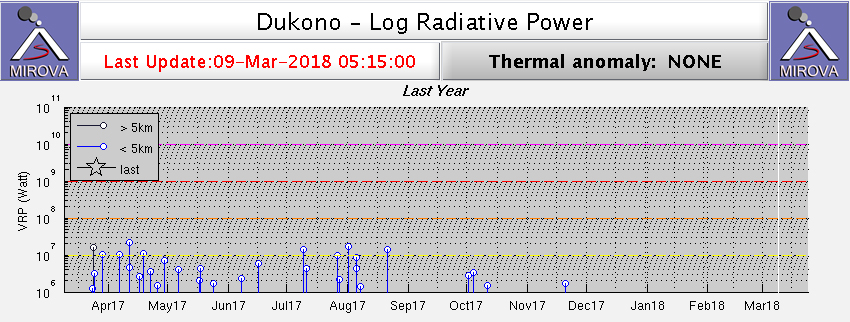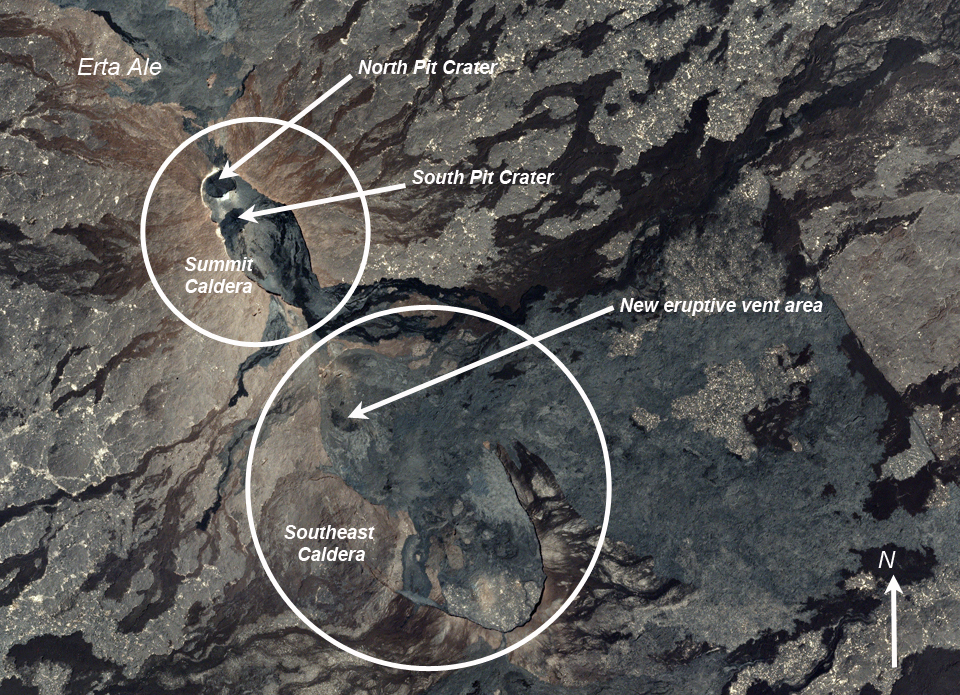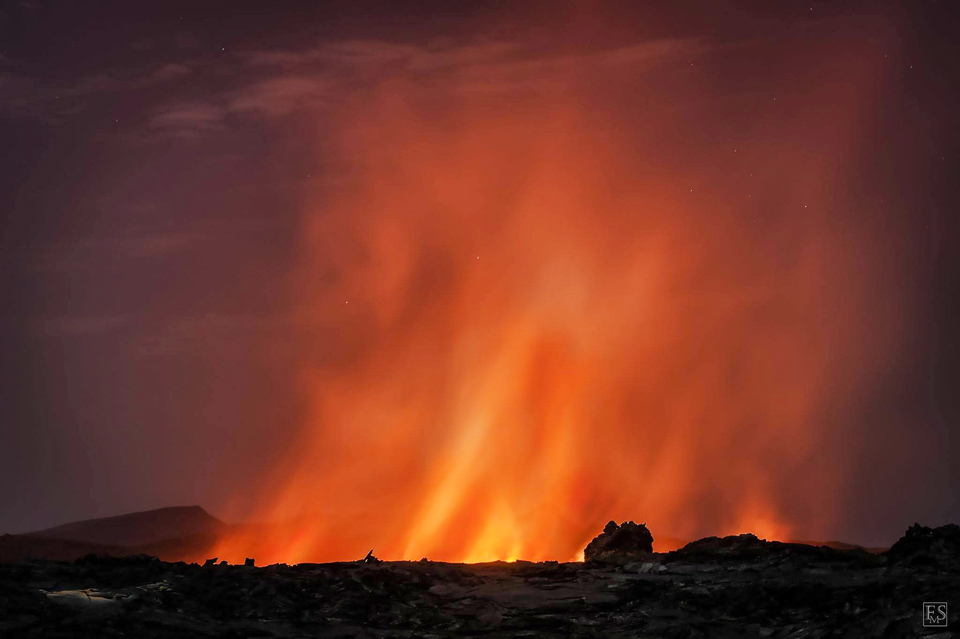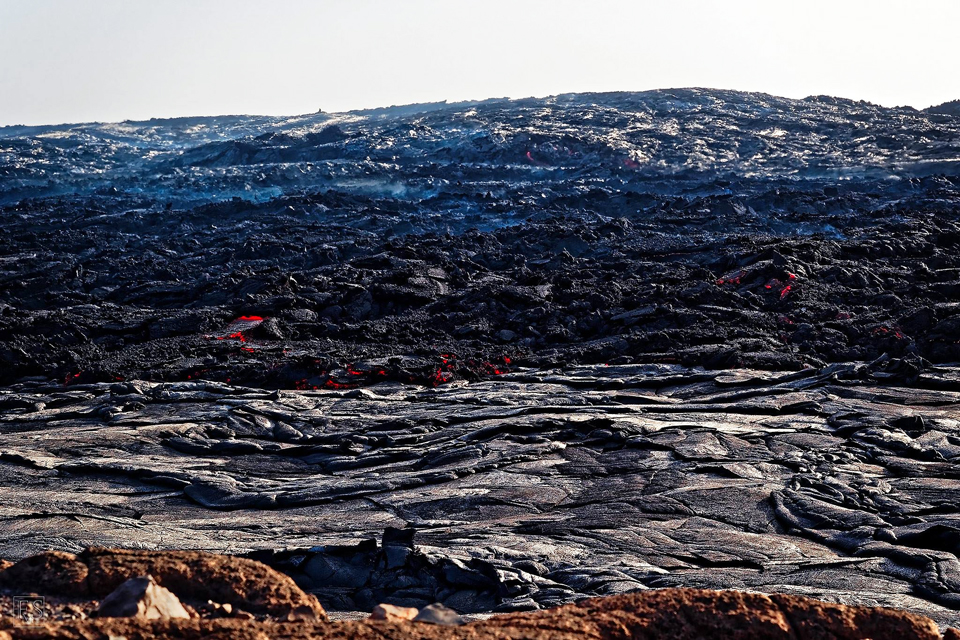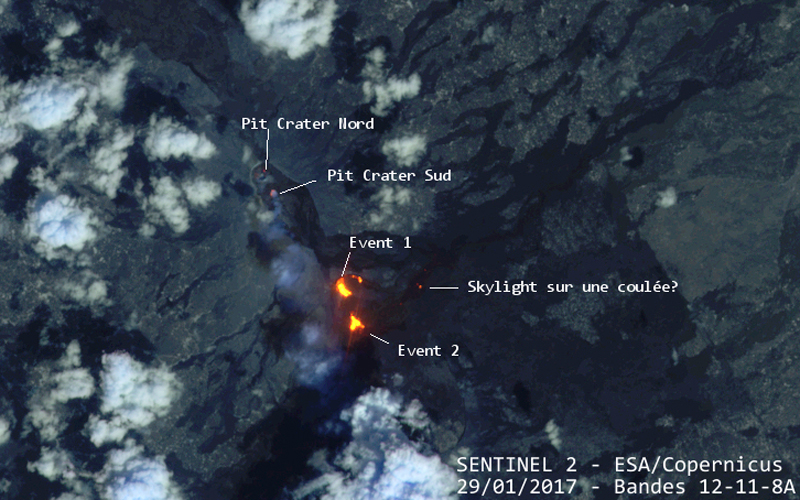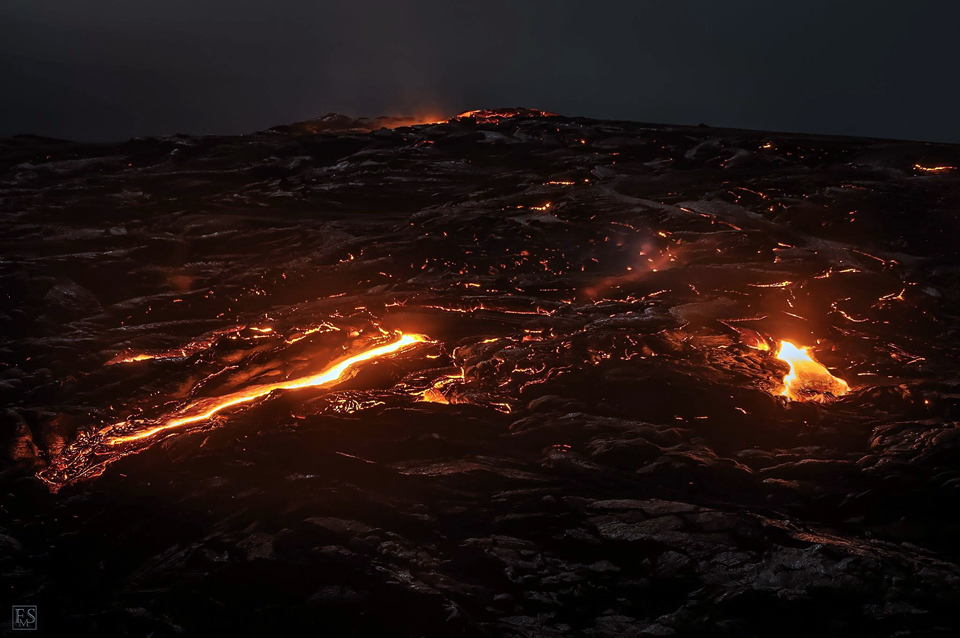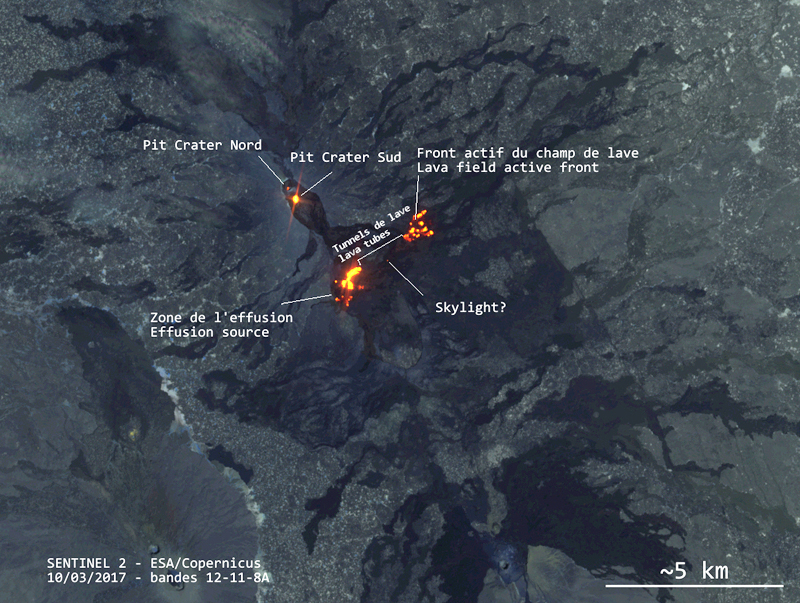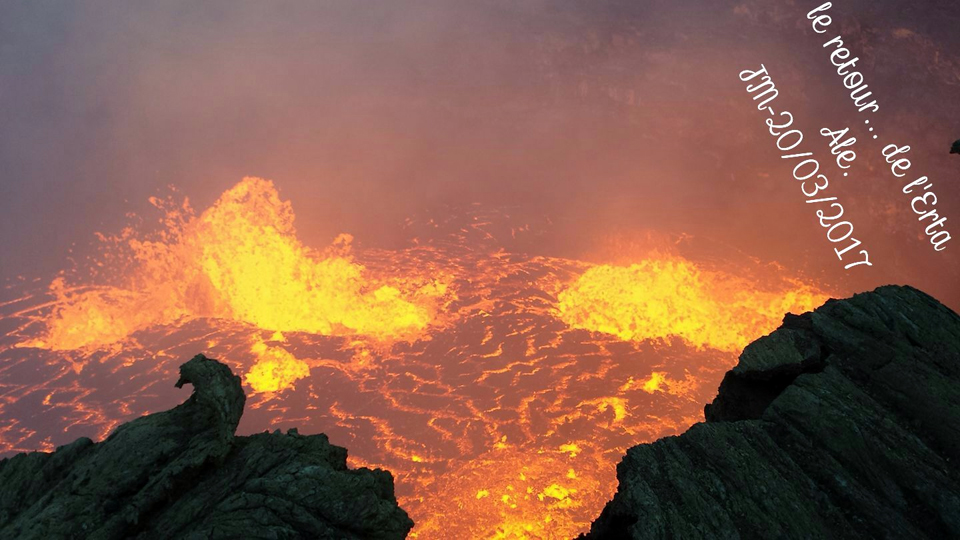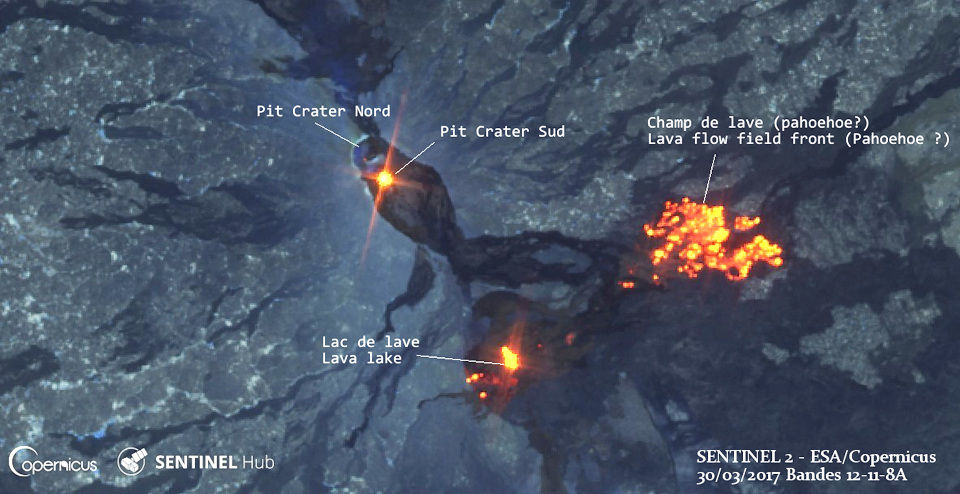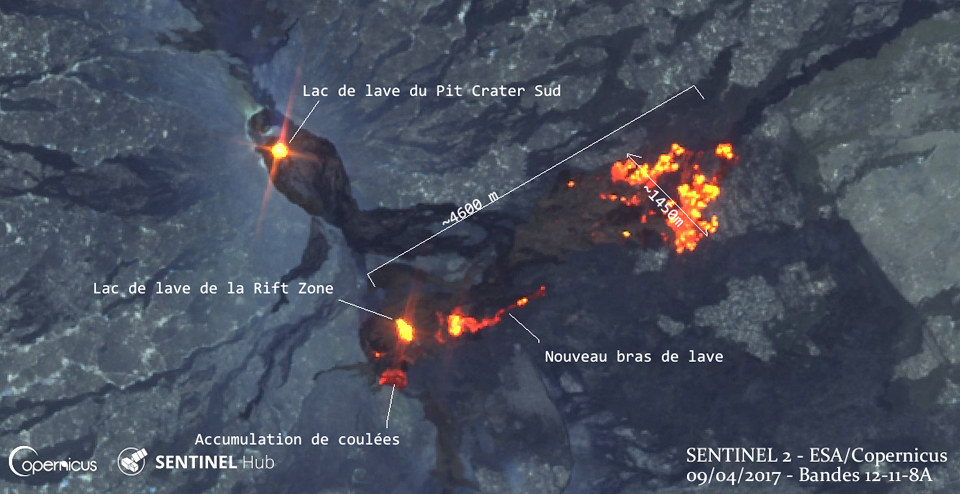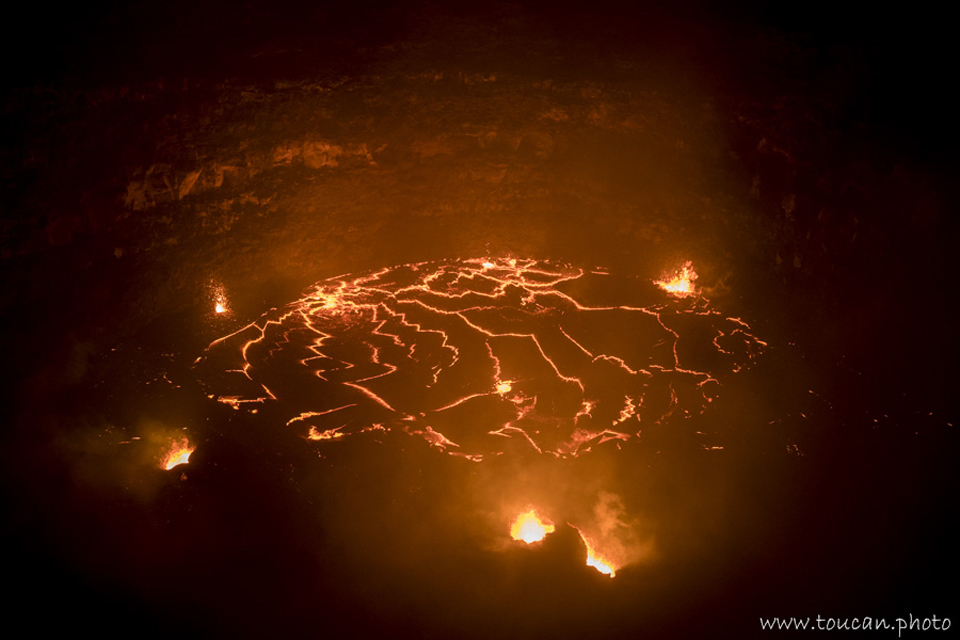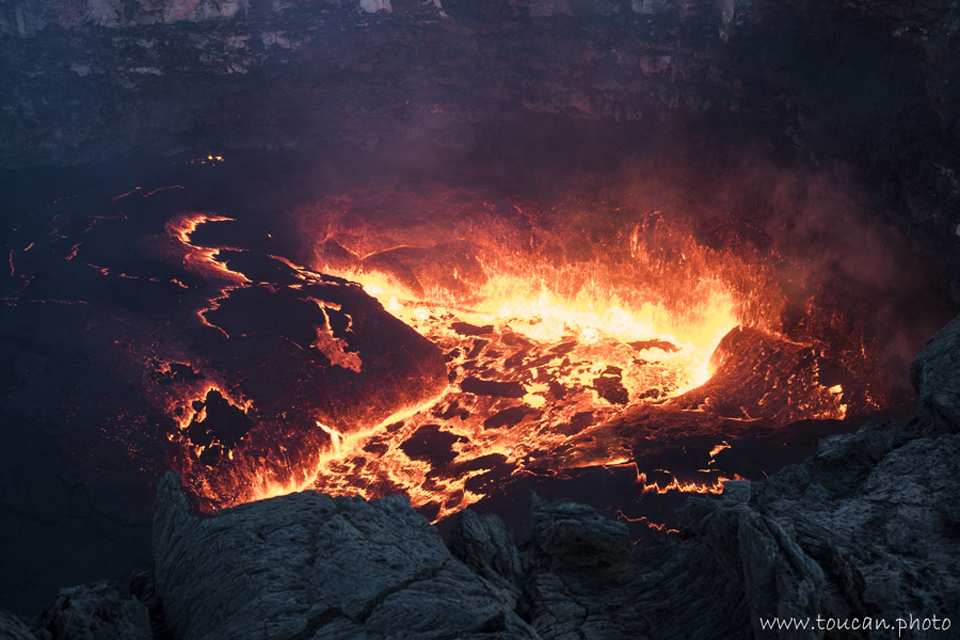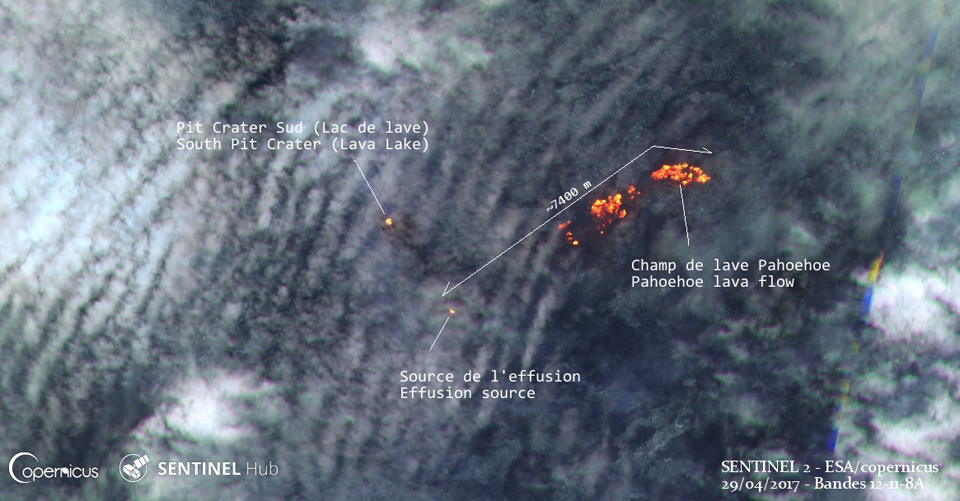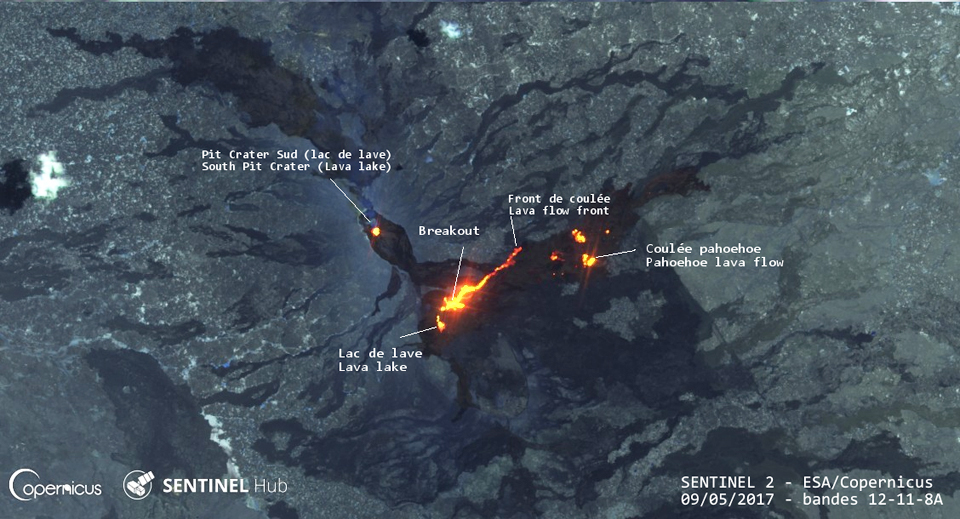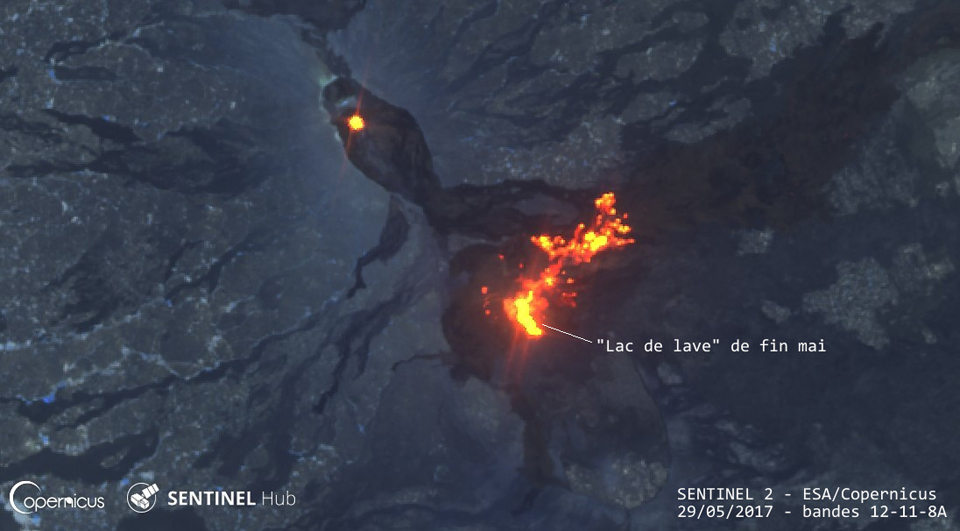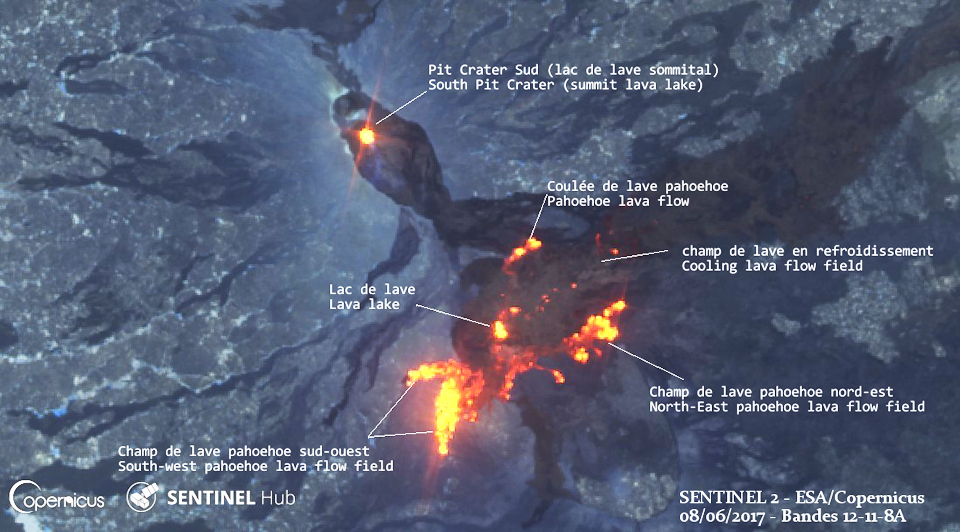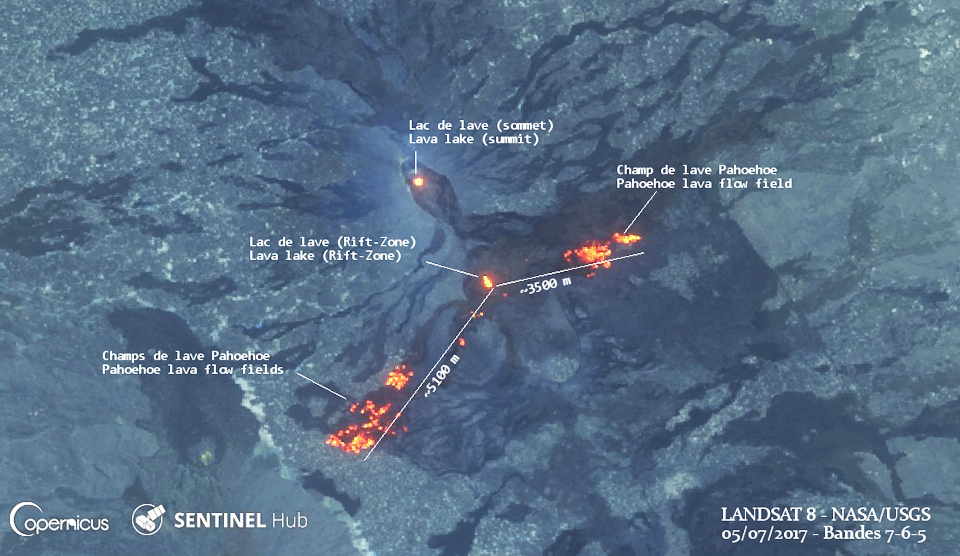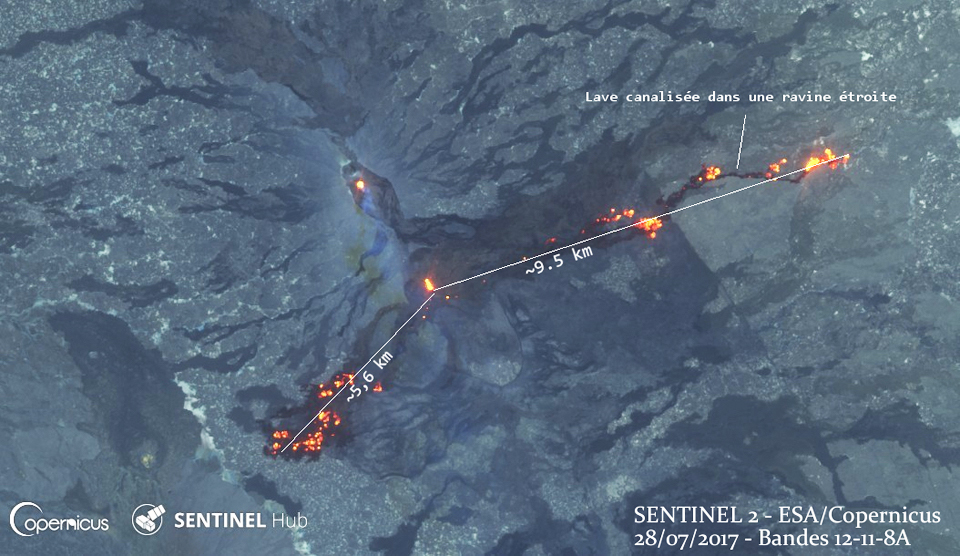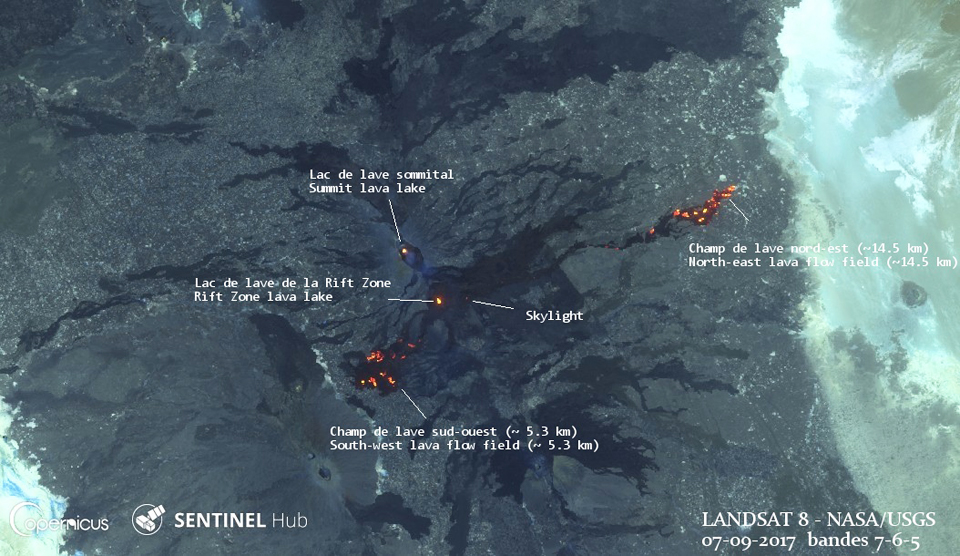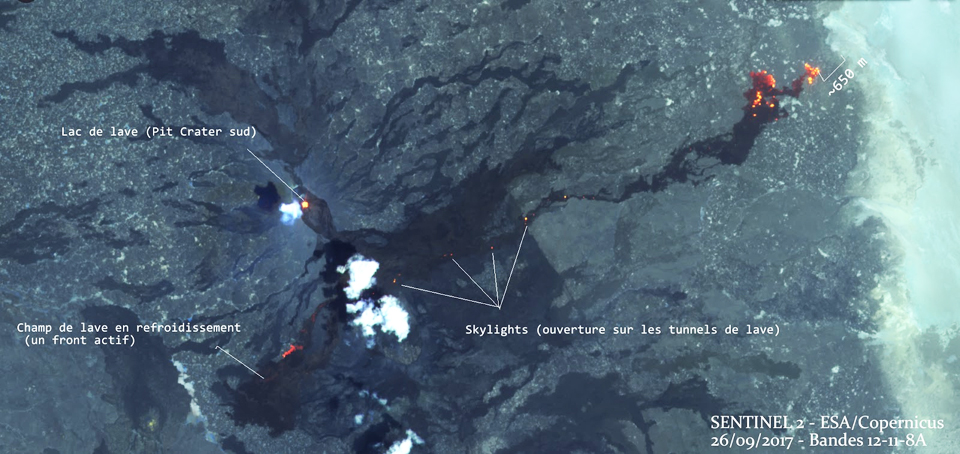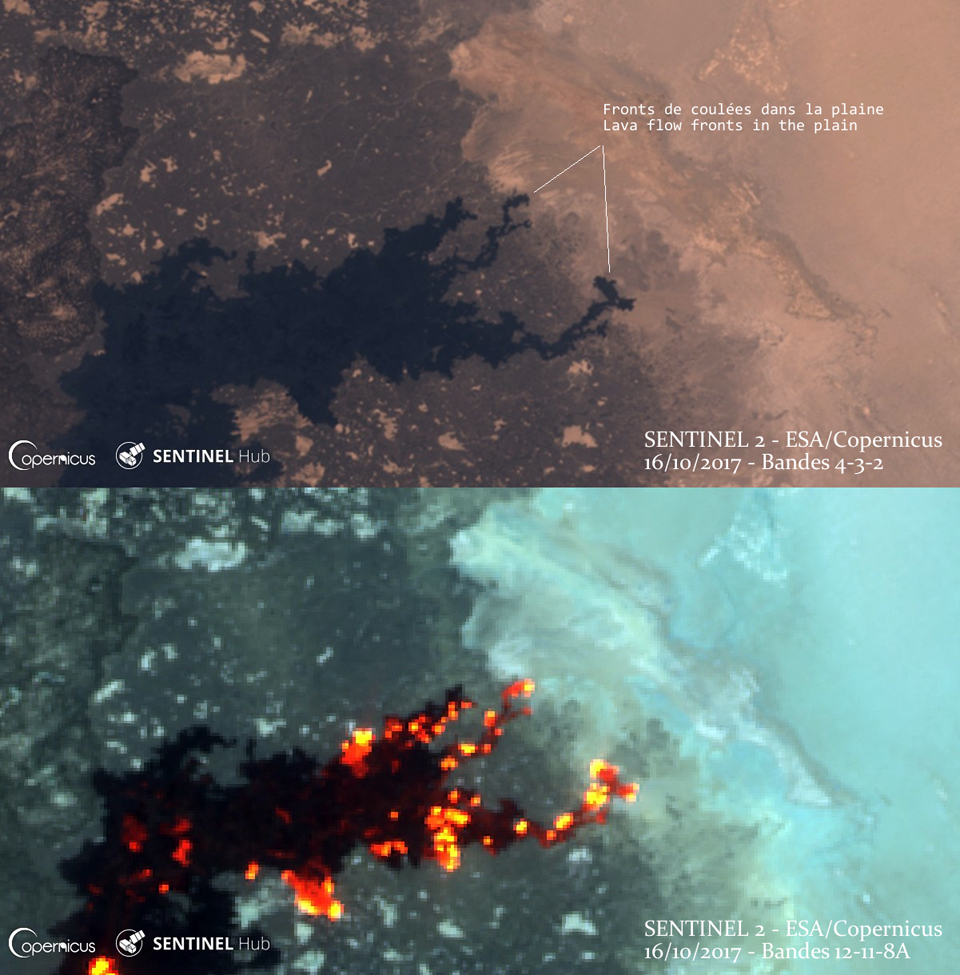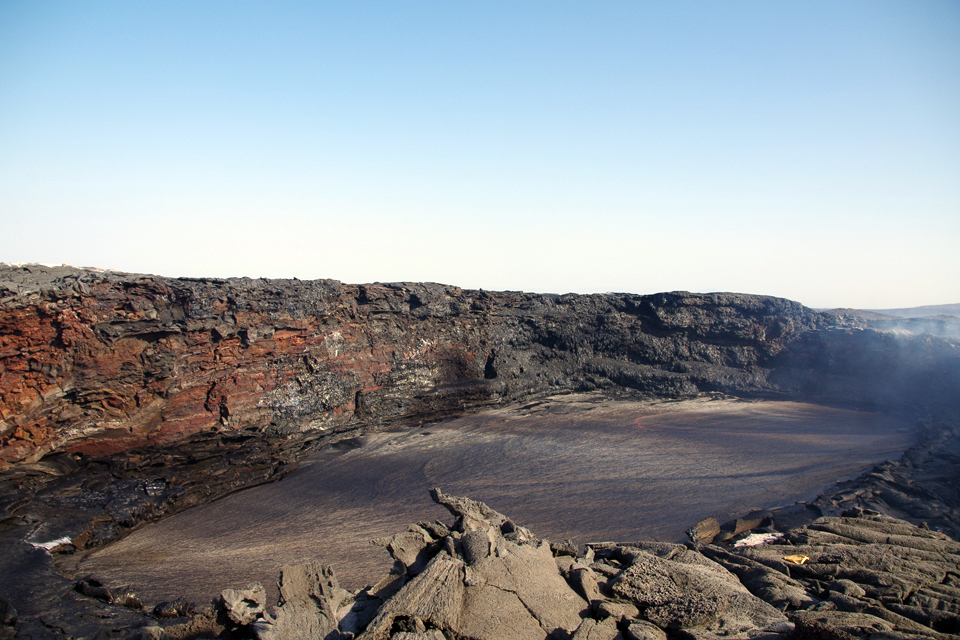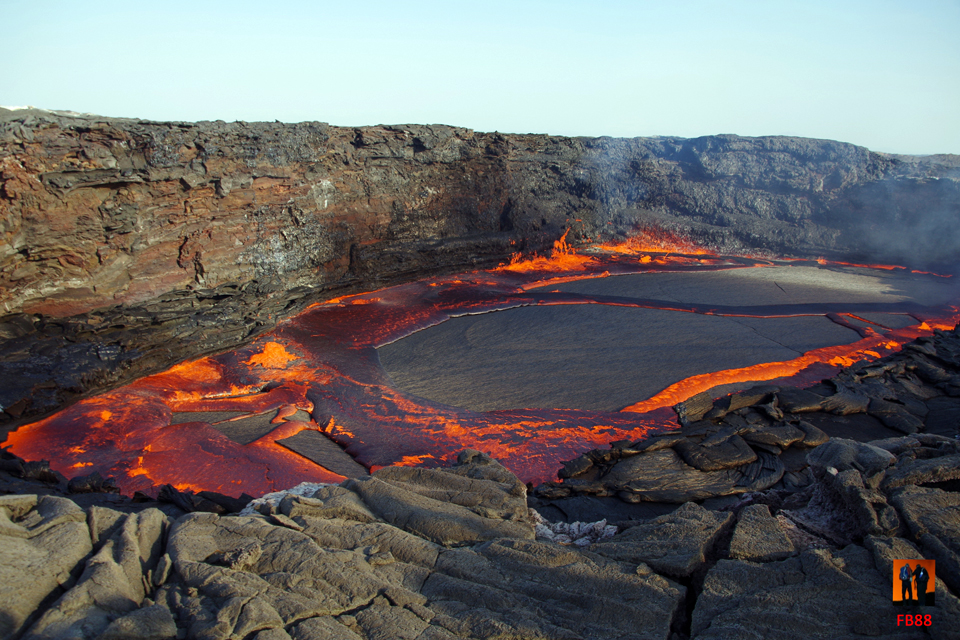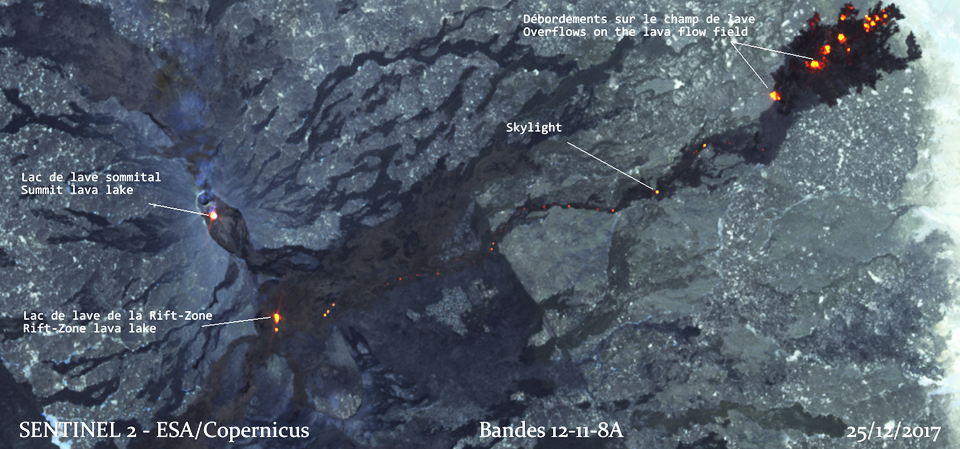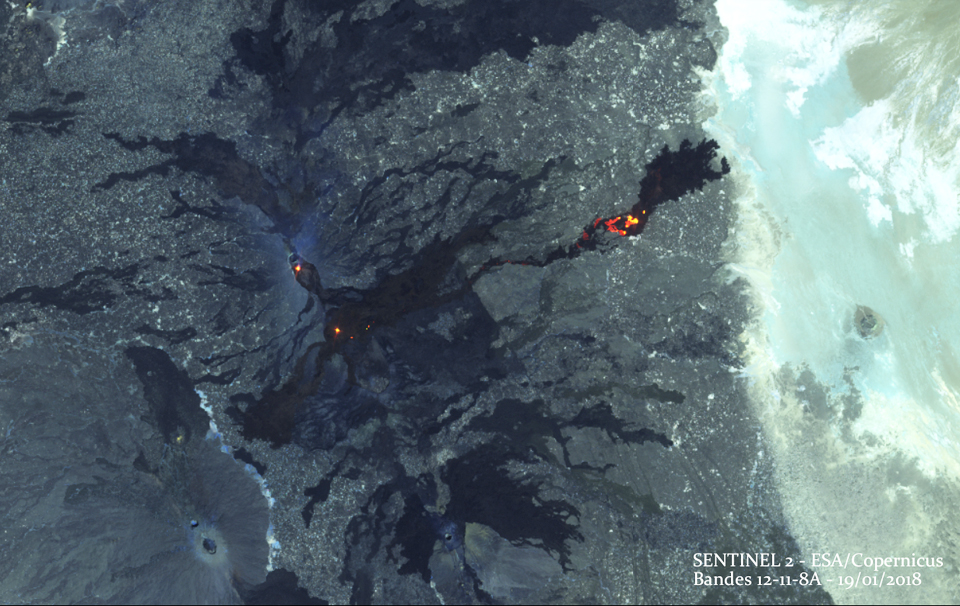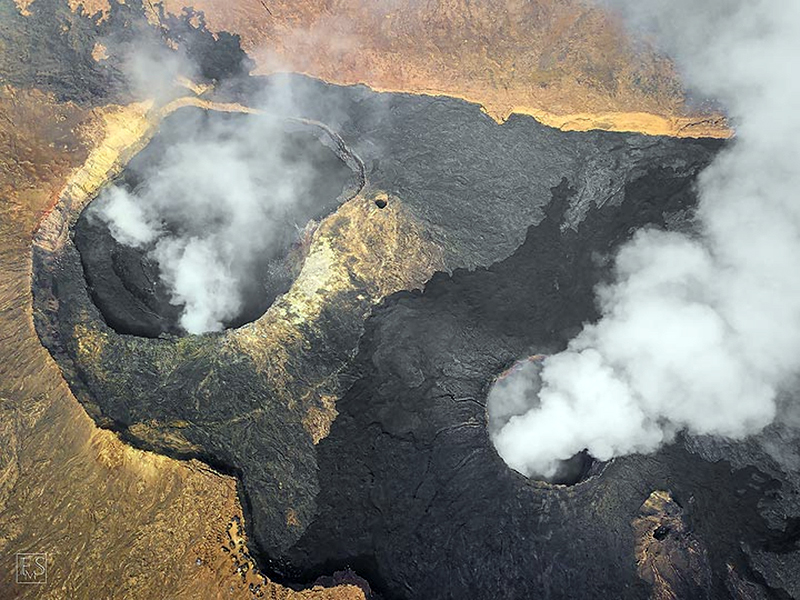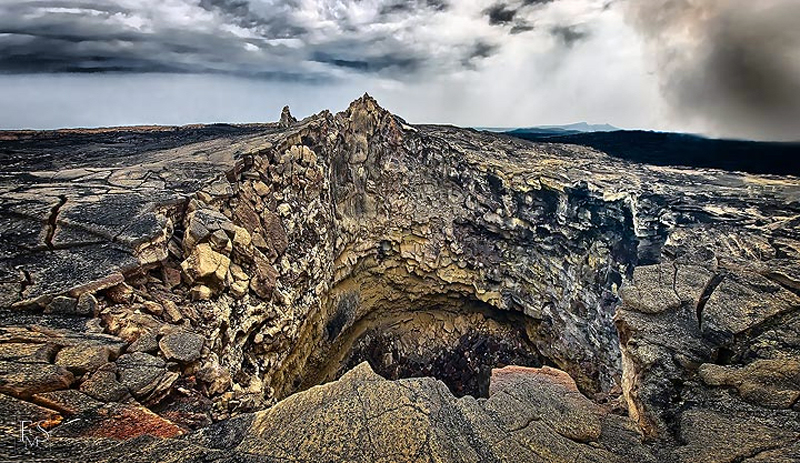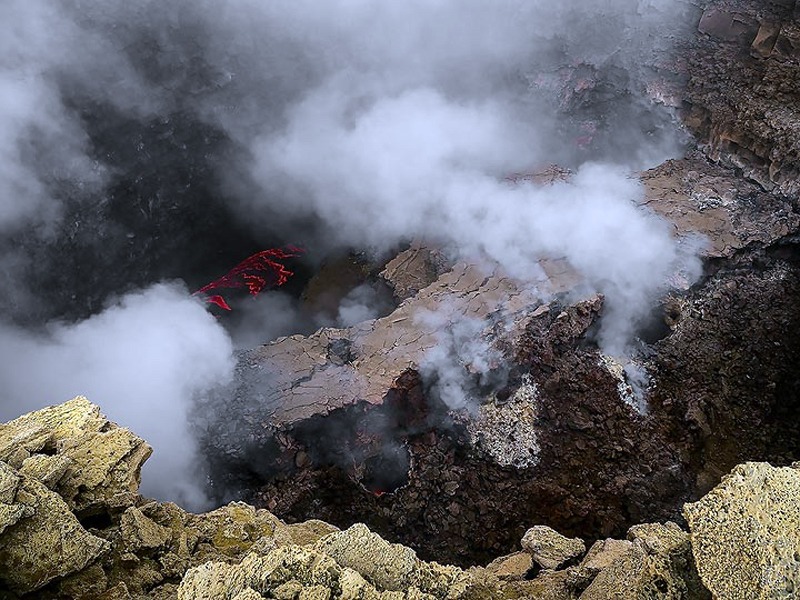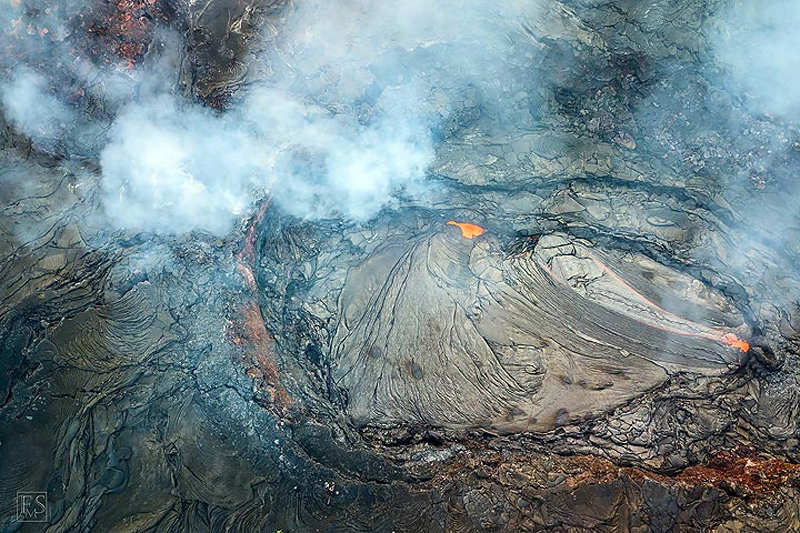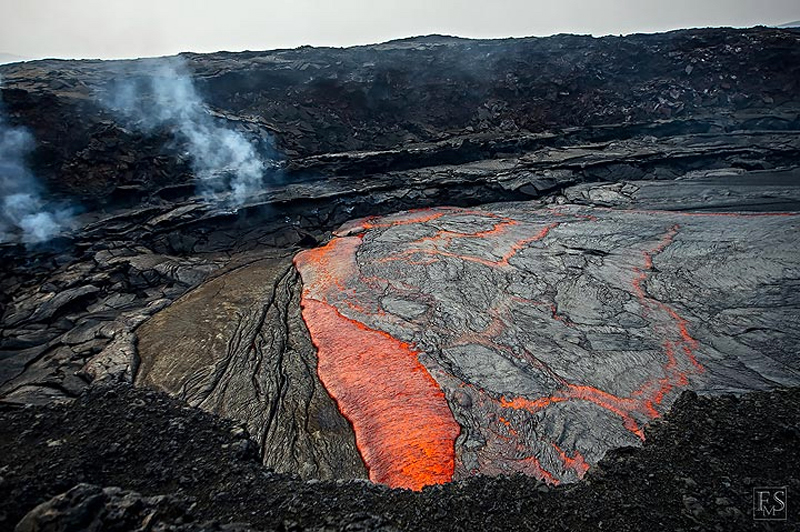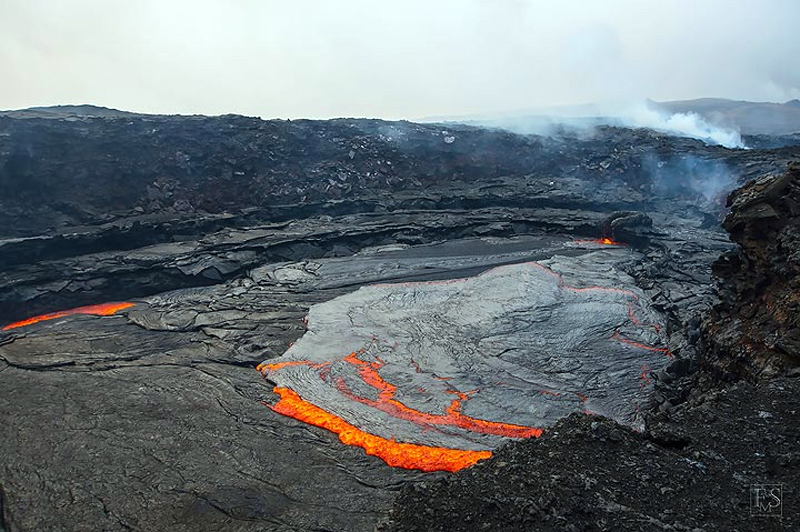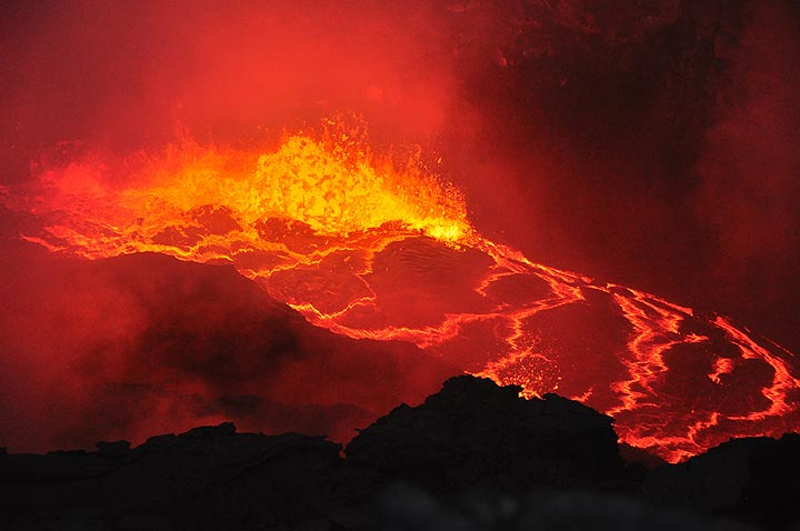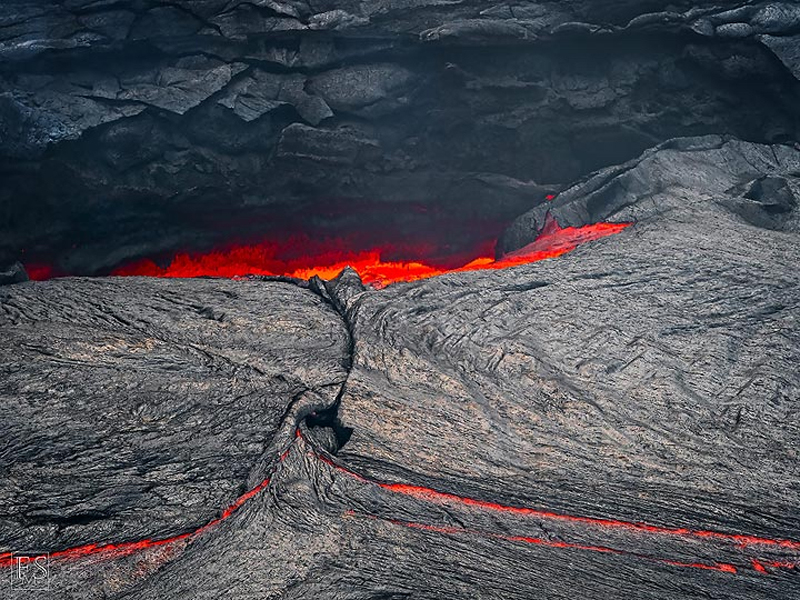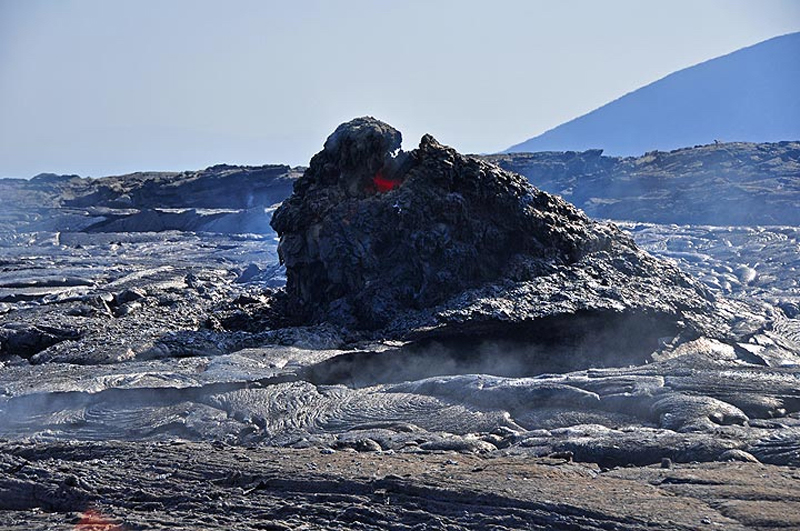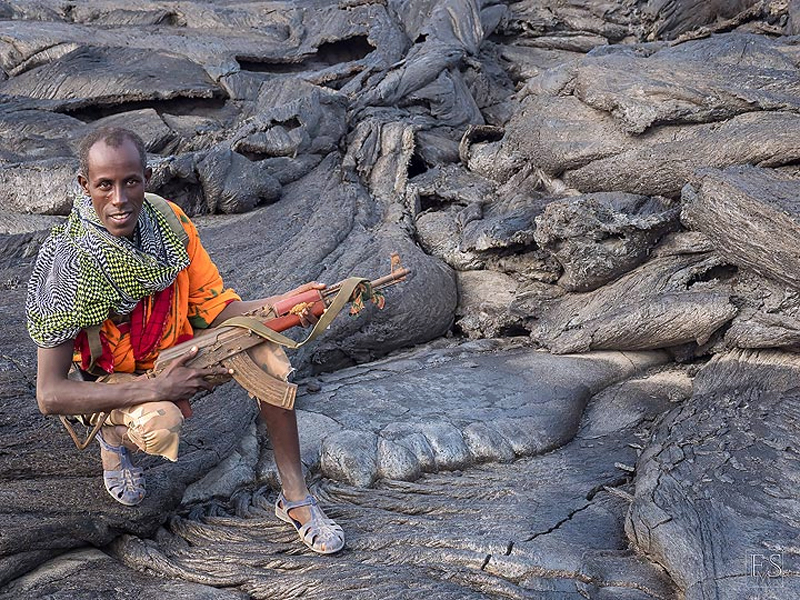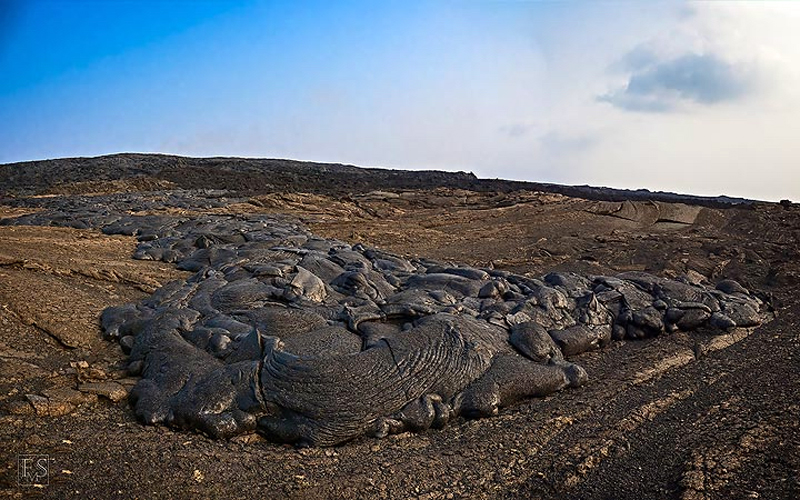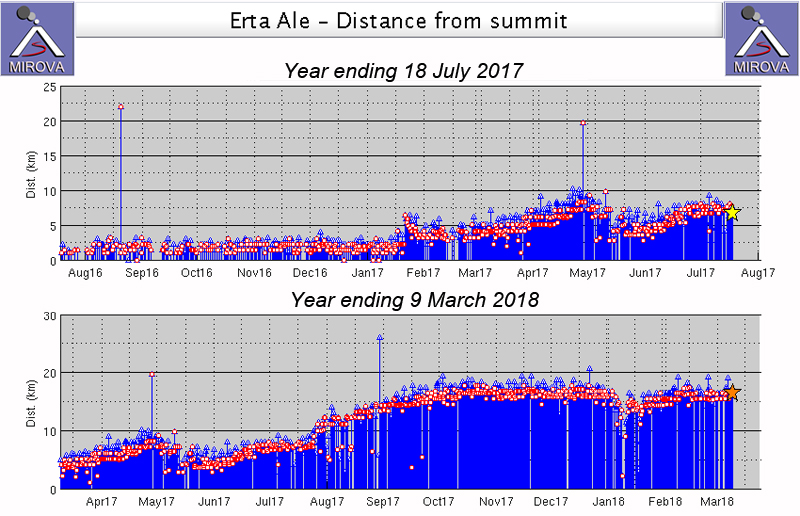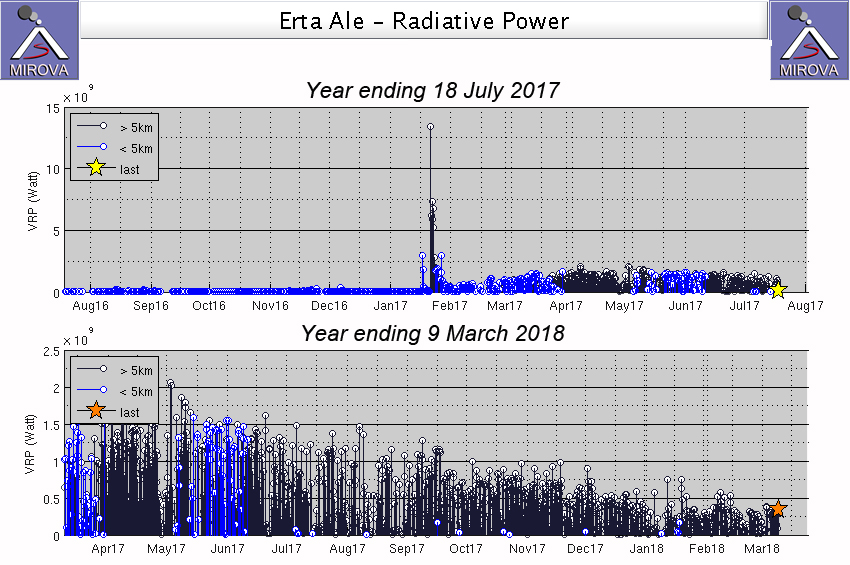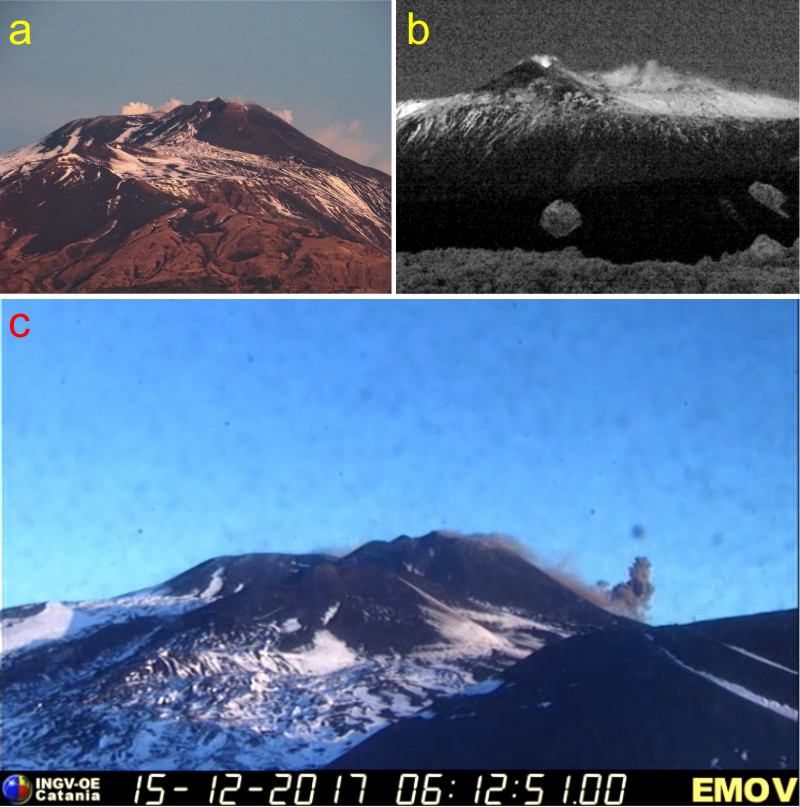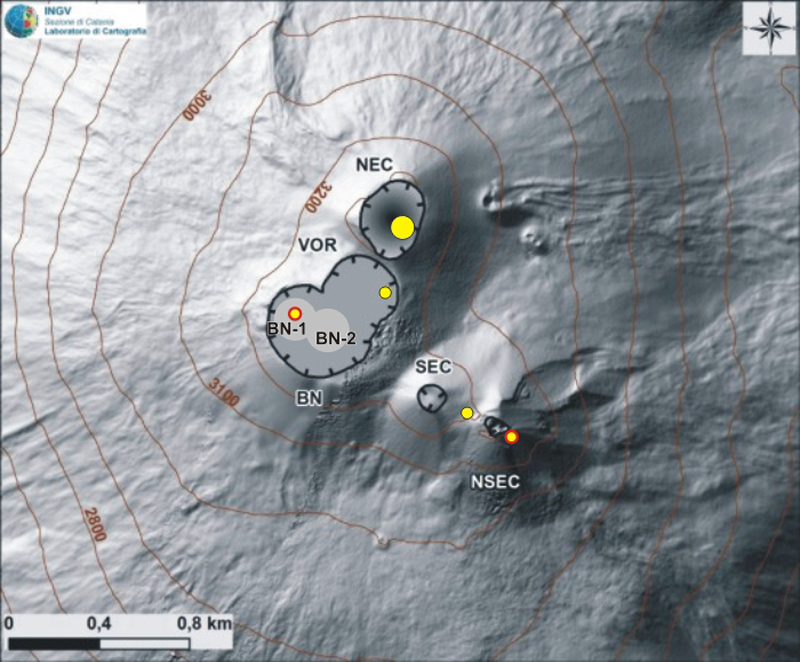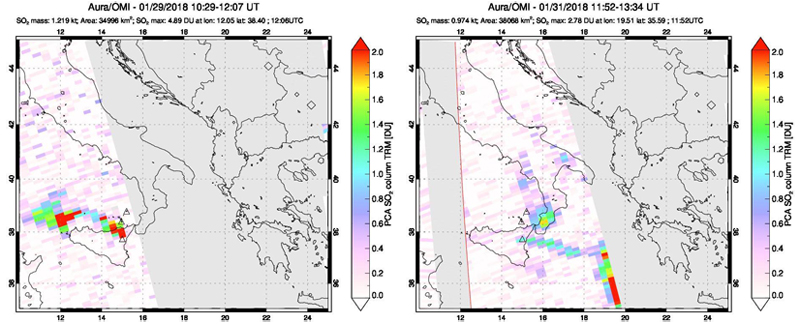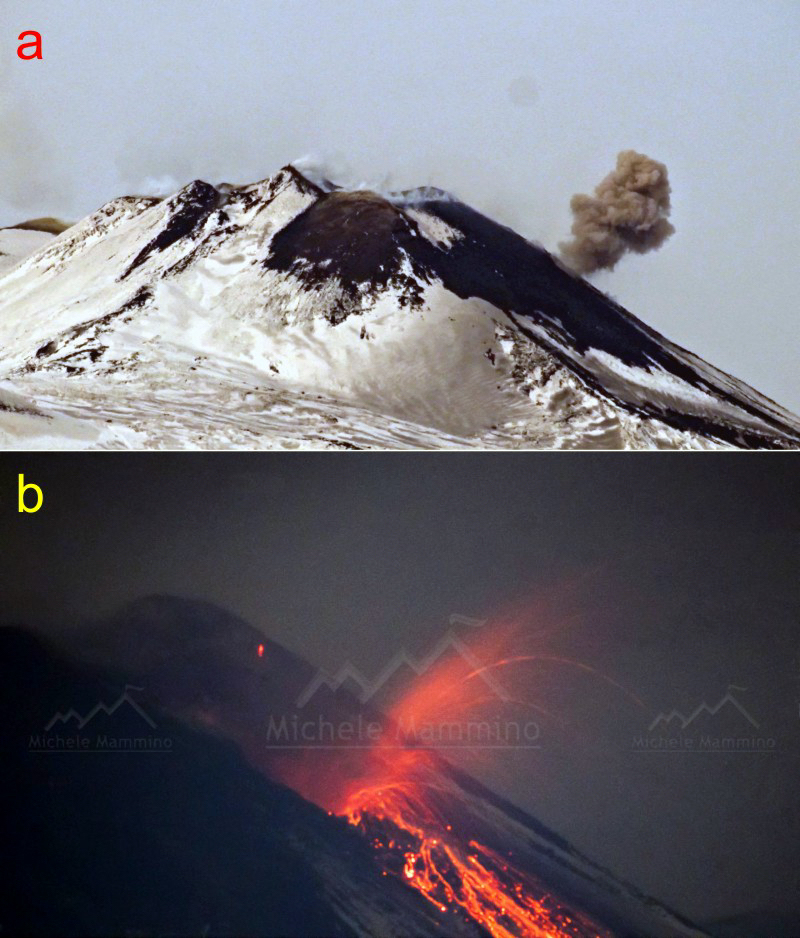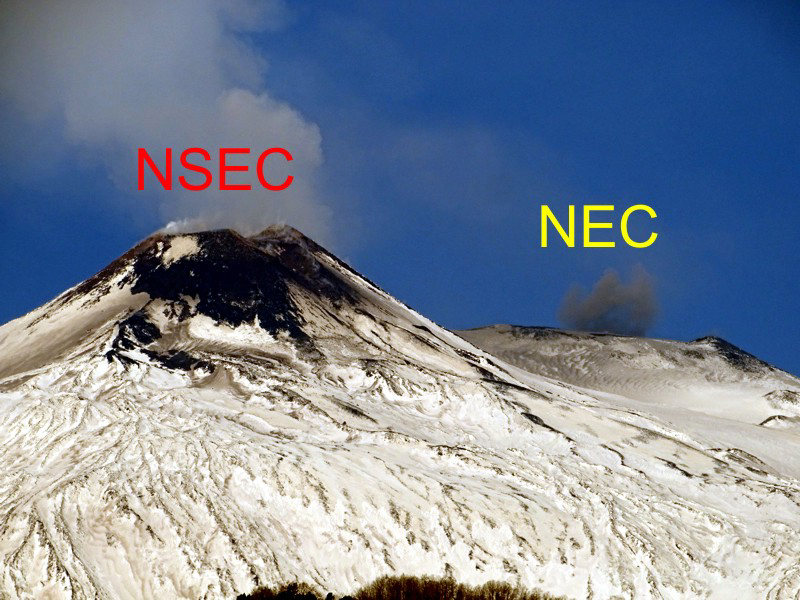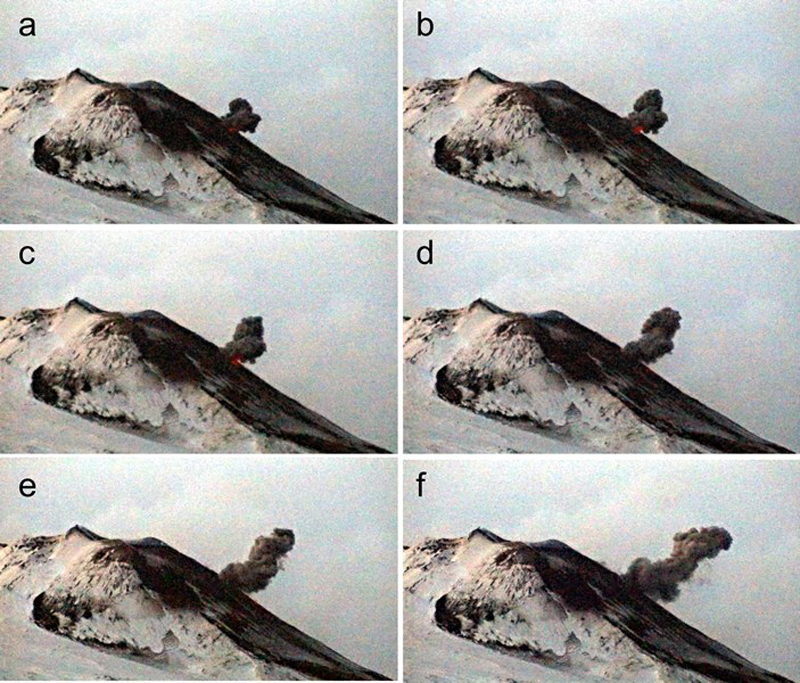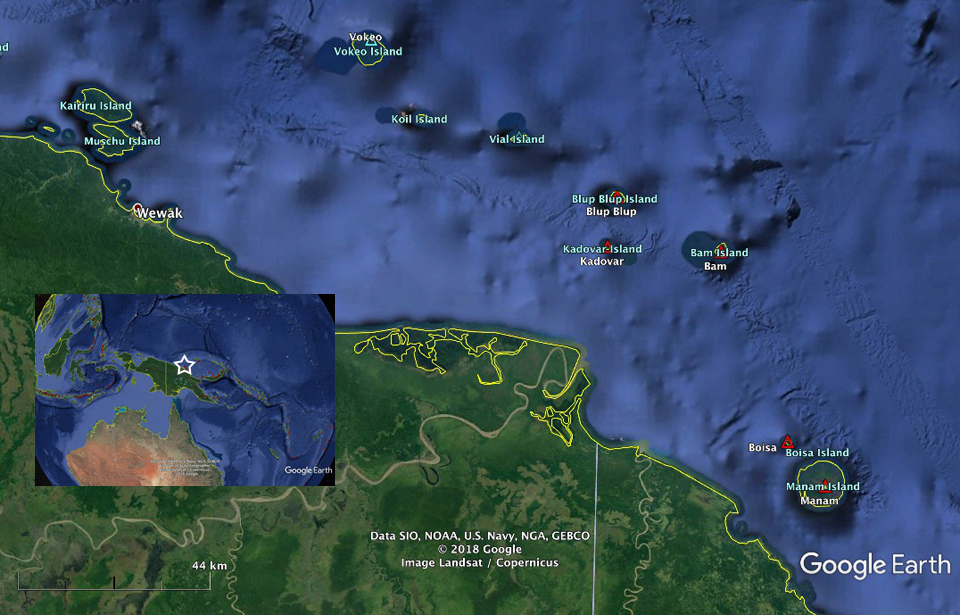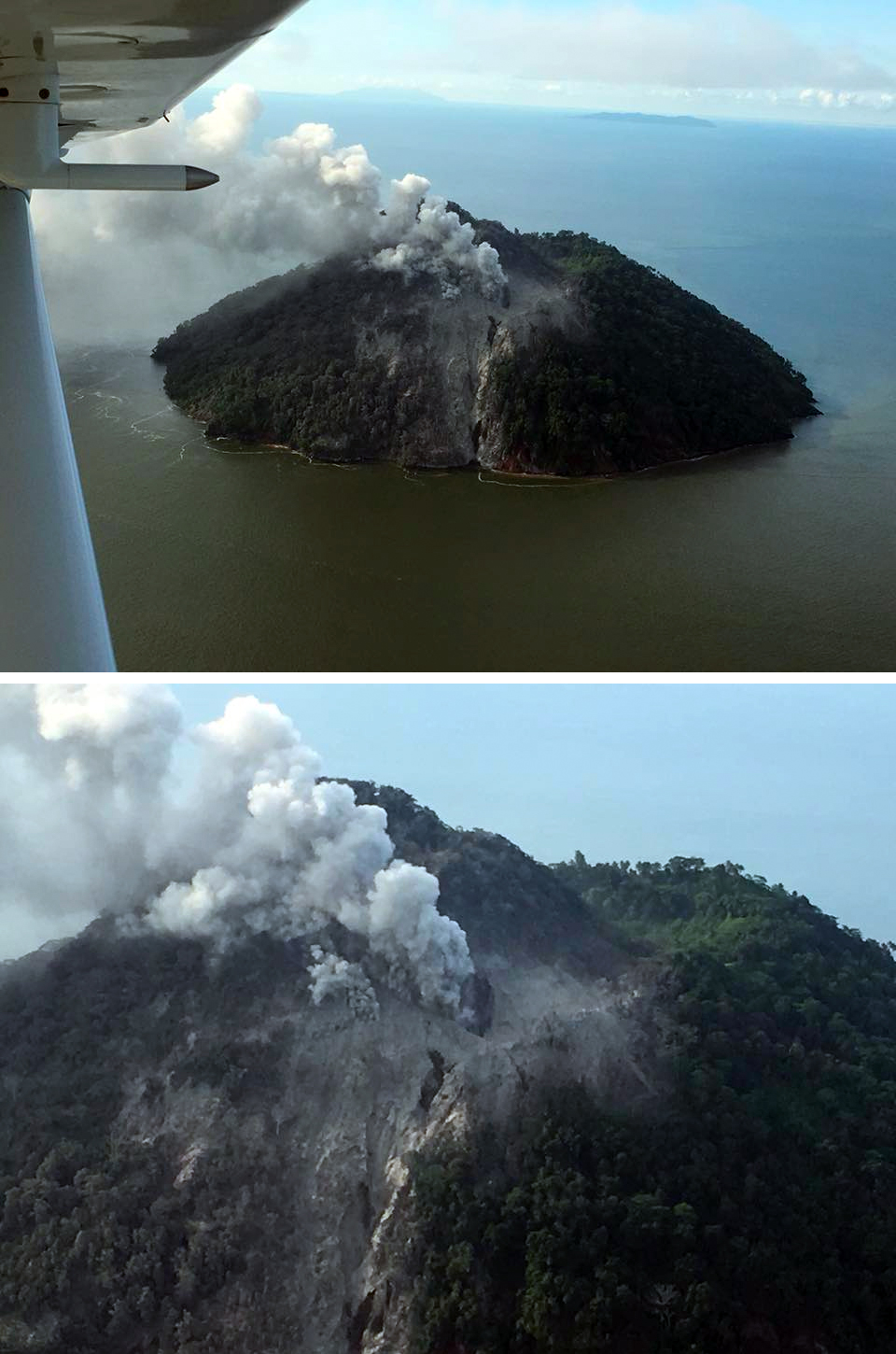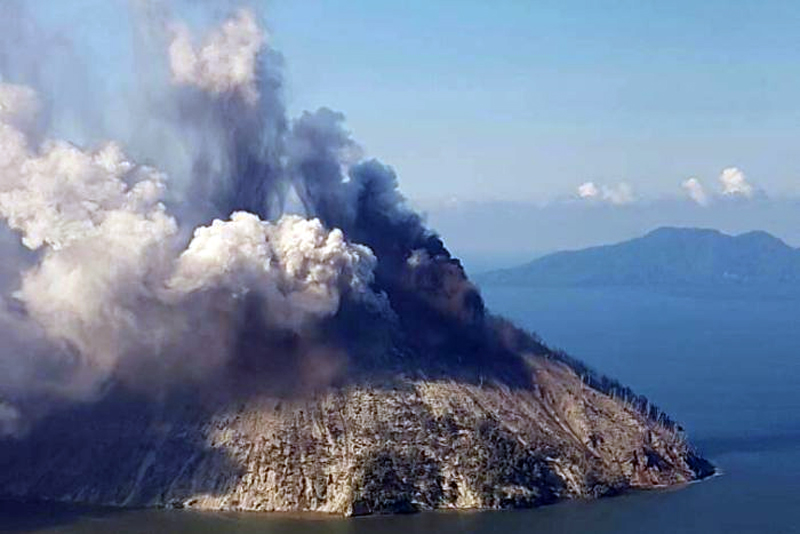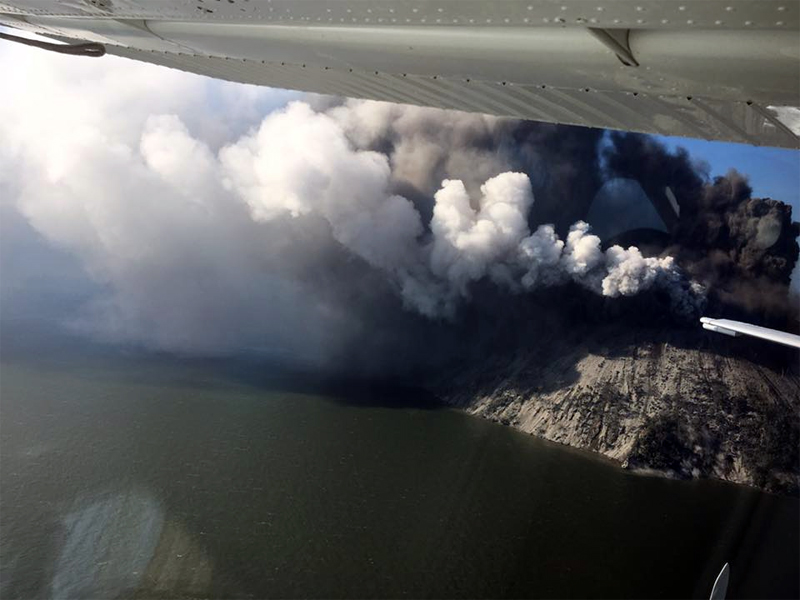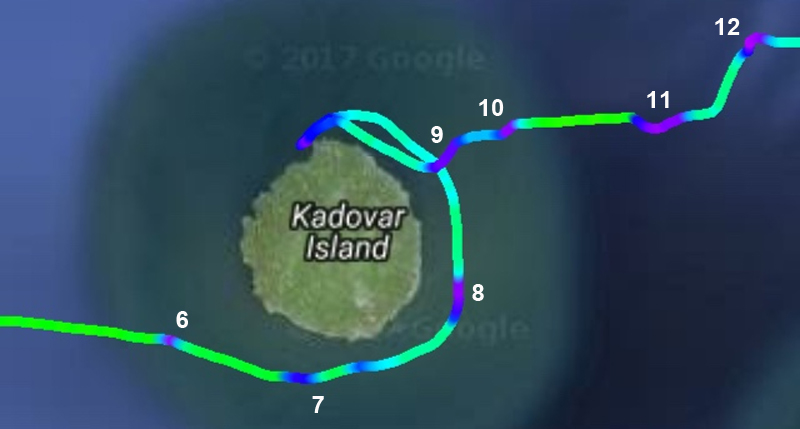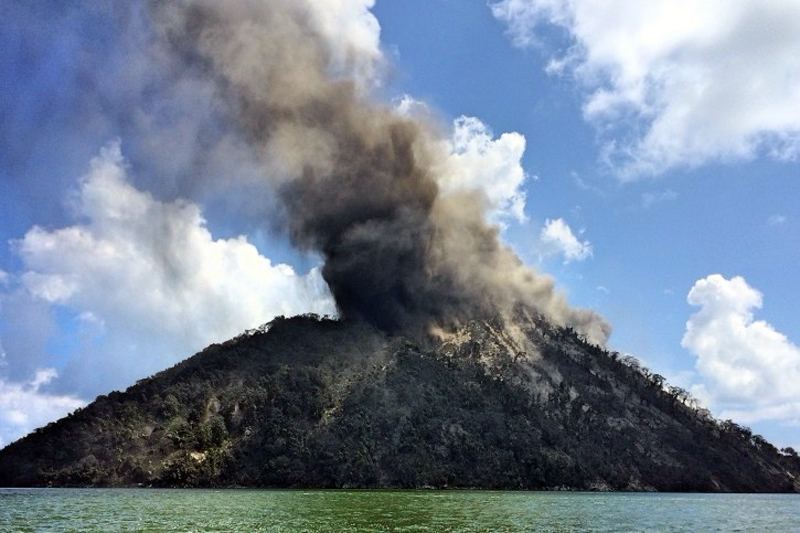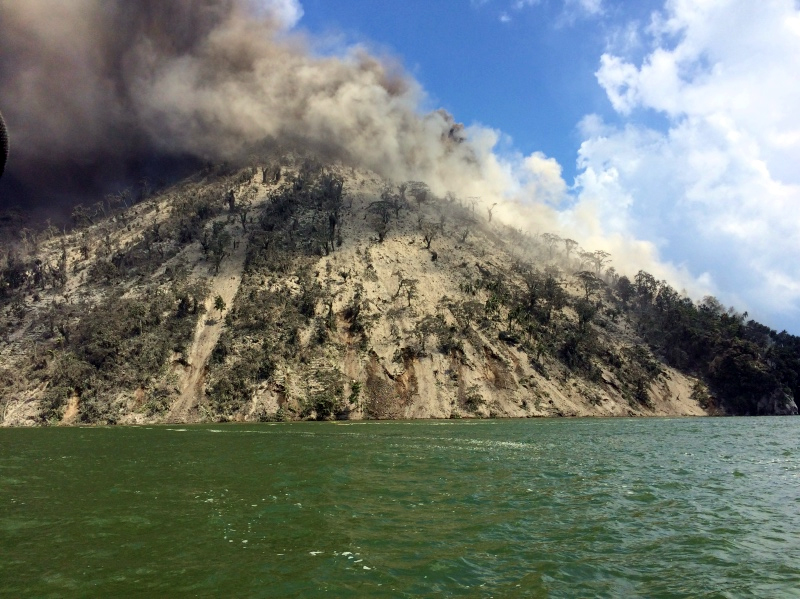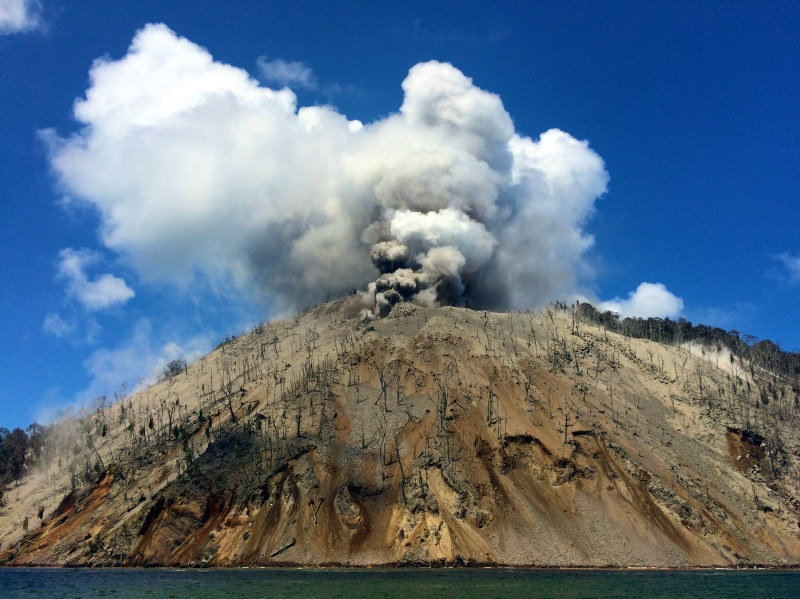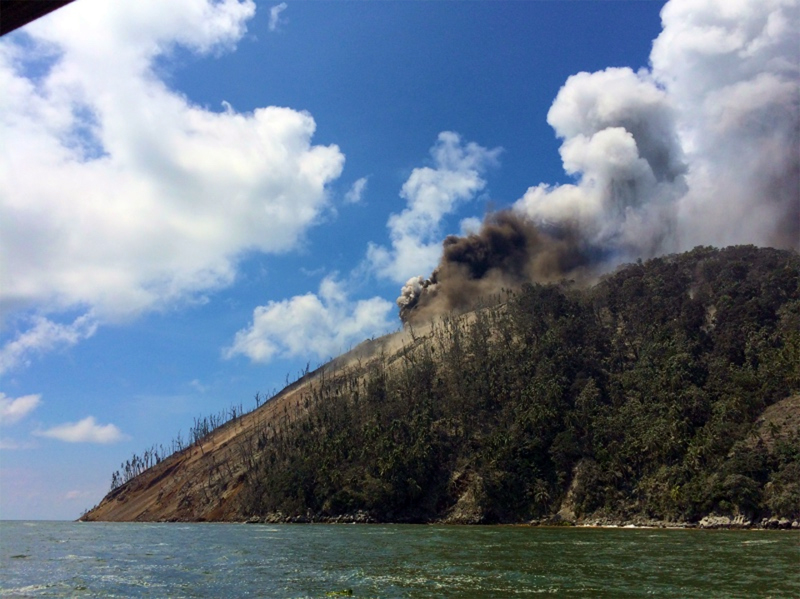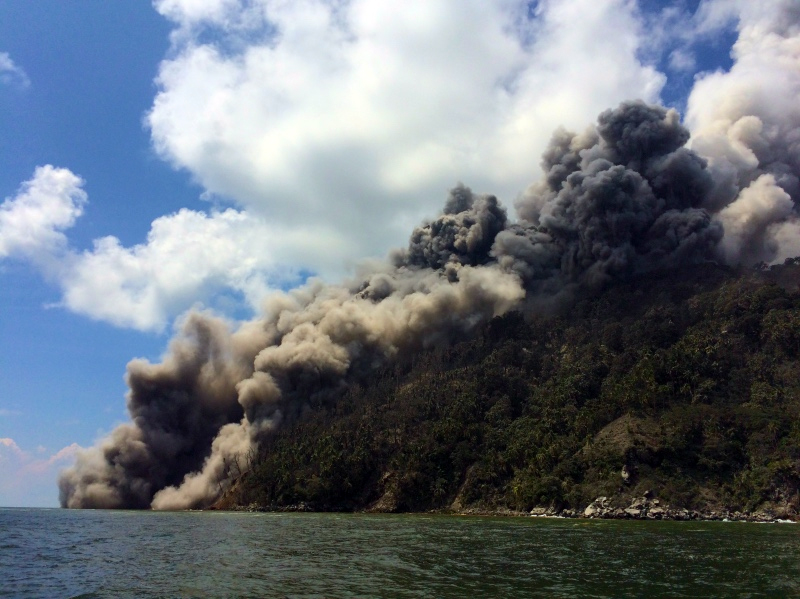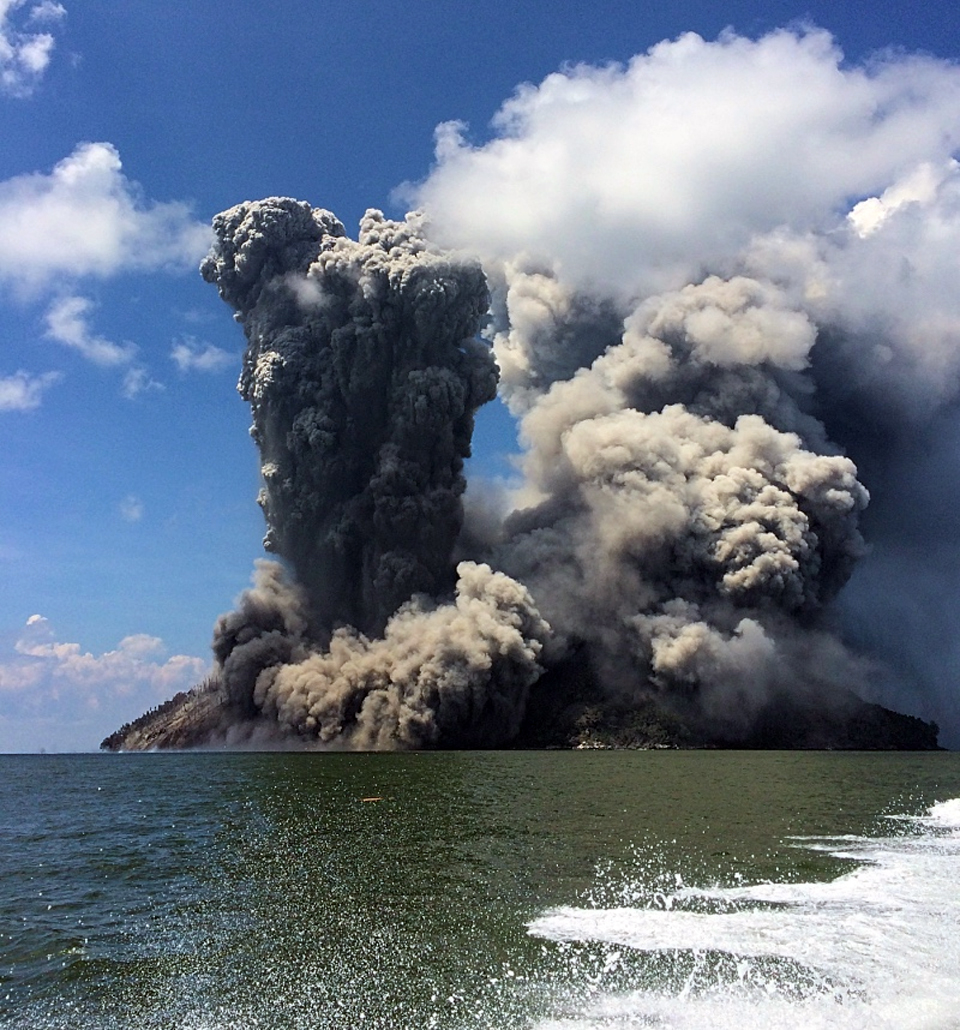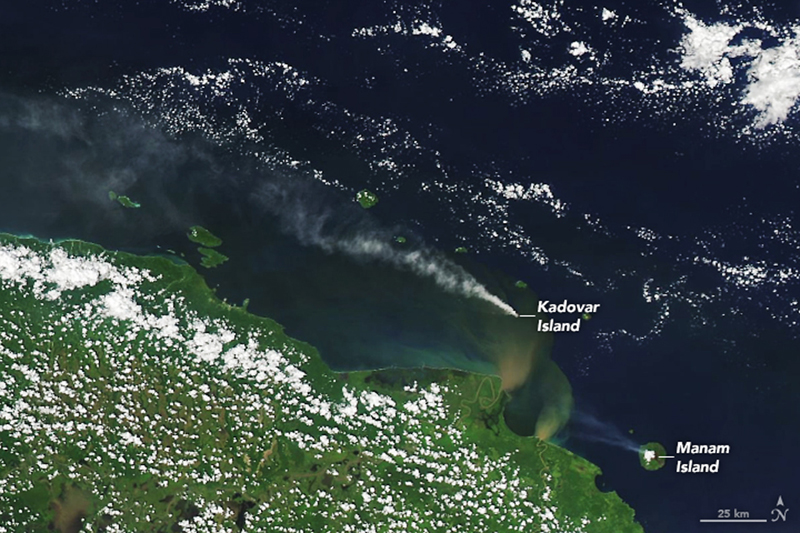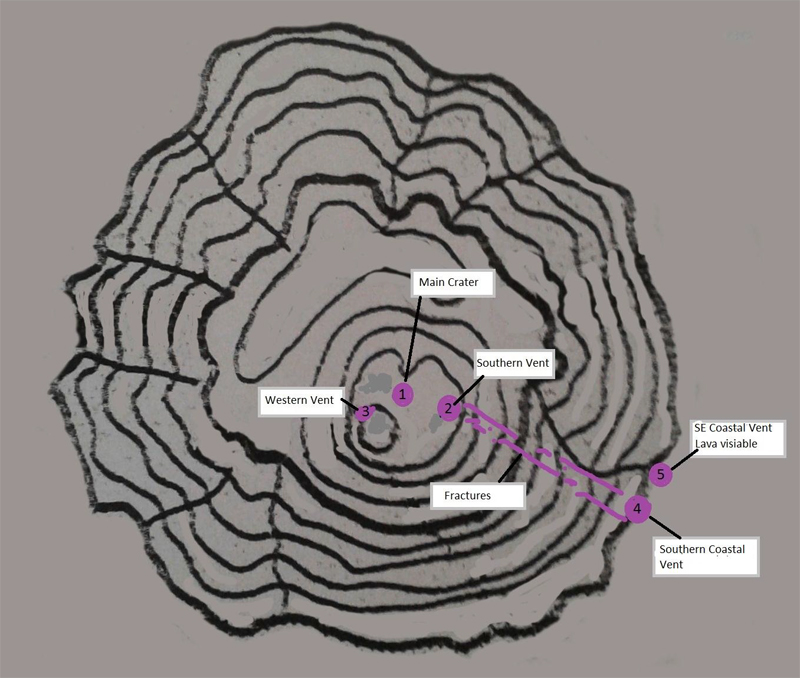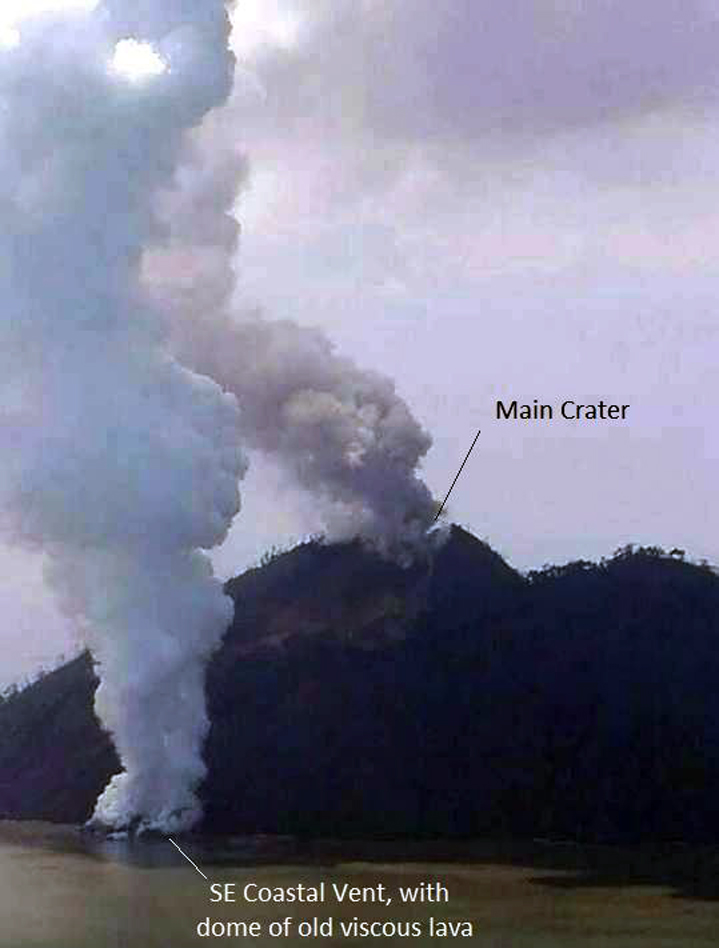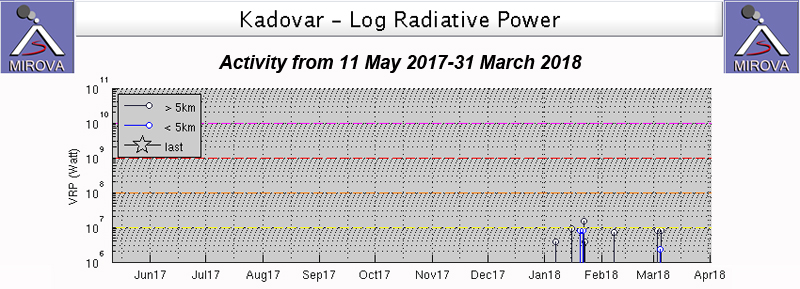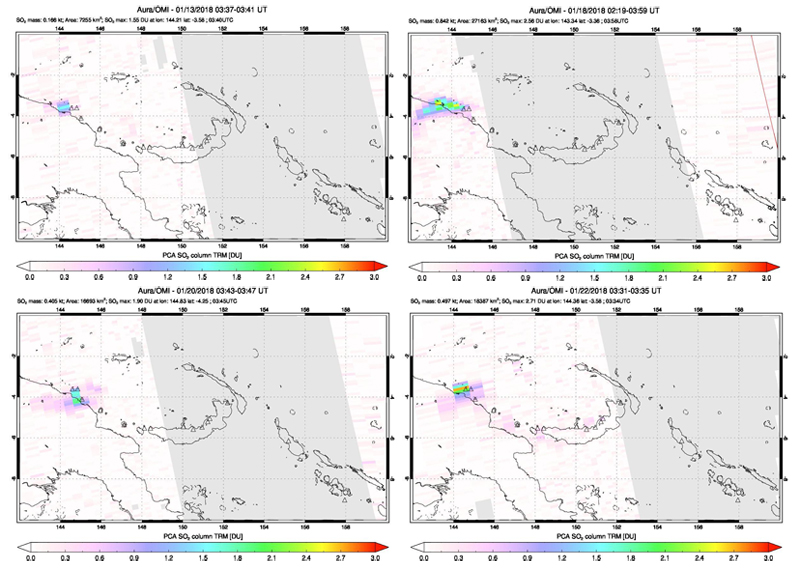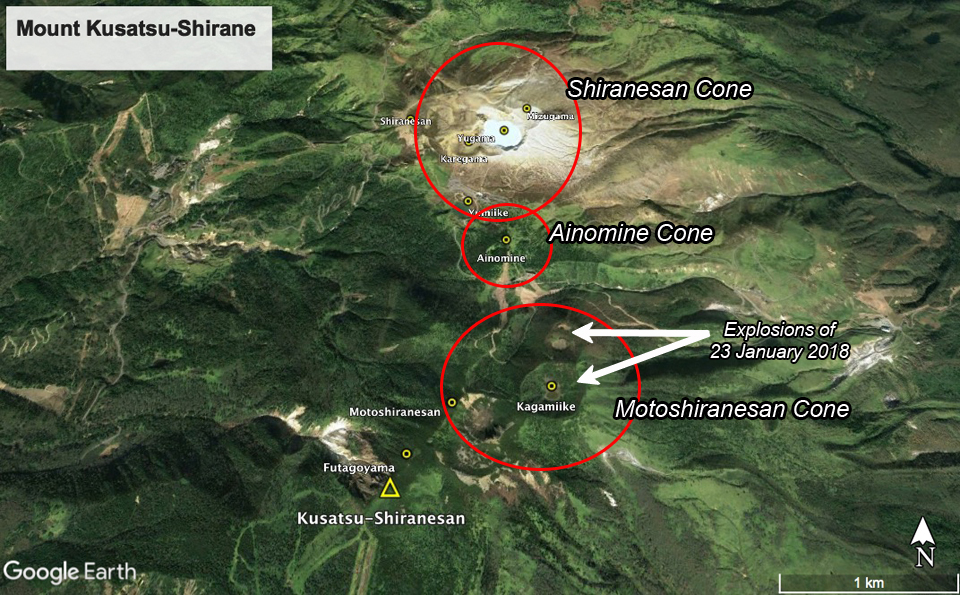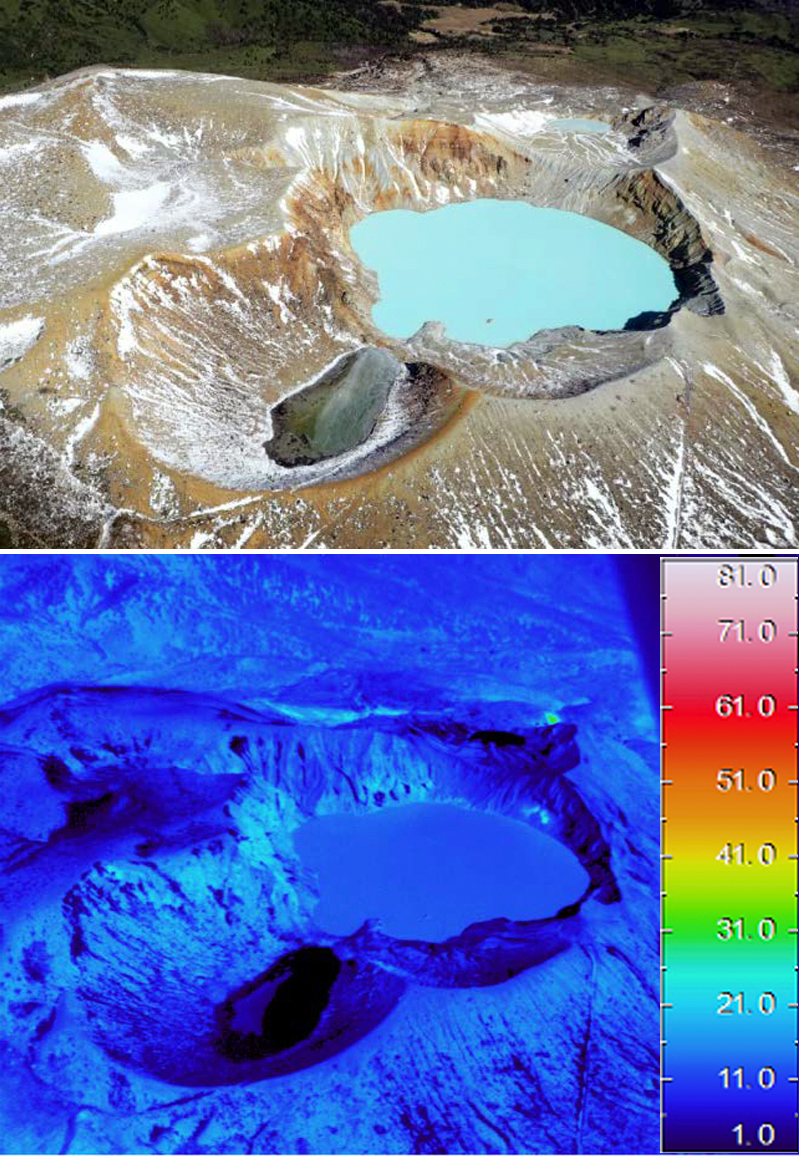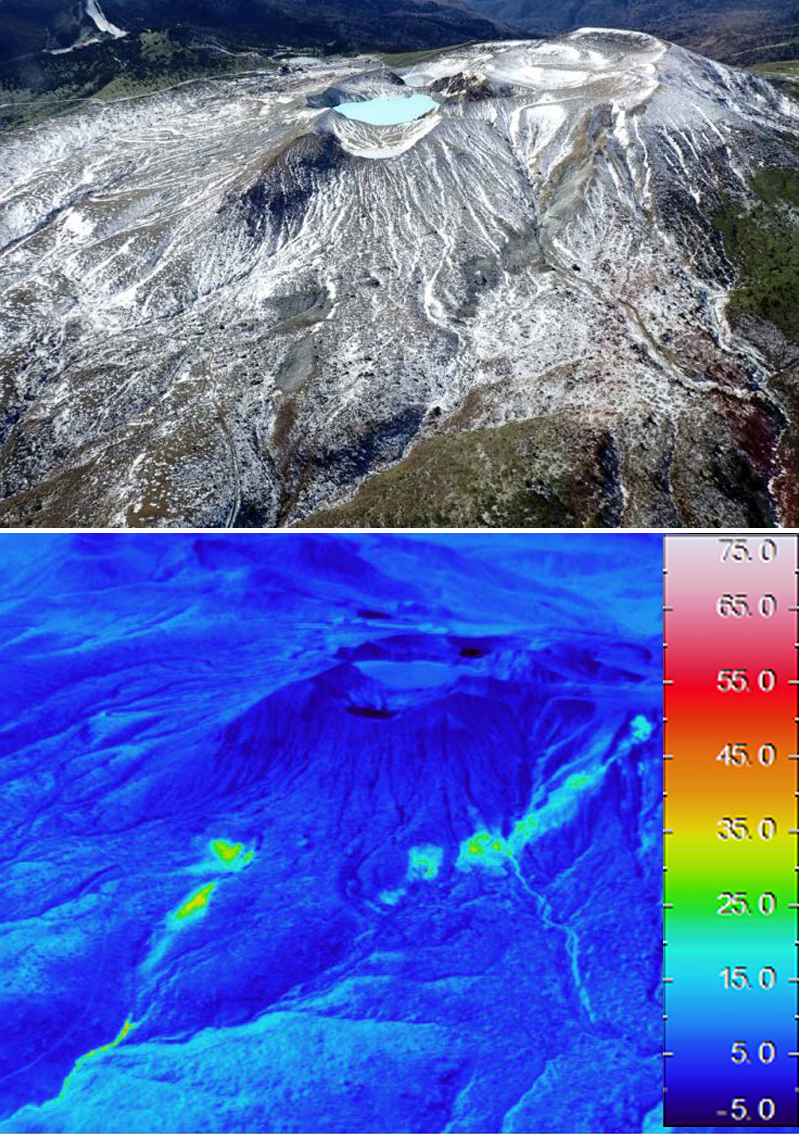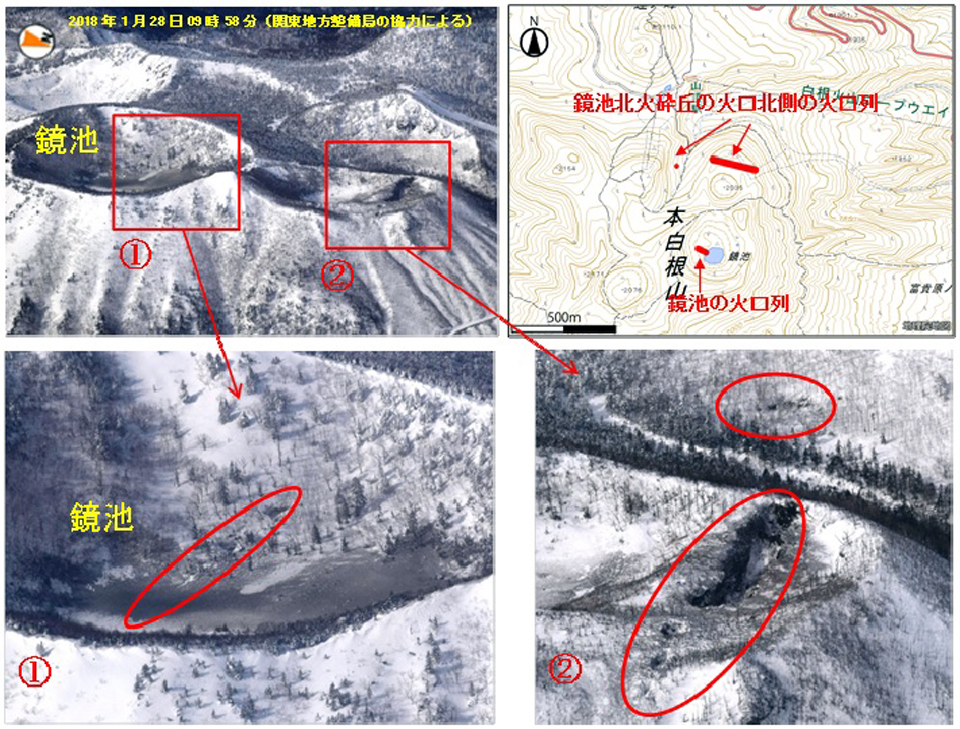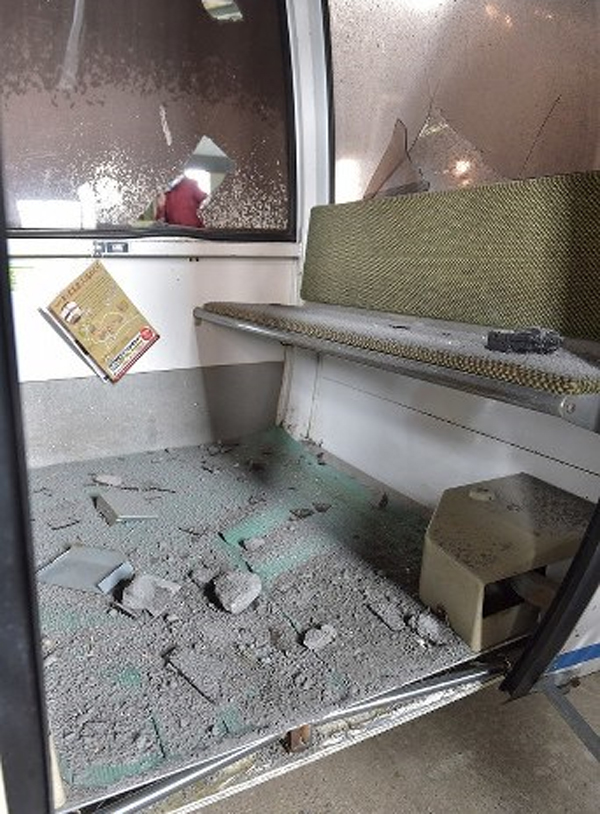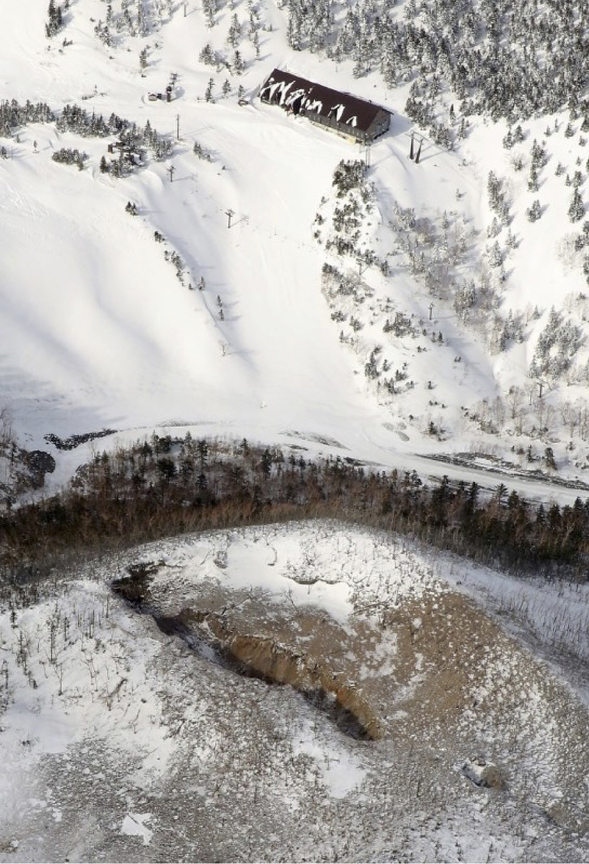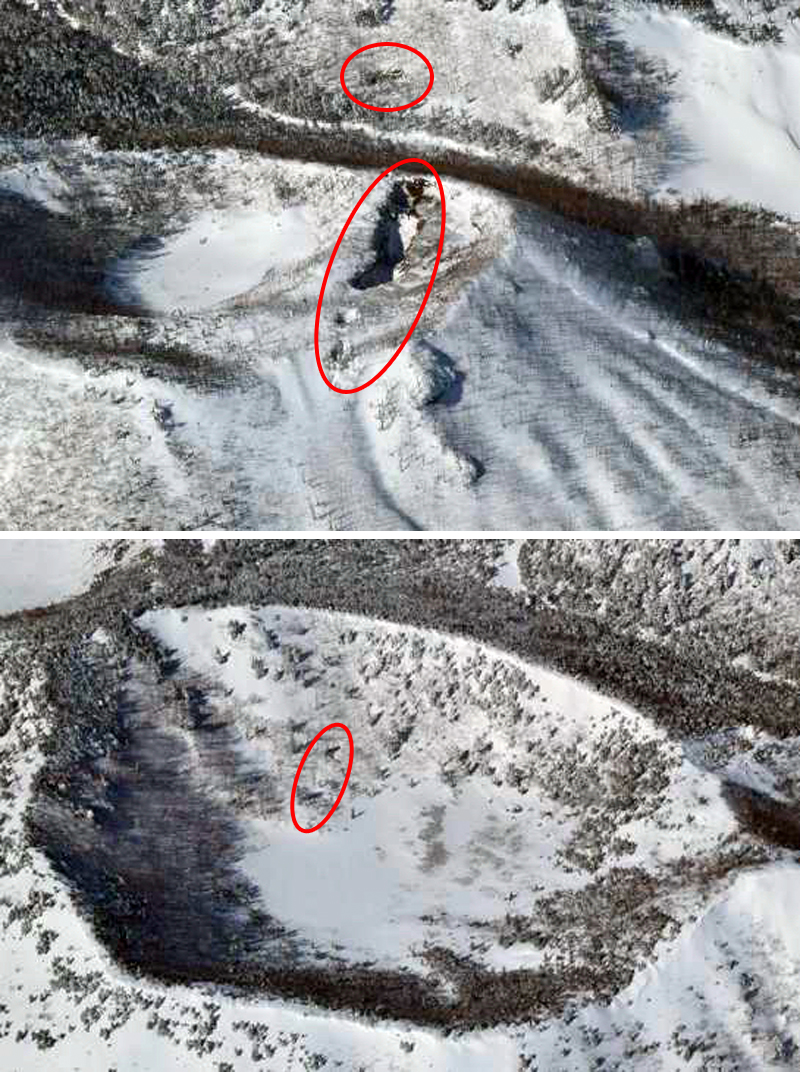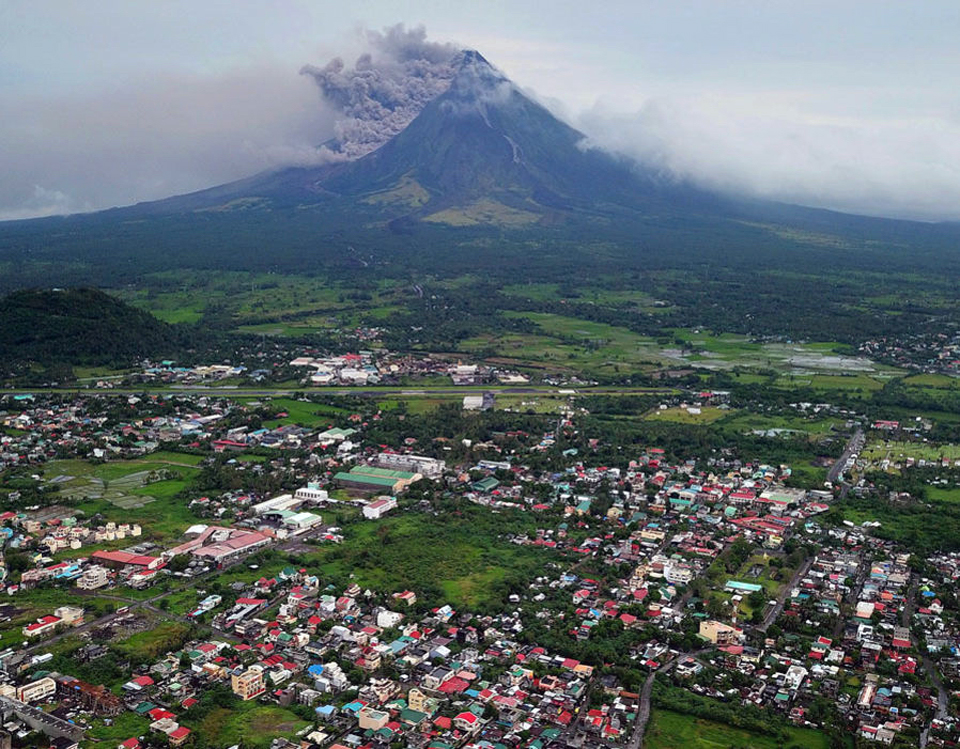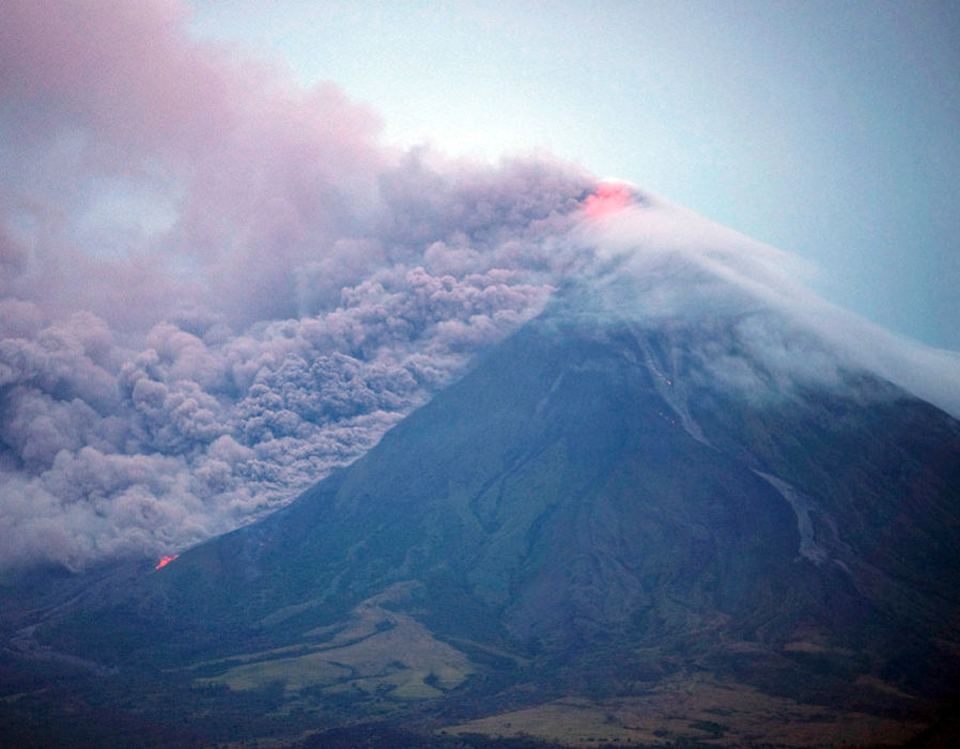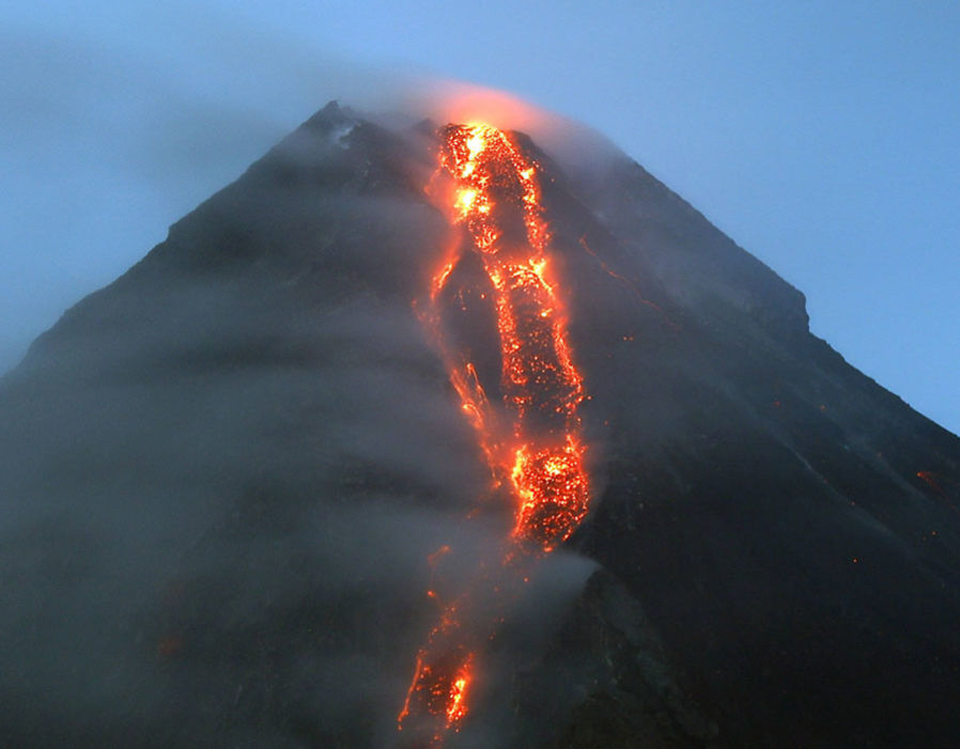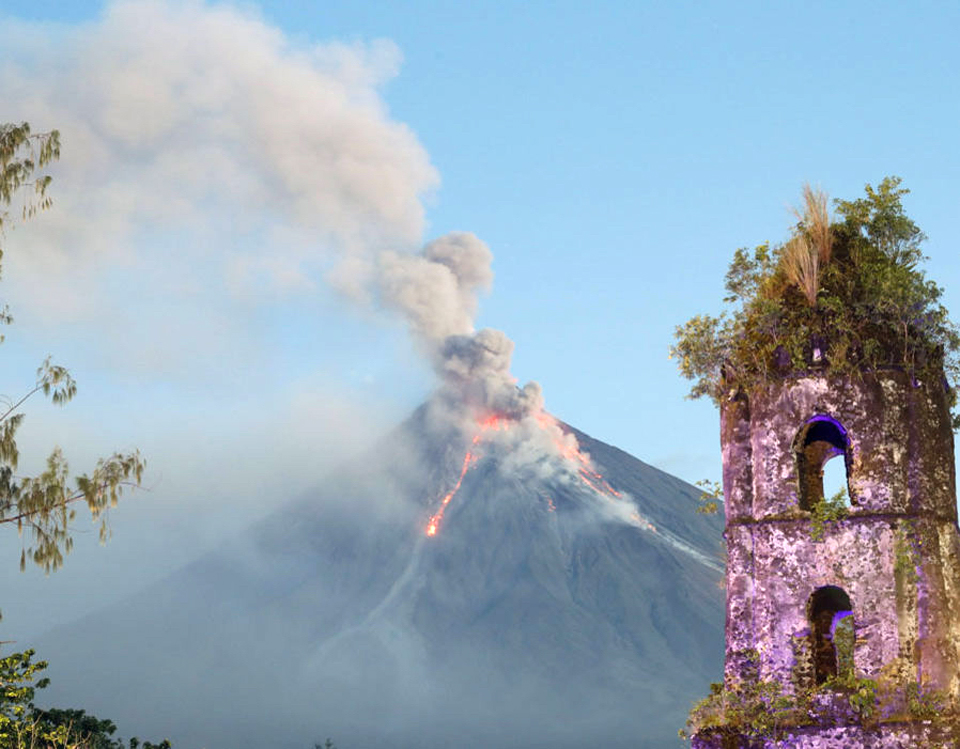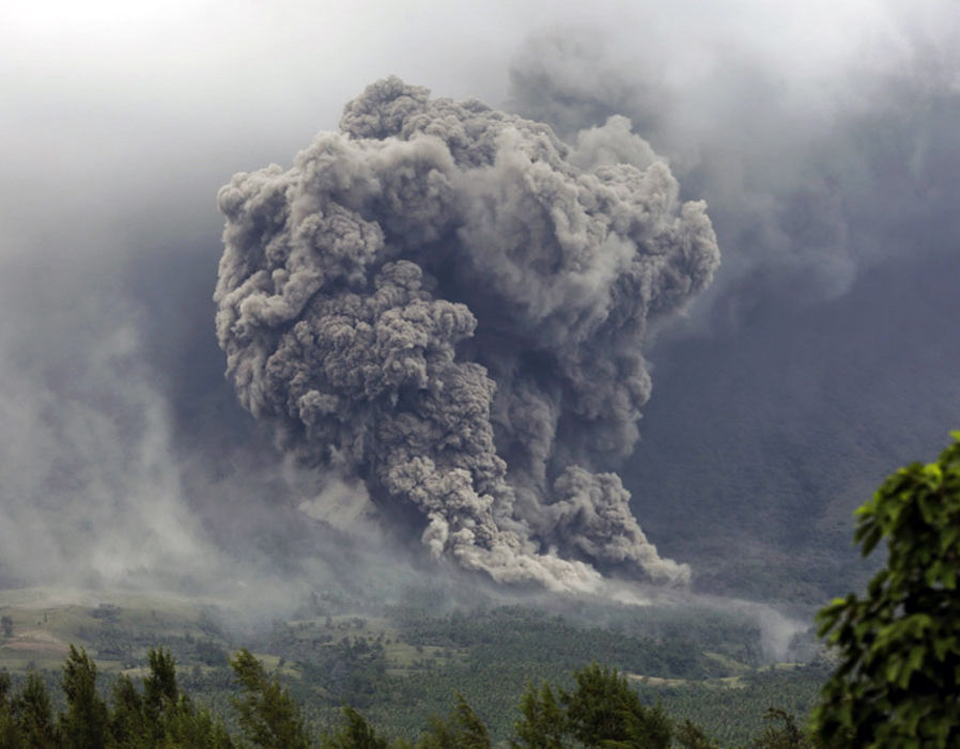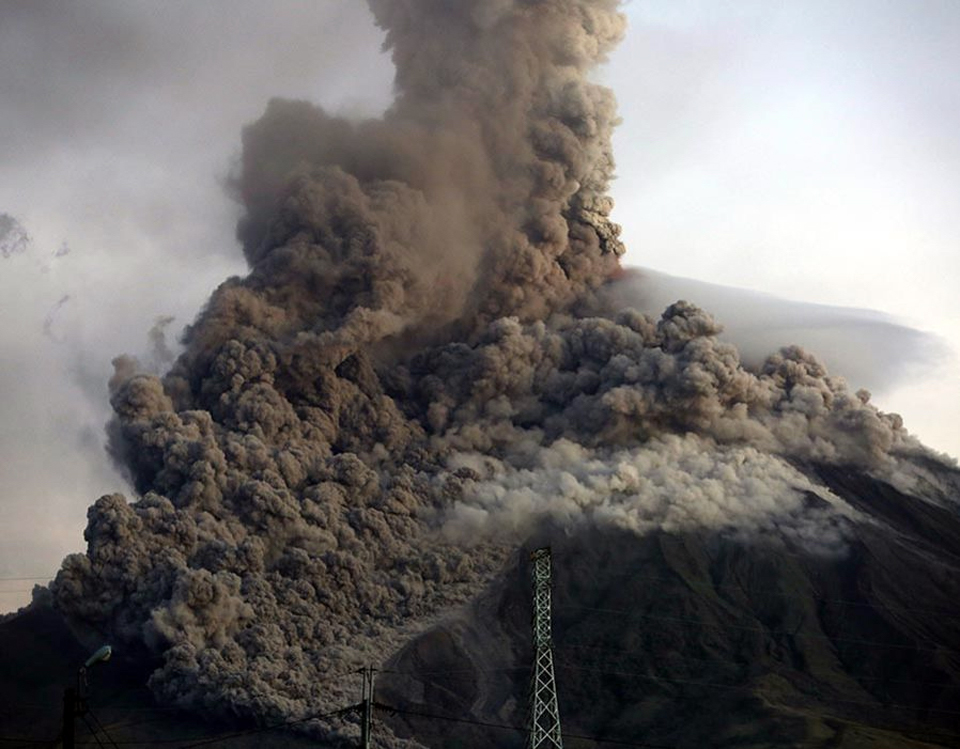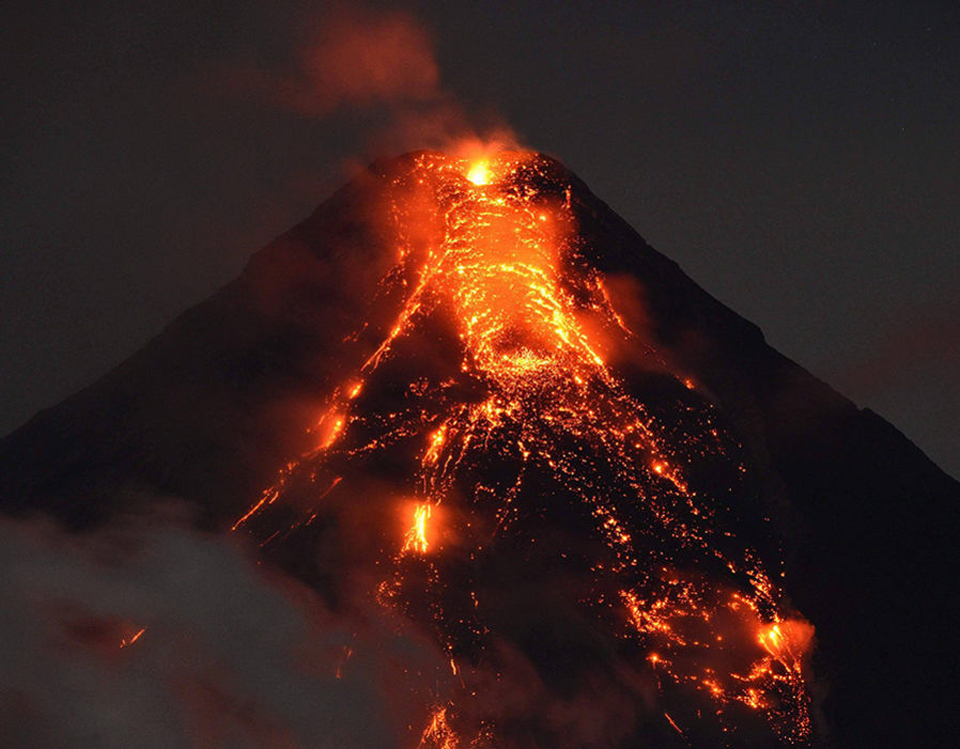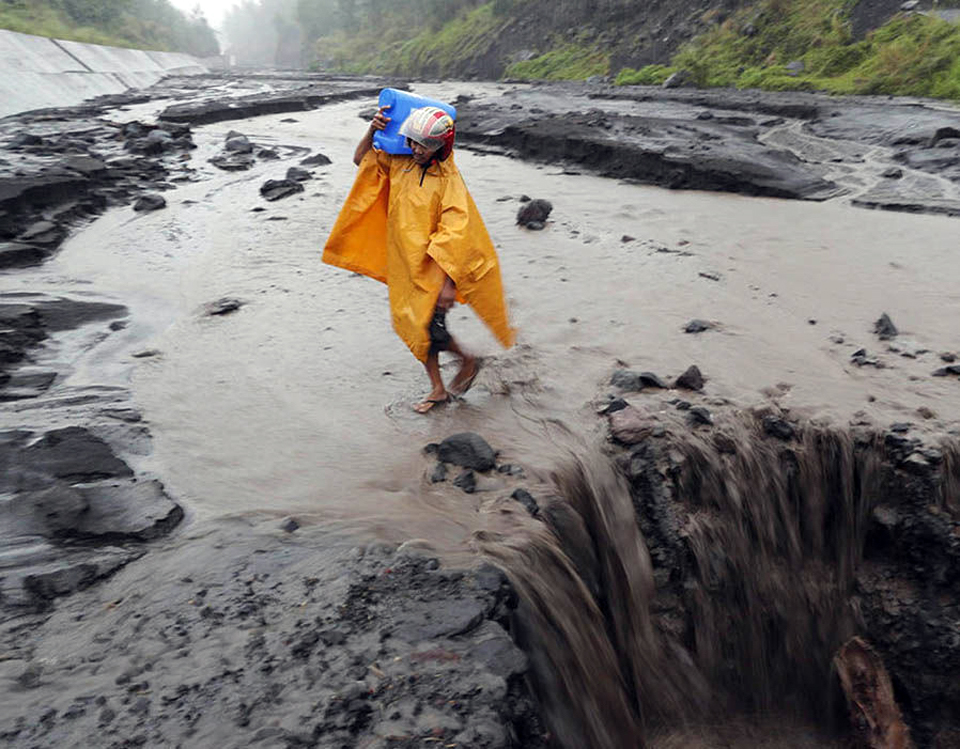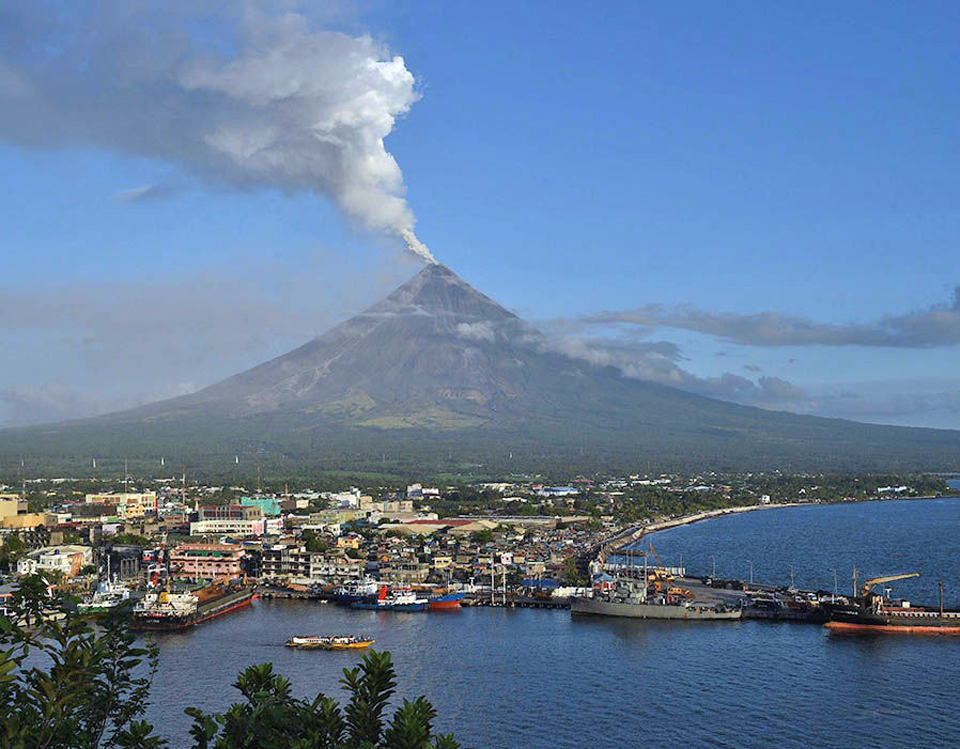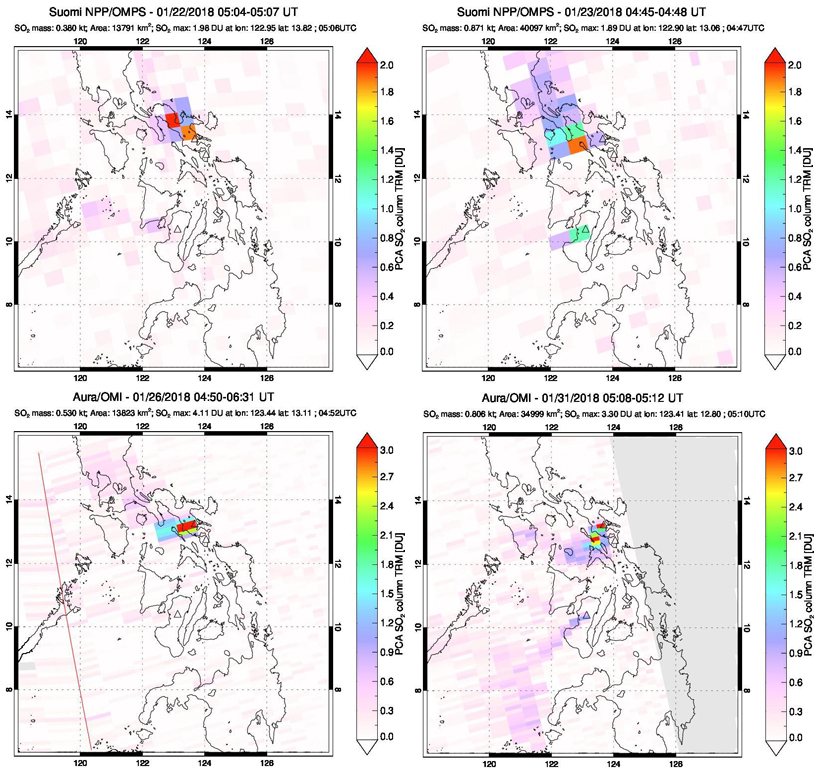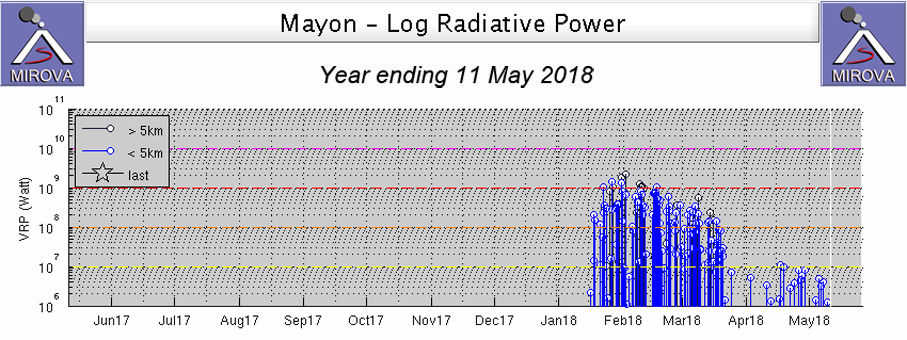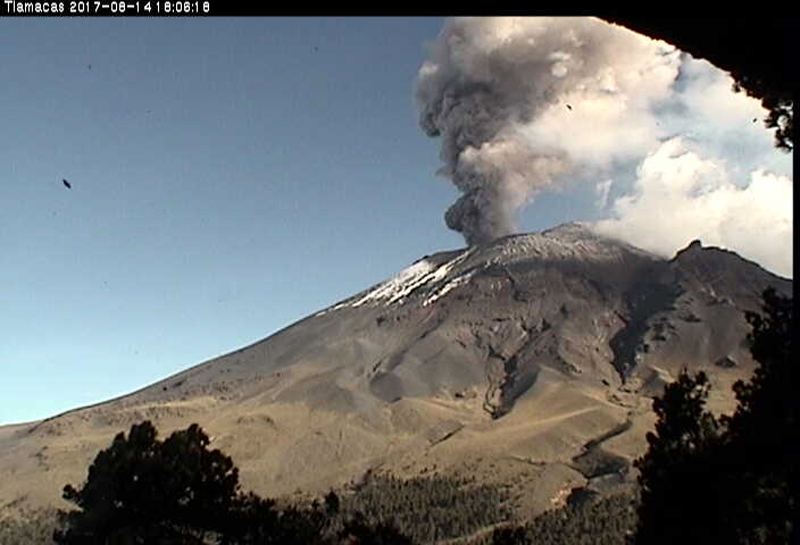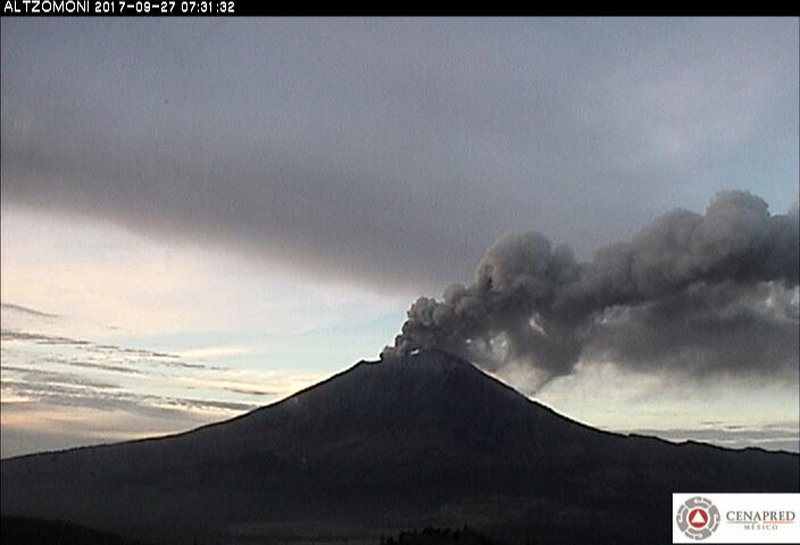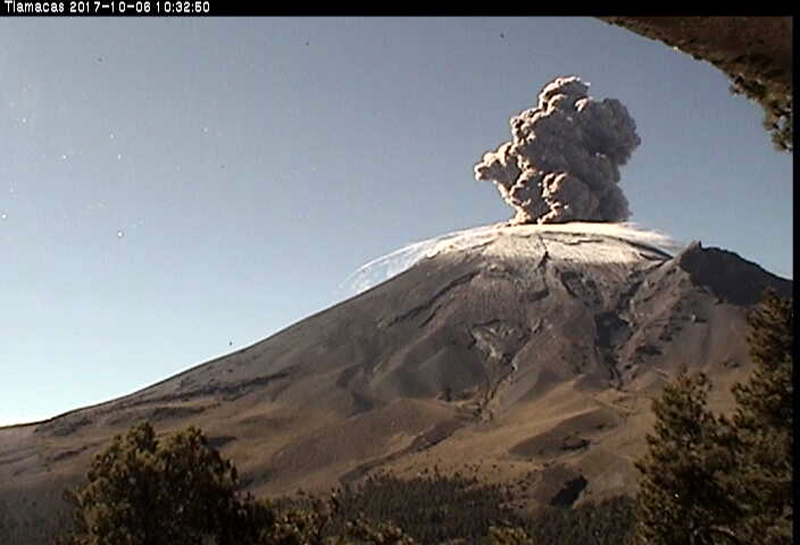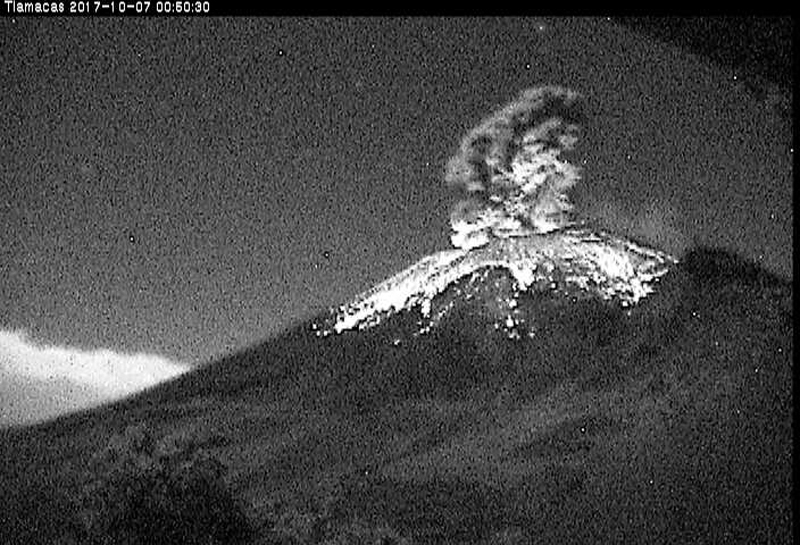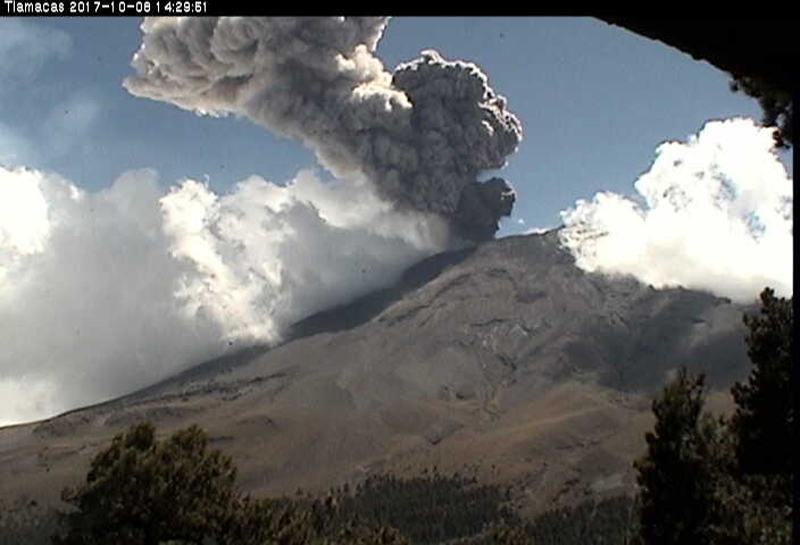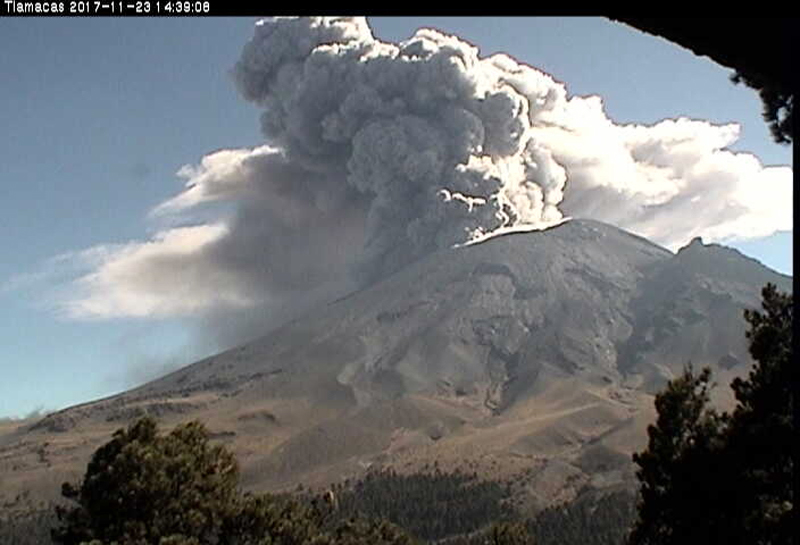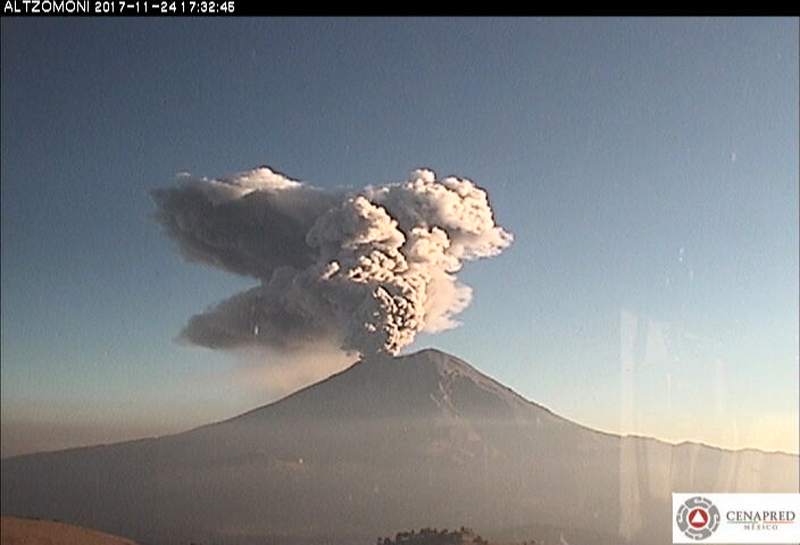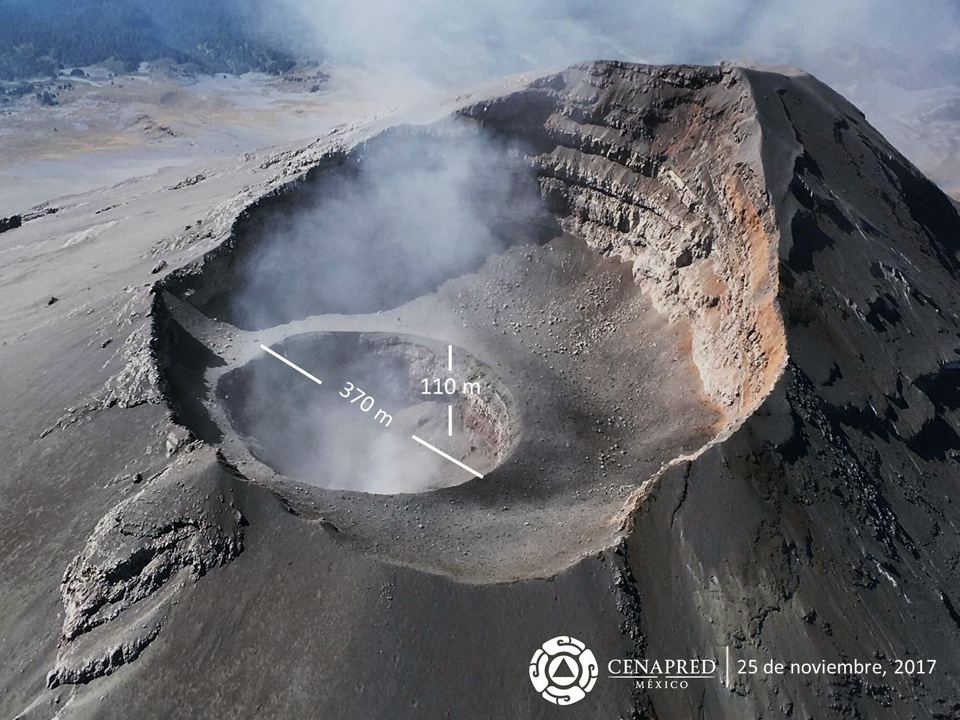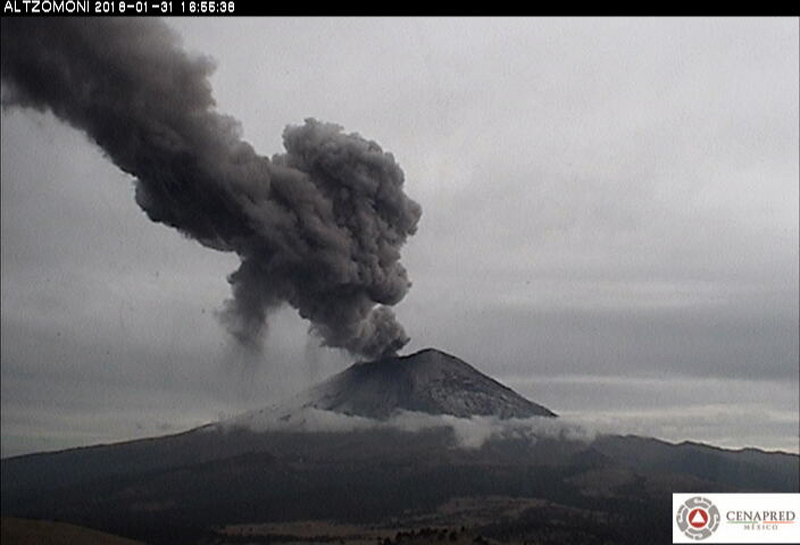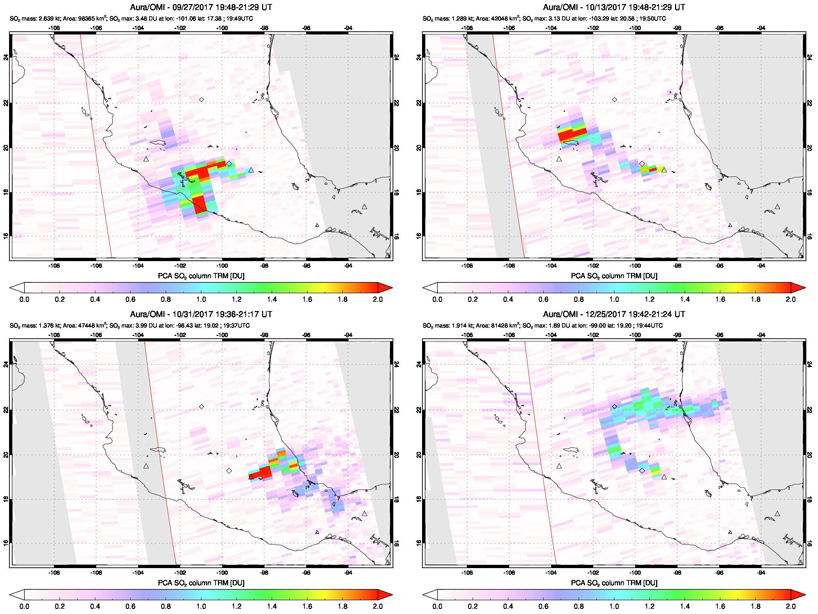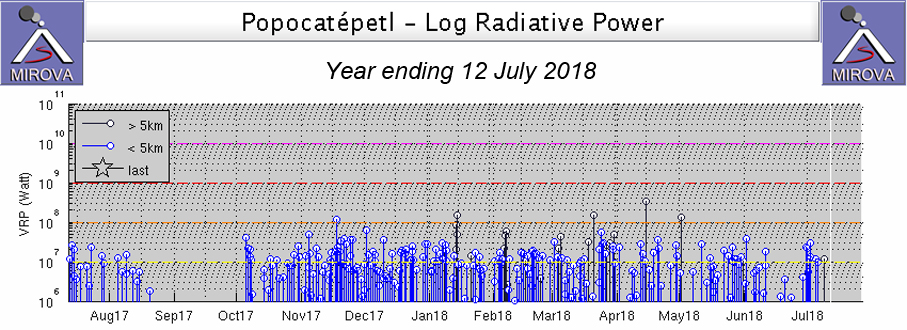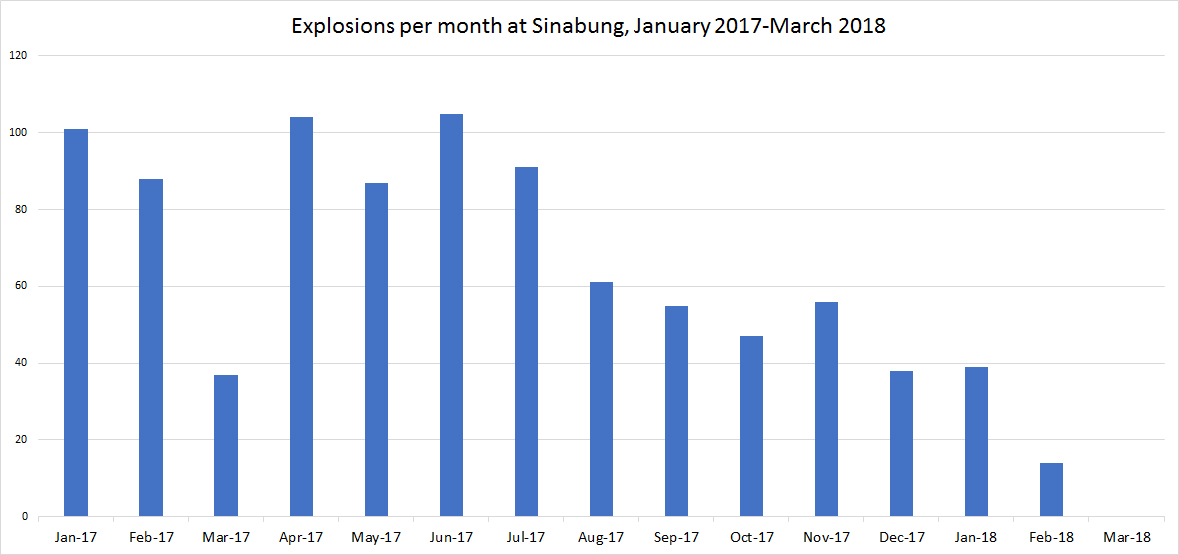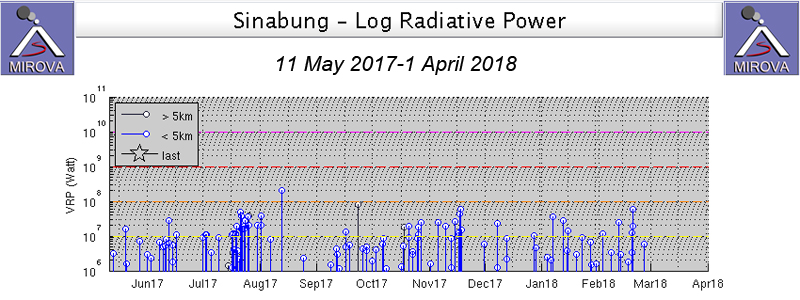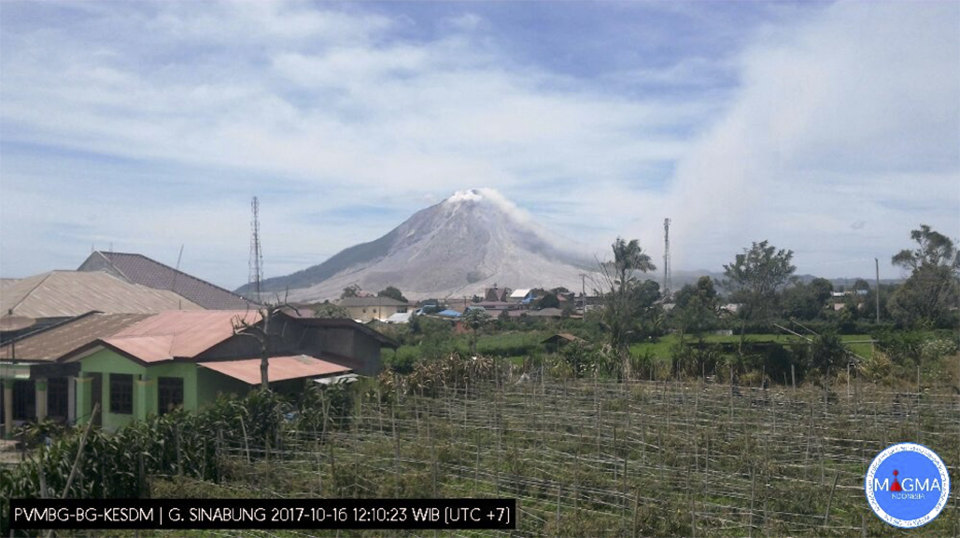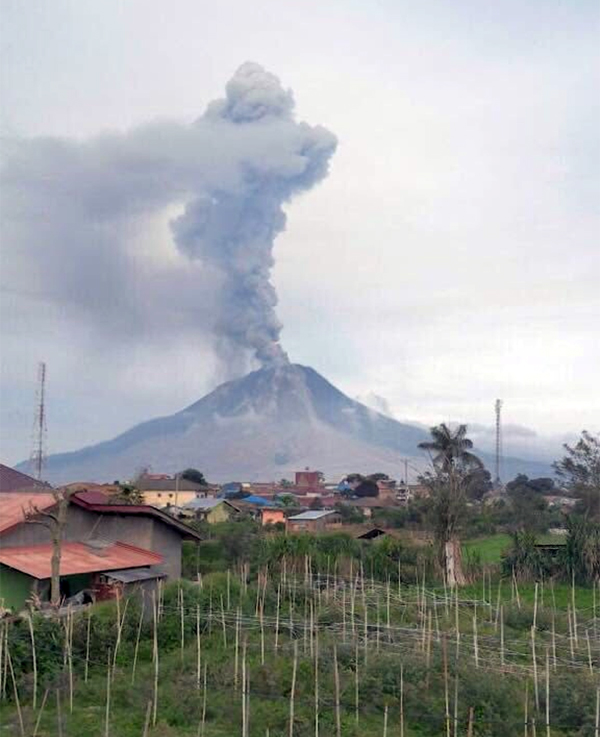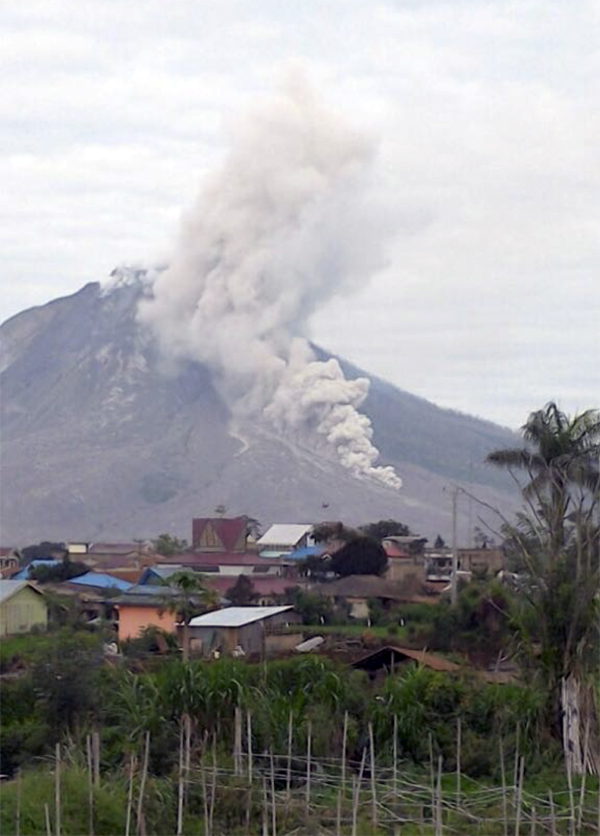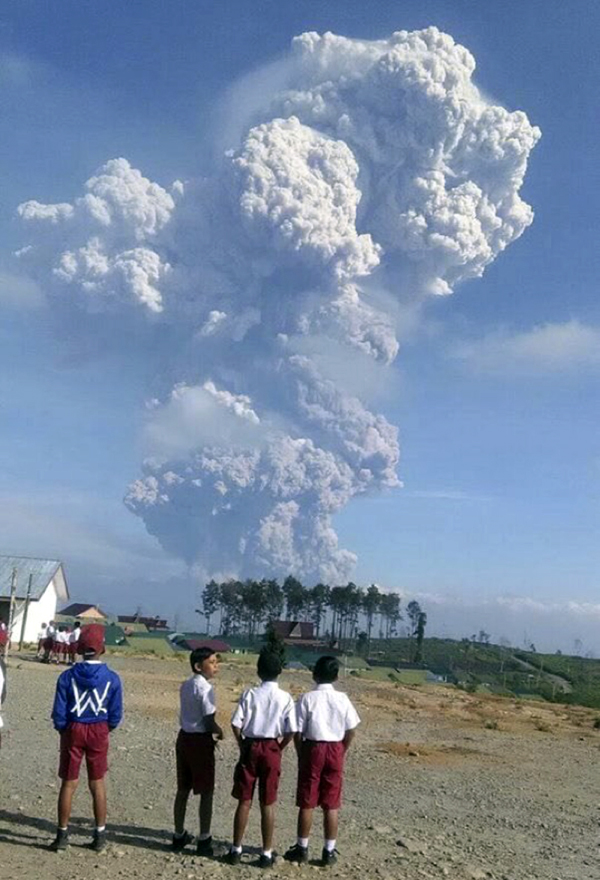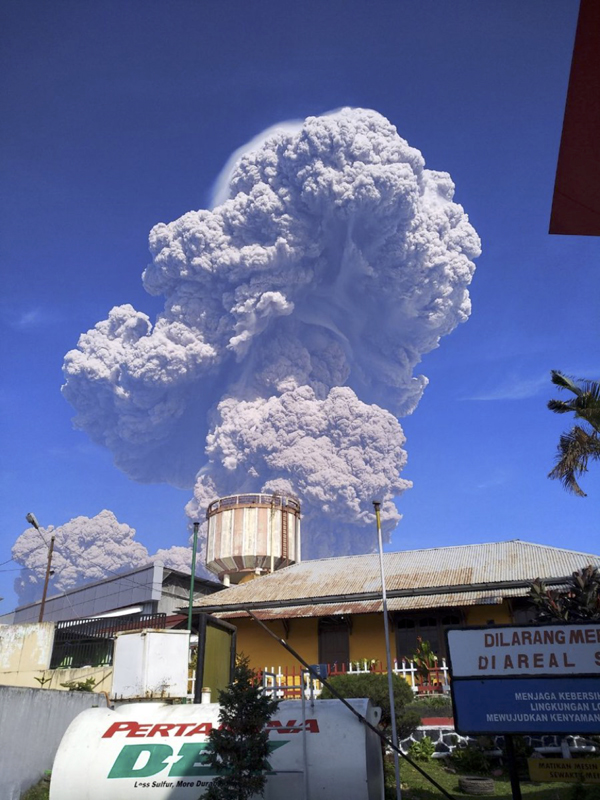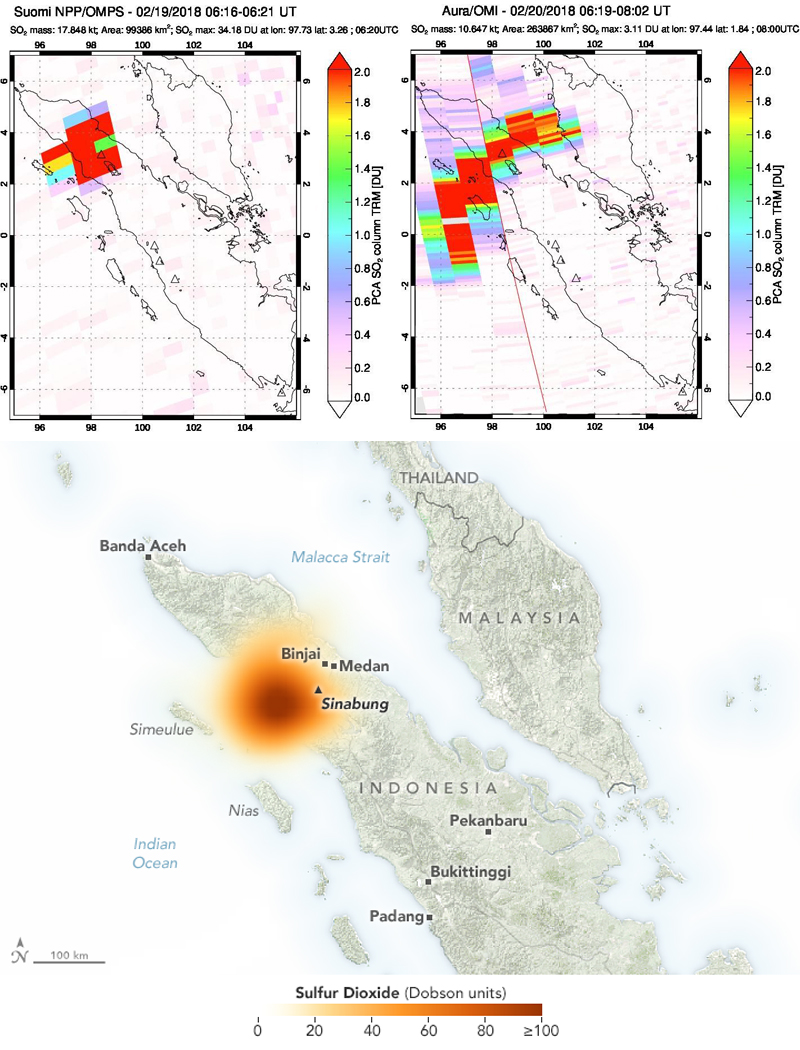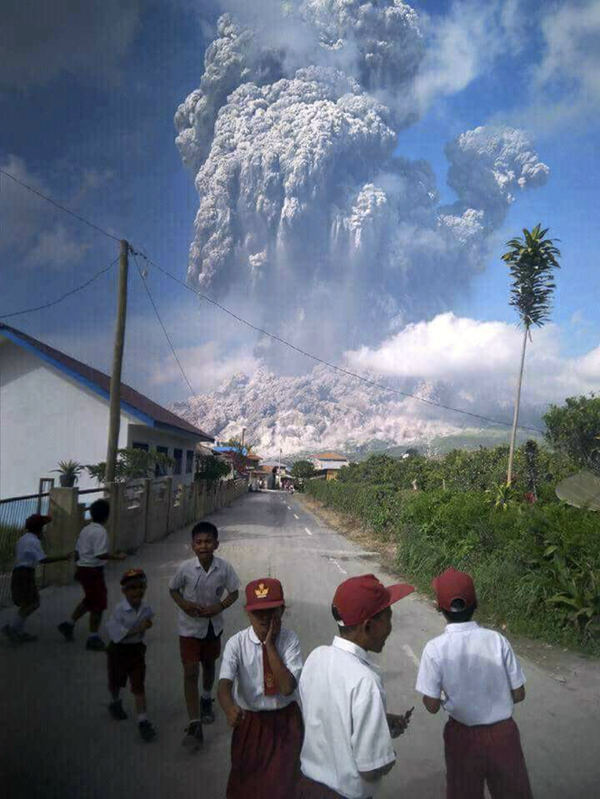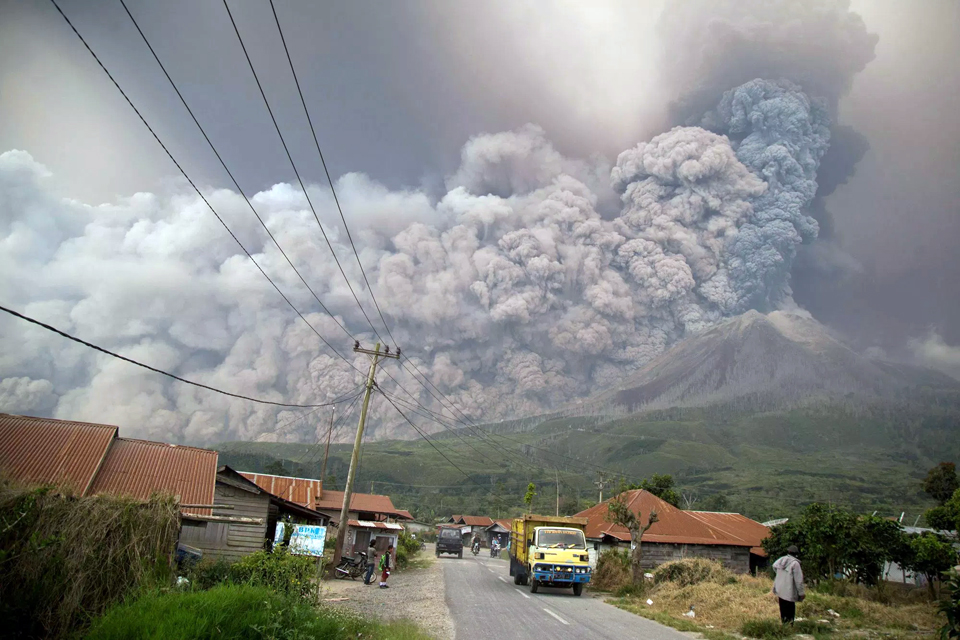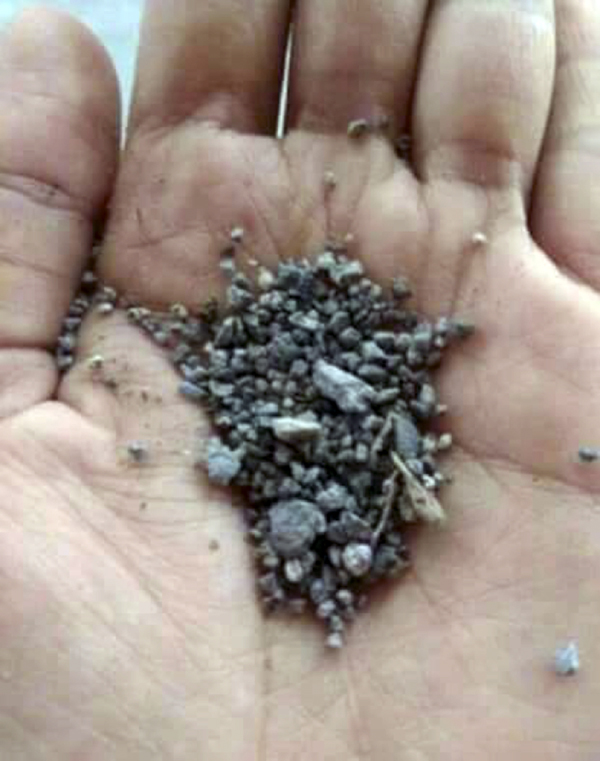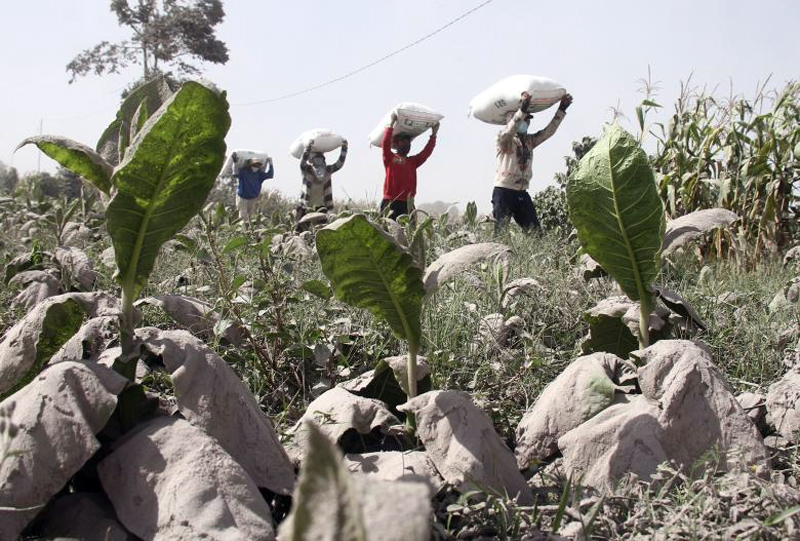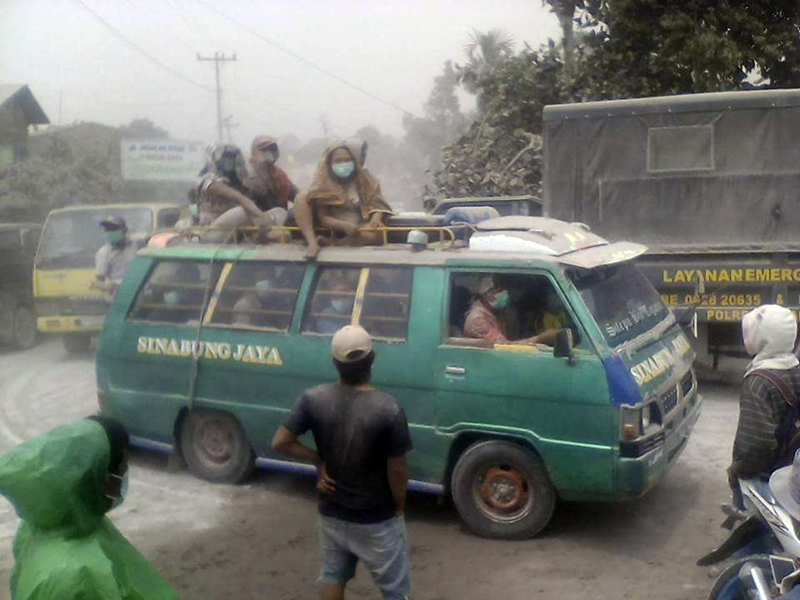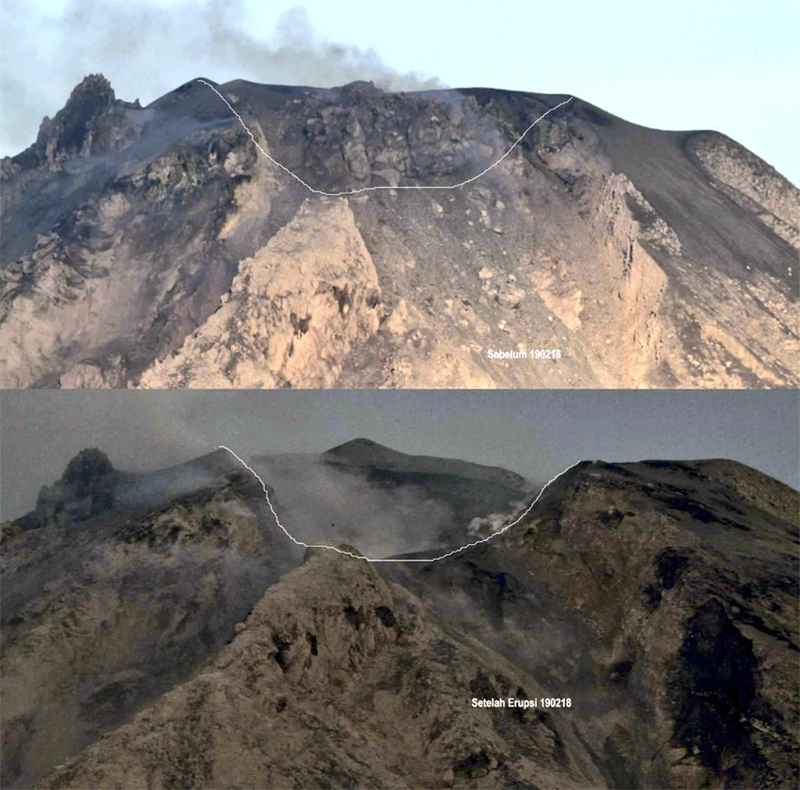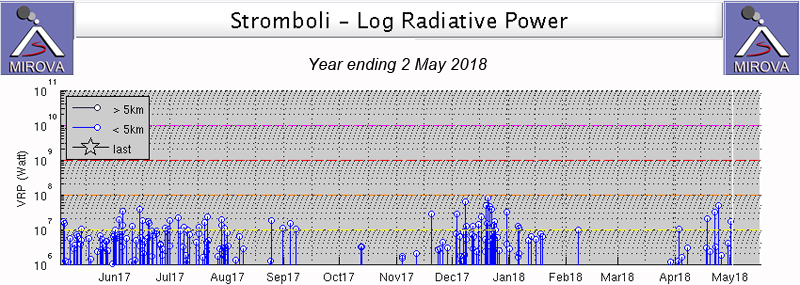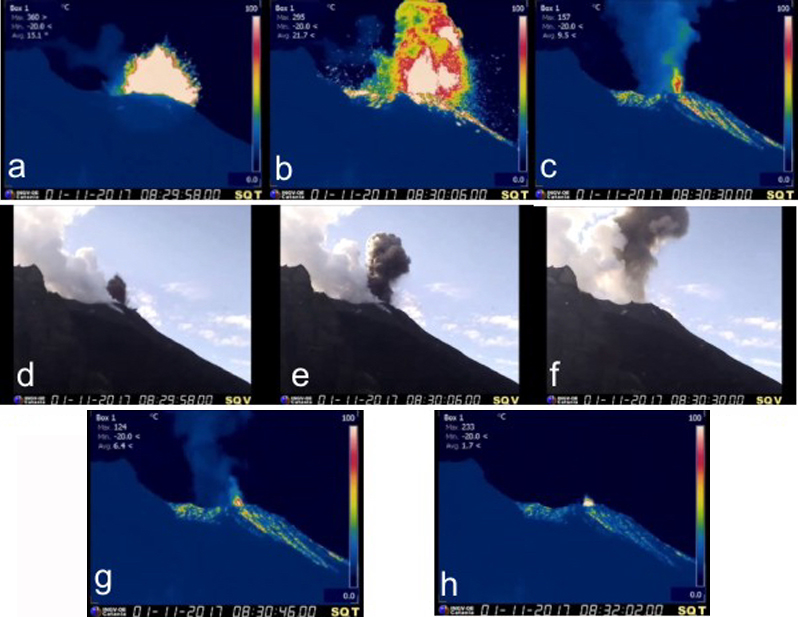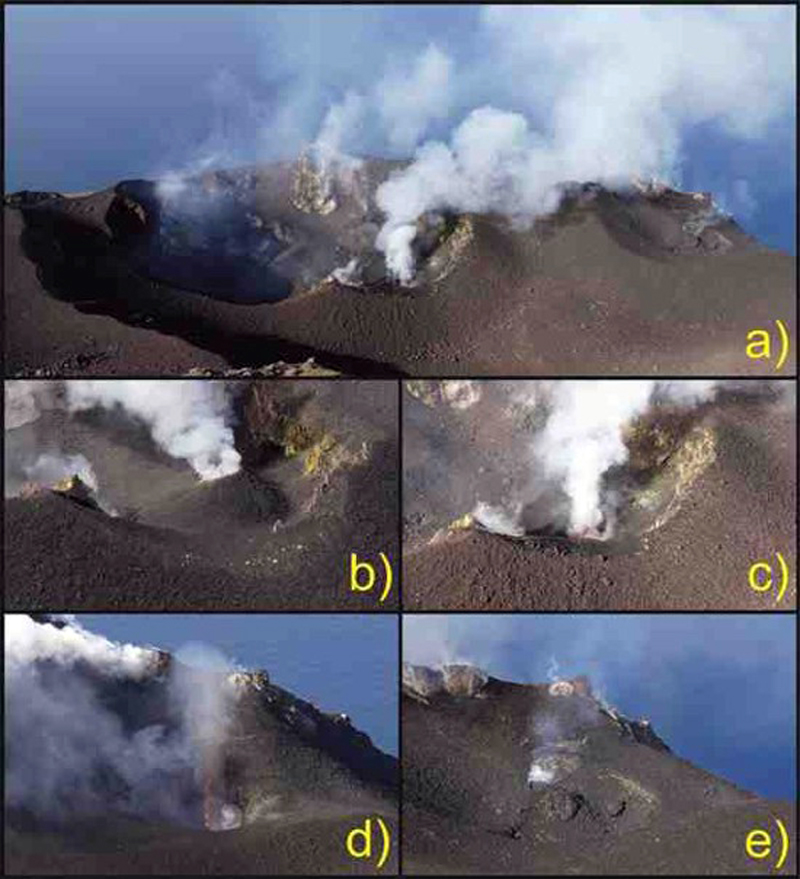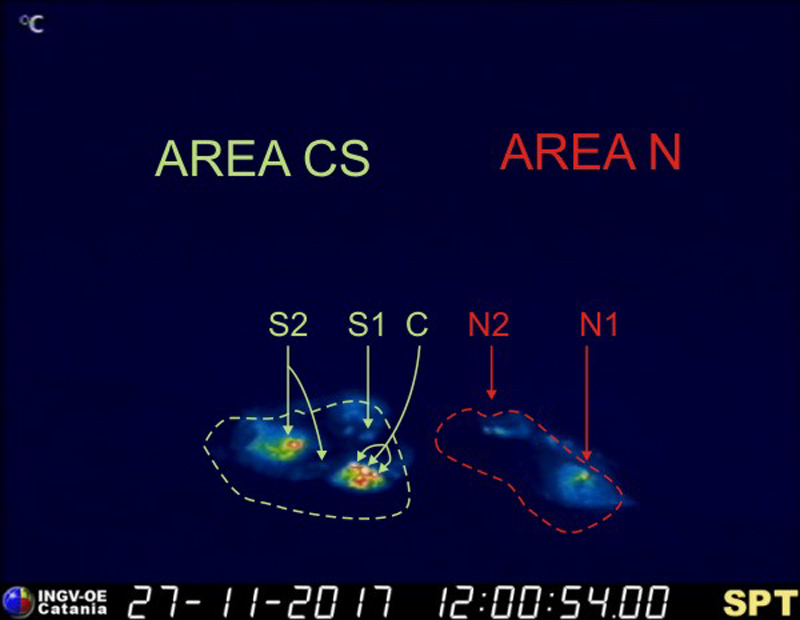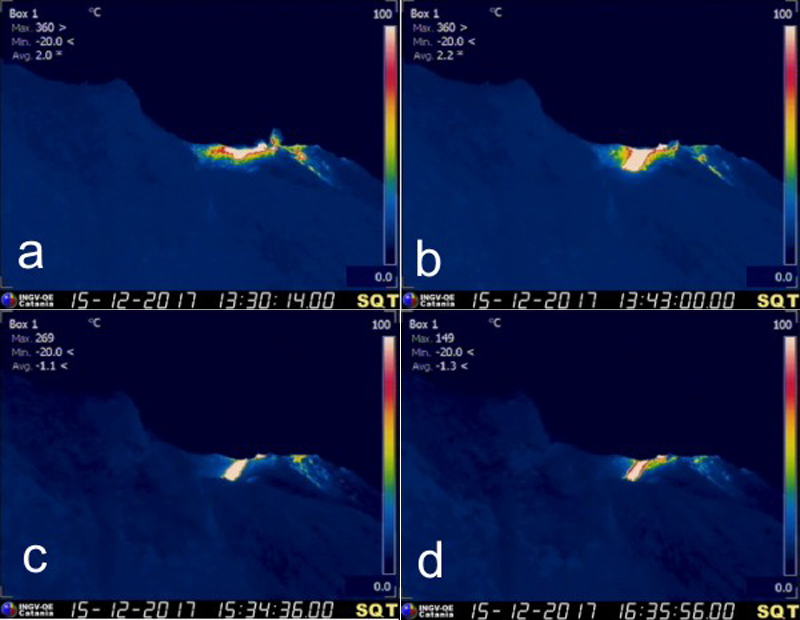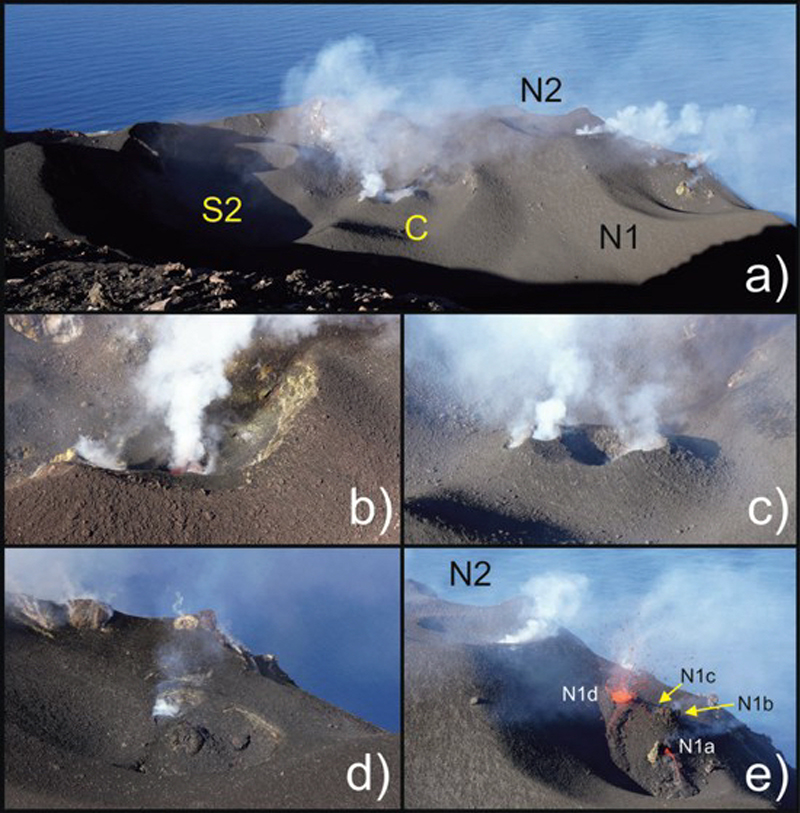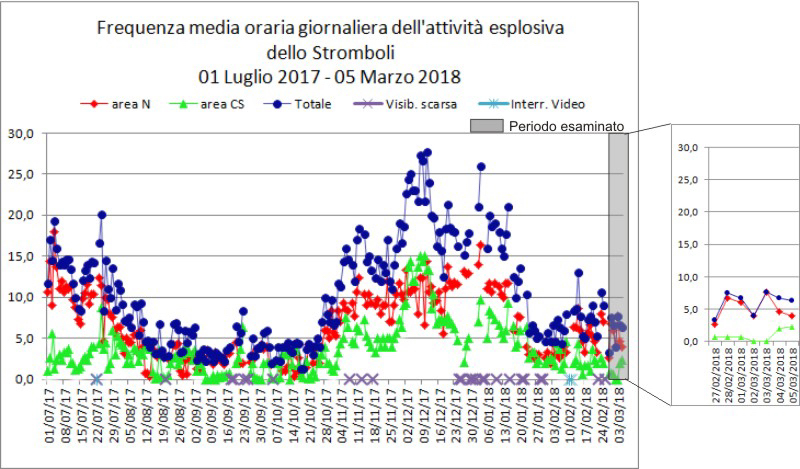Recently Published Bulletin Reports
Erebus (Antarctica) Lava lake remains active; most thermal alerts recorded since 2019
Rincon de la Vieja (Costa Rica) Frequent phreatic explosions during July-December 2023
Bezymianny (Russia) Explosion on 18 October 2023 sends ash plume 8 km high; lava flows and incandescent avalanches
Kilauea (United States) Low-level lava effusions in the lava lake at Halema’uma’u during July-December 2022
Nyamulagira (DR Congo) Lava flows and thermal activity during May-October 2023
Bagana (Papua New Guinea) Explosions, ash plumes, ashfall, and lava flows during April-September 2023
Mayon (Philippines) Lava flows, pyroclastic flows, ash emissions, and seismicity during April-September 2023
Nishinoshima (Japan) Eruption plumes and gas-and-steam plumes during May-August 2023
Krakatau (Indonesia) White gas-and-steam plumes and occasional ash plumes during May-August 2023
Villarrica (Chile) Strombolian activity, gas-and-ash emissions, and crater incandescence during April-September 2023
Merapi (Indonesia) Frequent incandescent avalanches during April-September 2023
Ebeko (Russia) Moderate explosive activity with ash plumes continued during June-November 2023
Erebus (Antarctica) — January 2024  Cite this Report
Cite this Report
Erebus
Antarctica
77.53°S, 167.17°E; summit elev. 3794 m
All times are local (unless otherwise noted)
Lava lake remains active; most thermal alerts recorded since 2019
The lava lake in the summit crater of Erebus has been active since at least 1972. Located in Antarctica overlooking the McMurdo Station on Ross Island, it is the southernmost active volcano on the planet. Because of the remote location, activity is primarily monitored by satellites. This report covers activity during 2023.
The number of thermal alerts recorded by the Hawai'i Institute of Geophysics and Planetology’s MODVOLC Thermal Alerts System increased considerably in 2023 compared to the years 2020-2022 (table 9). In contrast to previous years, the MODIS instruments aboard the Aqua and Terra satellites captured data from Erebus every month during 2023. Consistent with previous years, the lowest number of anomalous pixels were recorded in January, November, and December.
Table 9. Number of monthly MODIS-MODVOLC thermal alert pixels recorded at Erebus during 2017-2023. See BGVN 42:06 for data from 2000 through 2016. The table was compiled using data provided by the HIGP – MODVOLC Thermal Alerts System.
| Year |
Jan |
Feb |
Mar |
Apr |
May |
Jun |
Jul |
Aug |
Sep |
Oct |
Nov |
Dec |
SUM |
| 2017 |
0 |
21 |
9 |
0 |
0 |
1 |
11 |
61 |
76 |
52 |
0 |
3 |
234 |
| 2018 |
0 |
21 |
58 |
182 |
55 |
17 |
137 |
172 |
103 |
29 |
0 |
0 |
774 |
| 2019 |
2 |
21 |
162 |
151 |
55 |
56 |
75 |
53 |
29 |
19 |
1 |
0 |
624 |
| 2020 |
0 |
2 |
16 |
18 |
4 |
4 |
1 |
3 |
18 |
3 |
1 |
6 |
76 |
| 2021 |
0 |
9 |
1 |
0 |
2 |
56 |
46 |
47 |
35 |
52 |
5 |
3 |
256 |
| 2022 |
1 |
13 |
55 |
22 |
15 |
32 |
39 |
19 |
31 |
11 |
0 |
0 |
238 |
| 2023 |
2 |
33 |
49 |
82 |
41 |
32 |
70 |
64 |
42 |
17 |
5 |
11 |
448 |
Sentinel-2 infrared images showed one or two prominent heat sources within the summit crater, accompanied by adjacent smaller sources, similar to recent years (see BGVN 46:01, 47:02, and 48:01). A unique image was obtained on 25 November 2023 by the OLI-2 (Operational Land Imager-2) on Landsat 9, showing the upper part of the volcano surrounded by clouds (figure 32).
Geologic Background. Mount Erebus, the world's southernmost historically active volcano, overlooks the McMurdo research station on Ross Island. It is the largest of three major volcanoes forming the crudely triangular Ross Island. The summit of the dominantly phonolitic volcano has been modified by one or two generations of caldera formation. A summit plateau at about 3,200 m elevation marks the rim of the youngest caldera, which formed during the late-Pleistocene and within which the modern cone was constructed. An elliptical 500 x 600 m wide, 110-m-deep crater truncates the summit and contains an active lava lake within a 250-m-wide, 100-m-deep inner crater; other lava lakes are sometimes present. The glacier-covered volcano was erupting when first sighted by Captain James Ross in 1841. Continuous lava-lake activity with minor explosions, punctuated by occasional larger Strombolian explosions that eject bombs onto the crater rim, has been documented since 1972, but has probably been occurring for much of the volcano's recent history.
Information Contacts: Hawai'i Institute of Geophysics and Planetology (HIGP) - MODVOLC Thermal Alerts System, School of Ocean and Earth Science and Technology (SOEST), Univ. of Hawai'i, 2525 Correa Road, Honolulu, HI 96822, USA (URL: http://modis.higp.hawaii.edu/); Copernicus Browser, Copernicus Data Space Ecosystem, European Space Agency (URL: https://dataspace.copernicus.eu/browser/); NASA Earth Observatory, EOS Project Science Office, NASA Goddard Space Flight Center, Goddard, Maryland, USA (URL: https://earthobservatory.nasa.gov/images/152134/erebus-breaks-through).
Rincon de la Vieja (Costa Rica) — January 2024  Cite this Report
Cite this Report
Rincon de la Vieja
Costa Rica
10.83°N, 85.324°W; summit elev. 1916 m
All times are local (unless otherwise noted)
Frequent phreatic explosions during July-December 2023
Rincón de la Vieja is a volcanic complex in Costa Rica with a hot convecting acid lake that exhibits frequent weak phreatic explosions, gas-and-steam emissions, and occasional elevated sulfur dioxide levels (BGVN 45:10, 46:03, 46:11). The current eruption period began June 2021. This report covers activity during July-December 2023 and is based on weekly bulletins and occasional daily reports from the Observatorio Vulcanologico Sismologica de Costa Rica-Universidad Nacional (OVSICORI-UNA).
Numerous weak phreatic explosions continued during July-December 2023, along with gas-and-steam emissions and plumes that rose as high as 3 km above the crater rim. Many weekly OVSICORI-UNA bulletins included the previous week's number of explosions and emissions (table 9). For many explosions, the time of explosion was given (table 10). Frequent seismic activity (long-period earthquakes, volcano-tectonic earthquakes, and tremor) accompanied the phreatic activity.
Table 9. Number of reported weekly phreatic explosions and gas-and-steam emissions at Rincón de la Vieja, July-December 2023. Counts are reported for the week before the Weekly Bulletin date; not all reports included these data. Courtesy of OVSICORI-UNA.
| OVSICORI Weekly Bulletin |
Number of explosions |
Number of emissions |
| 28 Jul 2023 |
6 |
14 |
| 4 Aug 2023 |
10 |
12 |
| 1 Sep 2023 |
13 |
11 |
| 22 Sep 2023 |
12 |
13 |
| 29 Sep 2023 |
6 |
11 |
| 6 Oct 2023 |
12 |
5 |
| 13 Oct 2023 |
7 |
9 |
| 20 Oct 2023 |
1 |
15 |
| 27 Oct 2023 |
3 |
23 |
| 3 Nov 2023 |
3 |
10 |
| 17 Nov 2023 |
0 |
Some |
| 24 Nov 2023 |
0 |
14 |
| 8 Dec 2023 |
4 |
16 |
| 22 Dec 2023 |
8 |
18 |
Table 10. Summary of activity at Rincón de la Vieja during July-December 2023. Weak phreatic explosions and gas emissions are noted where the time of explosion was indicated in the weekly or daily bulletins. Height of plumes or emissions are distance above the crater rim. Courtesy of OVSICORI-UNA.
| Date |
Time |
Description of Activity |
| 1 Jul 2023 |
0156 |
Explosion. |
| 2 Jul 2023 |
0305 |
Explosion. |
| 4 Jul 2023 |
0229, 0635 |
Event at 0635 produced a gas-and-steam plume that rose 700 m and drifted W; seen by residents in Liberia (21 km SW). |
| 9 Jul 2023 |
1843 |
Explosion. |
| 21 Jul 2023 |
0705 |
Explosion. |
| 26 Jul 2023 |
1807 |
Explosion. |
| 28 Jul 2023 |
0802 |
Explosion generated a gas-and-steam plume that rose 500 m. |
| 30 Jul 2023 |
1250 |
Explosion. |
| 31 Jul 2023 |
2136 |
Explosion. |
| 11 Aug 2023 |
0828 |
Explosion. |
| 18 Aug 2023 |
1304 |
Explosion. |
| 21 Aug 2023 |
1224 |
Explosion generated gas-and-steam plumes rose 500-600 m. |
| 22 Aug 2023 |
0749 |
Explosion generated gas-and-steam plumes rose 500-600 m. |
| 24 Aug 2023 |
1900 |
Explosion. |
| 25 Aug 2023 |
0828 |
Event produced a steam-and-gas plume that rose 3 km and drifted NW. |
| 27-28 Aug 2023 |
0813 |
Four small events; the event at 0813 on 28 August lasted two minutes and generated a steam-and-gas plume that rose 2.5 km. |
| 1 Sep 2023 |
1526 |
Explosion generated plume that rose 2 km and ejected material onto the flanks. |
| 2-3 Sep 2023 |
- |
Small explosions detected in infrasound data. |
| 4 Sep 2023 |
1251 |
Gas-and-steam plume rose 1 km and drifted W. |
| 7 Nov 2023 |
1113 |
Explosion. |
| 8 Nov 2023 |
0722 |
Explosion. |
| 12 Nov 2023 |
0136 |
Small gas emissions. |
| 14 Nov 2023 |
0415 |
Small gas emissions. |
According to OVSICORI-UNA, during July-October the average weekly sulfur dioxide (SO2) flux ranged from 68 to 240 tonnes/day. However, in mid-November the flux increased to as high as 334 tonnes/day, the highest value measured in recent years. The high SO2 flux in mid-November was also detected by the TROPOMI instrument on the Sentinel-5P satellite (figure 43).
Geologic Background. Rincón de la Vieja, the largest volcano in NW Costa Rica, is a remote volcanic complex in the Guanacaste Range. The volcano consists of an elongated, arcuate NW-SE-trending ridge constructed within the 15-km-wide early Pleistocene Guachipelín caldera, whose rim is exposed on the south side. Sometimes known as the "Colossus of Guanacaste," it has an estimated volume of 130 km3 and contains at least nine major eruptive centers. Activity has migrated to the SE, where the youngest-looking craters are located. The twin cone of Santa María volcano, the highest peak of the complex, is located at the eastern end of a smaller, 5-km-wide caldera and has a 500-m-wide crater. A Plinian eruption producing the 0.25 km3 Río Blanca tephra about 3,500 years ago was the last major magmatic eruption. All subsequent eruptions, including numerous historical eruptions possibly dating back to the 16th century, have been from the prominent active crater containing a 500-m-wide acid lake located ENE of Von Seebach crater.
Information Contacts: Observatorio Vulcanológico Sismológica de Costa Rica-Universidad Nacional (OVSICORI-UNA), Apartado 86-3000, Heredia, Costa Rica (URL: http://www.ovsicori.una.ac.cr/); NASA Global Sulfur Dioxide Monitoring Page, Atmospheric Chemistry and Dynamics Laboratory, NASA Goddard Space Flight Center (NASA/GSFC), 8800 Greenbelt Road, Goddard MD 20771, USA (URL: https://so2.gsfc.nasa.gov/).
Bezymianny (Russia) — November 2023  Cite this Report
Cite this Report
Bezymianny
Russia
55.972°N, 160.595°E; summit elev. 2882 m
All times are local (unless otherwise noted)
Explosion on 18 October 2023 sends ash plume 8 km high; lava flows and incandescent avalanches
Bezymianny, located on Russia’s Kamchatka Peninsula, has had eruptions since 1955 characterized by dome growth, explosions, pyroclastic flows, ash plumes, and ashfall. Activity during November 2022-April 2023 included gas-and-steam emissions, lava dome collapses generating avalanches, and persistent thermal activity. Similar eruptive activity continued from May through October 2023, described here based on information from weekly and daily reports of the Kamchatka Volcano Eruptions Response Team (KVERT), notices from Tokyo VAAC (Volcanic Ash Advisory Center), and from satellite data.
Overall activity decreased after the strong period of activity in late March through April 2023, which included ash explosions during 29 March and 7-8 April 2023 that sent plumes as high as 10-12 km altitude, along with dome growth and lava flows (BGVN 48:05). This reduced activity can be seen in the MIROVA thermal detection system graph (figure 56), which was consistent with data from the MODVOLC thermal detection system and with Sentinel-2 satellite images that showed persistent hotspots in the summit crater when conditions allowed observations. A renewed period of strong activity began in mid-October 2023.
Activity increased significantly on 17 October 2023 when large collapses began during 0700-0830 on the E flanks of the lava dome and continued to after 0930 the next day (figure 57). Ash plumes rose to an altitude of 4.5-5 km, extending 220 km NNE by 18 October. A large explosion at 1630 on 18 October produced an ash plume that rose to an altitude of 11 km (8 km above the summit) and drifted NNE and then NW, extending 900 km NW within two days at an altitude of 8 km. Minor ashfall was noted in Kozyrevsk (45 km WNW). At 0820 on 20 October an ash plume was identified in satellite images drifting 100 km ENE at altitudes of 4-4.5 km.
Lava flows and hot avalanches from the dome down the SE flank continued over the next few days, including 23 October when clear conditions allowed good observations (figures 58 and 59). A large thermal anomaly was observed over the volcano through 24 October, and in the summit crater on 30 October (figure 60). Strong fumarolic activity continued, with numerous avalanches and occasional incandescence. By the last week of October, volcanic activity had decreased to a level consistent with that earlier in the reporting period.
Aviation warnings were frequently updated during 17-20 October. KVERT issued a Volcano Observatory Notice for Aviation (VONA) on 17 October at 1419 and 1727 (0219 and 0527 UTC) raising the Aviation Color Code (ACC) from Yellow to Orange (second highest level). The next day, KVERT issued a VONA at 1705 (0505 UTC) raising the ACC to Red (highest level) but lowered it back to Orange at 2117 (0917 UTC). After another decrease to Yellow and back to Orange, the ACC was reduced to Yellow on 20 October at 1204 (0004 UTC). In addition, the Tokyo VAAC issued a series of Volcanic Ash Advisories beginning on 16 October and continuing through 30 October.
Geologic Background. The modern Bezymianny, much smaller than its massive neighbors Kamen and Kliuchevskoi on the Kamchatka Peninsula, was formed about 4,700 years ago over a late-Pleistocene lava-dome complex and an edifice built about 11,000-7,000 years ago. Three periods of intensified activity have occurred during the past 3,000 years. The latest period, which was preceded by a 1,000-year quiescence, began with the dramatic 1955-56 eruption. This eruption, similar to that of St. Helens in 1980, produced a large open crater that was formed by collapse of the summit and an associated lateral blast. Subsequent episodic but ongoing lava-dome growth, accompanied by intermittent explosive activity and pyroclastic flows, has largely filled the 1956 crater.
Information Contacts: Kamchatka Volcanic Eruptions Response Team (KVERT), Far Eastern Branch, Russian Academy of Sciences, 9 Piip Blvd., Petropavlovsk-Kamchatsky, 683006, Russia (URL: http://www.kscnet.ru/ivs/kvert/); Kamchatka Volcanological Station, Kamchatka Branch of Geophysical Survey, (KB GS RAS), Klyuchi, Kamchatka Krai, Russia (URL: http://volkstat.ru/); Tokyo Volcanic Ash Advisory Center (VAAC), 1-3-4 Otemachi, Chiyoda-ku, Tokyo 100-8122, Japan (URL: http://ds.data.jma.go.jp/svd/vaac/data/); Hawai'i Institute of Geophysics and Planetology (HIGP) - MODVOLC Thermal Alerts System, School of Ocean and Earth Science and Technology (SOEST), Univ. of Hawai'i, 2525 Correa Road, Honolulu, HI 96822, USA (URL: http://modis.higp.hawaii.edu/); MIROVA (Middle InfraRed Observation of Volcanic Activity), a collaborative project between the Universities of Turin and Florence (Italy) supported by the Centre for Volcanic Risk of the Italian Civil Protection Department (URL: http://www.mirovaweb.it/); Copernicus Browser, Copernicus Data Space Ecosystem, European Space Agency (URL: https://dataspace.copernicus.eu/browser/).chr
Kilauea (United States) — January 2023  Cite this Report
Cite this Report
Kilauea
United States
19.421°N, 155.287°W; summit elev. 1222 m
All times are local (unless otherwise noted)
Low-level lava effusions in the lava lake at Halema’uma’u during July-December 2022
Kīlauea is the southeastern-most volcano in Hawaii and overlaps the E flank of the Mauna Loa volcano. Its East Rift Zone (ERZ) has been intermittently active for at least 2,000 years. An extended eruption period began in January 1983 and was characterized by open lava lakes and lava flows from the summit caldera and the East Rift Zone. During May 2018 magma migrated into the Lower East Rift Zone (LERZ) and opened 24 fissures along a 6-km-long NE-trending fracture zone that produced lava flows traveling in multiple directions. As lava emerged from the fissures, the lava lake at Halema'uma'u drained and explosions sent ash plumes to several kilometers altitude (BGVN 43:10).
The current eruption period started during September 2021 and has recently been characterized by lava effusions, spatter, and sulfur dioxide emissions in the active Halema’uma’u lava lake (BGVN 47:08). Lava effusions, some spatter, and sulfur dioxide emissions have continued during this reporting period of July through December 2022 using daily reports, volcanic activity notices, and abundant photo, map, and video data from the US Geological Survey's (USGS) Hawaiian Volcano Observatory (HVO).
Summary of activity during July-December 2022. Low-level effusions have continued at the western vent of the Halema’uma’u crater during July through early December 2022. Occasional weak ooze-outs (also called lava break outs) would occur along the margins of the crater floor. The overall level of the active lava lake throughout the reporting period gradually increased due to infilling, however it stagnated in mid-September (table 13). During September through November, activity began to decline, though lava effusions persisted at the western vent. By 9 December, the active part of the lava lake had completely crusted over, and incandescence was no longer visible.
Table 13. Summary of measurements taken during overflights at Kīlauea that show a gradual increase in the active lava lake level and the volume of lava effused since 29 September 2021. Lower activity was reported during September-October. Data collected during July-December 2022. Courtesy of HVO.
| Date: |
Level of the active lava lake (m): |
Cumulative volume of lava effused (million cubic meters): |
| 7 Jul 2022 |
130 |
95 |
| 19 Jul 2022 |
133 |
98 |
| 4 Aug 2022 |
136 |
102 |
| 16 Aug 2022 |
137 |
104 |
| 12 Sep 2022 |
143 |
111 |
| 5 Oct 2022 |
143 |
111 |
| 28 Oct 2022 |
143 |
111 |
Activity during July 2022. Lava effusions were reported from the western vent in the Halema’uma’u crater, along with occasional weak ooze-outs along the margins of the crater floor. The height of the lava lake was variable due to deflation-inflation tilt events; for example, the lake level dropped approximately 3-4 m during a summit deflation-inflation event reported on 1 July. Webcam images taken during the night of 6-12 July showed intermittent low-level spattering at the western vent that rose less than 10 m above the vent (figure 519). Measurements made during an overflight on 7 July indicated that the crater floor was infilled about 130 m and that 95 million cubic meters of lava had been effused since 29 September 2021. A single, relatively small lava ooze-out was active to the S of the lava lake. Around midnight on 8 July there were two brief periods of lava overflow onto the lake margins. On 9 July lava ooze-outs were reported near the SE and NE edges of the crater floor and during 10-11 July they occurred near the E, NE, and NW edges. On 16 July crater incandescence was reported, though the ooze-outs and spattering were not visible. On 18 July overnight webcam images showed incandescence in the western vent complex and two ooze-outs were reported around 0000 and 0200 on 19 July. By 0900 there were active ooze-outs along the SW edge of the crater floor. Measurements made from an overflight on 19 July indicated that the crater floor was infilled about 133 m and 98 million cubic meters of lava had erupted since 29 September 2021 (figure 520). On 20 July around 1600 active ooze-outs were visible along the N edge of the crater, which continued through the next day. Extensive ooze-outs occurred along the W margin during 24 July until 1900; on 26 July minor ooze-outs were noted along the N margin. Minor spattering was visible on 29 July along the E margin of the lake. The sulfur dioxide emission rates ranged 650-2,800 tons per day (t/d), the higher of which was measured on 8 July (figure 519).
Activity during August 2022. The eruption continued in the Halema’uma’u crater at the western vent. According to HVO the lava in the active lake remained at the level of the bounding levees. Occasional minor ooze-outs were observed along the margins of the crater floor. Strong nighttime crater incandescence was visible after midnight on 6 August over the western vent cone. During 6-7 August scattered small lava lobes were active along the crater floor and incandescence persisted above the western vent through 9 August. During 7-9 August HVO reported a single lava effusion source was active along the NW margin of the crater floor. Measurements from an overflight on 4 August indicated that the crater floor was infilled about 136 m total and that 102 million cubic meters of lava had been erupted since the start of the eruption. Lava breakouts were reported along the N, NE, E, S, and W margins of the crater during 10-16 August. Another overflight survey conducted on 16 August indicated that the crater floor infilled about 137 m and 104 million cubic meters of lava had been erupted since September 2021. Measured sulfur dioxide emissions rates ranged 1,150-2,450 t/d, the higher of which occurred on 8 August.
Activity during September 2022. During September, lava effusion continued from the western vent into the active lava lake and onto the crater floor. Intermittent minor ooze-outs were reported through the month. A small ooze-out was visible on the W crater floor margin at 0220 on 2 September, which showed decreasing surface activity throughout the day, but remained active through 3 September. On 3 September around 1900 a lava outbreak occurred along the NW margin of the crater floor but had stopped by the evening of 4 September. Field crews monitoring the summit lava lake on 9 September observed spattering on the NE margin of the lake that rose no higher than 10 m, before falling back onto the lava lake crust (figure 521). Overflight measurements on 12 September indicated that the crater floor was infilled a total of 143 m and 111 million cubic meters of lava had been erupted since September 2021. Extensive breakouts in the W and N part of the crater floor were reported at 1600 on 20 September and continued into 26 September. The active part of the lava lake dropped by 10 m while other parts of the crater floor dropped by several meters. Summit tiltmeters recorded a summit seismic swarm of more than 80 earthquakes during 1500-1800 on 21 September, which occurred about 1.5 km below Halema’uma’u; a majority of these were less than Mw 2. By 22 September the active part of the lava lake was infilled about 2 m. On 23 September the western vent areas exhibited several small spatter cones with incandescent openings, along with weak, sporadic spattering (figure 522). The sulfur dioxide emission rate ranged from 930 t/d to 2,000 t/d, the higher of which was measured on 6 September.
Activity during October 2022. Activity during October declined slightly compared to previous months, though lava effusions persisted from the western vent into the active lava lake and onto the crater floor during October (figure 523). Slight variations in the lava lake were noted throughout the month. HVO reported that around 0600 on 3 October the level of the lava lake has lowered slightly. Overflight measurements taken on 5 October indicated that the crater floor was infilled a total of about 143 m and that 111 million cubic meters of lava had been effused since September 2021. During 6-7 October the lake gradually rose 0.5 m. Sulfur dioxide measurements made on 22 October had an emission rate of 700 t/d. Another overflight taken on 28 October showed that there was little to no change in the elevation of the crater floor: the crater floor was infilled a total of 143 m and 111 million cubic meters of lava had erupted since the start of the eruption.
Activity during November 2022. Activity remained low during November, though HVO reported that lava from the western vent continued to effuse into the active lava lake and onto the crater floor throughout the month. The rate of sulfur dioxide emissions during November ranged from 300-600 t/d, the higher amount of which occurred on 9 November.
Activity during December 2022. Similar low activity was reported during December, with lava effusing from the western vent into the active lava lake and onto the crater floor. During 4-5 December the active part of the lava lake was slightly variable in elevation and fluctuated within 1 m. On 9 December HVO reported that lava was no longer erupting from the western vent in the Halema’uma’u crater and that sulfur dioxide emissions had returned to near pre-eruption background levels; during 10-11 December, the lava lake had completely crusted over, and no incandescence was visible (figure 524). Time lapse camera images covering the 4-10 December showed that the crater floor showed weak deflation and no inflation. Some passive events of crustal overturning were reported during 14-15 December, which brought fresh incandescent lava to the lake surface. The sulfur dioxide emission rate was approximately 200 t/d on 14 December. A smaller overturn event on 17 December and another that occurred around 0000 and into the morning of 20 December were also detected. A small seismic swarm was later detected on 30 December.
Geologic Background. Kilauea overlaps the E flank of the massive Mauna Loa shield volcano in the island of Hawaii. Eruptions are prominent in Polynesian legends; written documentation since 1820 records frequent summit and flank lava flow eruptions interspersed with periods of long-term lava lake activity at Halemaumau crater in the summit caldera until 1924. The 3 x 5 km caldera was formed in several stages about 1,500 years ago and during the 18th century; eruptions have also originated from the lengthy East and Southwest rift zones, which extend to the ocean in both directions. About 90% of the surface of the basaltic shield volcano is formed of lava flows less than about 1,100 years old; 70% of the surface is younger than 600 years. The long-term eruption from the East rift zone between 1983 and 2018 produced lava flows covering more than 100 km2, destroyed hundreds of houses, and added new coastline.
Information Contacts: Hawaiian Volcano Observatory (HVO), U.S. Geological Survey, PO Box 51, Hawai'i National Park, HI 96718, USA (URL: http://hvo.wr.usgs.gov/).
Nyamulagira (DR Congo) — November 2023  Cite this Report
Cite this Report
Nyamulagira
DR Congo
1.408°S, 29.2°E; summit elev. 3058 m
All times are local (unless otherwise noted)
Lava flows and thermal activity during May-October 2023
Nyamulagira (also known as Nyamuragira) is a shield volcano in the Democratic Republic of Congo with the summit truncated by a small 2 x 2.3 km caldera with walls up to about 100 m high. Documented eruptions have occurred within the summit caldera, as well as from numerous flank fissures and cinder cones. The current eruption period began in April 2018 and has more recently been characterized by summit crater lava flows and thermal activity (BGVN 48:05). This report describes lava flows and variable thermal activity during May through October 2023, based on information from the Observatoire Volcanologique de Goma (OVG) and various satellite data.
Lava lake activity continued during May. The MIROVA (Middle InfraRed Observation of Volcanic Activity) system recorded moderate-to-strong thermal activity throughout the reporting period; activity was more intense during May and October and relatively weaker from June through September (figure 95). The MODVOLC thermal algorithm, detected a total of 209 thermal alerts. There were 143 hotspots detected during May, eight during June, nine during September, and 49 during October. This activity was also reflected in infrared satellite images, where a lava flow was visible in the NW part of the crater on 7 May and strong activity was seen in the center of the crater on 4 October (figure 96). Another infrared satellite image taken on 12 May showed still active lava flows along the NW margin of the crater. According to OVG lava effusions were active during 7-29 May and moved to the N and NW parts of the crater beginning on 9 May. Strong summit crater incandescence was visible from Goma (27 km S) during the nights of 17, 19, and 20 May (figure 97). On 17 May there was an increase in eruptive activity, which peaked at 0100 on 20 May. Notable sulfur dioxide plumes drifted NW and W during 19-20 May (figure 98). Drone footage acquired in partnership with the USGS (United States Geological Survey) on 20 May captured images of narrow lava flows that traveled about 100 m down the W flank (figure 99). Data from the Rumangabo seismic station indicated a decreasing trend in activity during 17-21 May. Although weather clouds prevented clear views of the summit, a strong thermal signature on the NW flank was visible in an infrared satellite image on 22 May, based on an infrared satellite image. On 28 May the lava flows on the upper W flank began to cool and solidify. By 29 May seismicity returned to levels similar to those recorded before the 17 May increase. Lava effusion continued but was confined to the summit crater; periodic crater incandescence was observed.
Low-level activity was noted during June through October. On 1 June OVG reported that seismicity remained at lower levels and that crater incandescence had been absent for three days, though infrared satellite imagery showed continued lava effusion in the summit crater. The lava flows on the flanks covered an estimated 0.6 km2. Satellite imagery continued to show thermal activity confined to the lava lake through October (figure 96), although no lava flows or significant sulfur dioxide emissions were reported.
Geologic Background. Africa's most active volcano, Nyamulagira (also known as Nyamuragira), is a massive high-potassium basaltic shield about 25 km N of Lake Kivu and 13 km NNW of the steep-sided Nyiragongo volcano. The summit is truncated by a small 2 x 2.3 km caldera that has walls up to about 100 m high. Documented eruptions have occurred within the summit caldera, as well as from the numerous flank fissures and cinder cones. A lava lake in the summit crater, active since at least 1921, drained in 1938, at the time of a major flank eruption. Recent lava flows extend down the flanks more than 30 km from the summit as far as Lake Kivu; extensive lava flows from this volcano have covered 1,500 km2 of the western branch of the East African Rift.
Information Contacts: Observatoire Volcanologique de Goma (OVG), Departement de Geophysique, Centre de Recherche en Sciences Naturelles, Lwiro, D.S. Bukavu, DR Congo; Hawai'i Institute of Geophysics and Planetology (HIGP) - MODVOLC Thermal Alerts System, School of Ocean and Earth Science and Technology (SOEST), Univ. of Hawai'i, 2525 Correa Road, Honolulu, HI 96822, USA (URL: http://modis.higp.hawaii.edu/); MIROVA (Middle InfraRed Observation of Volcanic Activity), a collaborative project between the Universities of Turin and Florence (Italy) supported by the Centre for Volcanic Risk of the Italian Civil Protection Department (URL: http://www.mirovaweb.it/); NASA Global Sulfur Dioxide Monitoring Page, Atmospheric Chemistry and Dynamics Laboratory, NASA Goddard Space Flight Center (NASA/GSFC), 8800 Greenbelt Road, Goddard, Maryland, USA (URL: https://so2.gsfc.nasa.gov/); Copernicus Browser, Copernicus Data Space Ecosystem, European Space Agency (URL: https://dataspace.copernicus.eu/browser/); Charles Balagizi, Goma Volcano Observatory, Departement de Geophysique, Centre de Recherche en Sciences Naturelles, Lwiro, D.S. Bukavu, DR Congo.
Bagana (Papua New Guinea) — October 2023  Cite this Report
Cite this Report
Bagana
Papua New Guinea
6.137°S, 155.196°E; summit elev. 1855 m
All times are local (unless otherwise noted)
Explosions, ash plumes, ashfall, and lava flows during April-September 2023
The remote volcano of Bagana is located in central Bougainville Island, Papua New Guinea. Recorded eruptions date back to 1842 and activity has consisted of effusive activity that has built a small lava dome in the summit crater and occasional explosions that produced pyroclastic flows. The most recent eruption has been ongoing since February 2000 and has produced occasional explosions, ash plumes, and lava flows. More recently, activity has been characterized by ongoing effusive activity and ash emissions (BGVN 48:04). This report updates activity from April through September 2023 that has consisted of explosions, ash plumes, ashfall, and lava flows, using information from the Darwin Volcanic Ash Advisory Center (VAAC) and satellite data.
An explosive eruption was reported on 7 July that generated a large gas-and-ash plume to high altitudes and caused significant ashfall in local communities; the eruption plume had reached upper tropospheric (16-18 km altitude) altitudes by 2200, according to satellite images. Sulfur dioxide plumes were detected in satellite images on 8 July and indicated that the plume was likely a mixture of gas, ice, and ash. A report issued by the Autonomous Bougainville Government (ABG) (Torokina District, Education Section) on 10 July noted that significant ash began falling during 2000-2100 on 7 July and covered most areas in the Vuakovi, Gotana (9 km SW), Koromaketo, Laruma (25 km W) and Atsilima (27 km NW) villages. Pyroclastic flows also occurred, according to ground-based reports; small deposits confined to one drainage were inspected by RVO during an overflight on 17 July and were confirmed to be from the 7 July event. Ashfall continued until 10 July and covered vegetation, which destroyed bushes and gardens and contaminated rivers and streams.
RVO reported another eruption on 14 July. The Darwin VAAC stated that an explosive event started around 0830 on 15 July and produced an ash plume that rose to 16.5 km altitude by 1000 and drifted N, according to satellite images. The plume continued to drift N and remained visible through 1900, and by 2150 it had dissipated.
Ashfall likely from both the 7 and 15 July events impacted about 8,111 people in Torokina (20 km SW), including Tsito/Vuakovi, Gotana, Koromaketo, Kenaia, Longkogari, Kenbaki, Piva (13 km SW), and Atsinima, and in the Tsitovi district, according to ABG. Significant ashfall was also reported in Ruruvu (22 km N) in the Wakunai District of Central Bougainville, though the thickness of these deposits could not be confirmed. An evacuation was called for the villages in Wakunai, where heavy ashfall had contaminated water sources; the communities of Ruruvu, Togarau, Kakarapaia, Karauturi, Atao, and Kuritaturi were asked to evacuate to a disaster center at the Wakunai District Station, and communities in Torokina were asked to evacuate to the Piva District station. According to a news article, more than 7,000 people needed temporary accommodations, with about 1,000 people in evacuation shelters. Ashfall had deposited over a broad area, contaminating water supplies, affecting crops, and collapsing some roofs and houses in rural areas. Schools were temporarily shut down. Intermittent ash emissions continued through the end of July and drifted NNW, NW, and SW. Fine ashfall was reported on the coast of Torokina, and ash plumes also drifted toward Laruma and Atsilima.
A small explosive eruption occurred at 2130 on 28 July that ejected material from the crater vents, according to reports from Torokina, in addition to a lava flow that contained two lobes. A second explosion was detected at 2157. Incandescence from the lava flow was visible from Piva as it descended the W flank around 2000 on 29 July (figure 47). The Darwin VAAC reported that a strong thermal anomaly was visible in satellite images during 30-31 July and that ash emissions rose to 2.4 km altitude and drifted WSW on 30 July. A ground report from RVO described localized emissions at 0900 on 31 July.
The Darwin VAAC reported that ash plumes were identified in satellite imagery at 0800 and 1220 on 12 August and rose to 2.1 km and 3 km altitude and drifted NW and W, respectively. A news report stated that aid was sent to more than 6,300 people that were adversely affected by the eruption. Photos taken during 17-19 August showed ash emissions rising no higher than 1 km above the summit and drifting SE. A small explosion generated an ash plume during the morning of 19 August. Deposits from small pyroclastic flows were also captured in the photos. Satellite images captured lava flows and pyroclastic flow deposits. Two temporary seismic stations were installed near Bagana on 17 August at distances of 7 km WSW (Vakovi station) and 11 km SW (Kepox station). The Kepox station immediately started to record continuous, low-frequency background seismicity.
Satellite data. Little to no thermal activity was detected during April through mid-July 2023; only one anomaly was recorded during early April and one during early June, according to MIROVA (Middle InfraRed Observation of Volcanic Activity) data (figure 48). Thermal activity increased in both power and frequency during mid-July through September, although there were still some short gaps in detected activity. MODVOLC also detected increased thermal activity during August; thermal hotspots were detected a total of five times on 19, 20, and 27 August. Weak thermal anomalies were also captured in infrared satellite images on clear weather days throughout the reporting period on 7, 12, and 17 April, 27 May, 1, 6, 16, and 31 July, and 19 September (figure 48); a strong thermal anomaly was visible on 31 July. Distinct sulfur dioxide plumes that drifted generally NW were intermittently captured by the TROPOMI instrument on the Sentinel-5P satellite and sometimes exceeded two Dobson Units (DUs) (figure 49).
Geologic Background. Bagana volcano, in a remote portion of central Bougainville Island, is frequently active. This massive symmetrical cone was largely constructed by an accumulation of viscous andesitic lava flows. The entire edifice could have been constructed in about 300 years at its present rate of lava production. Eruptive activity is characterized by non-explosive effusion of viscous lava that maintains a small lava dome in the summit crater, although occasional explosive activity produces pyroclastic flows. Lava flows with tongue-shaped lobes up to 50 m thick and prominent levees descend the flanks on all sides.
Information Contacts: Rabaul Volcano Observatory (RVO), Geohazards Management Division, Department of Mineral Policy and Geohazards Management (DMPGM), PO Box 3386, Kokopo, East New Britain Province, Papua New Guinea; Darwin Volcanic Ash Advisory Centre (VAAC), Bureau of Meteorology, Northern Territory Regional Office, PO Box 40050, Casuarina, NT 0811, Australia (URL: http://www.bom.gov.au/info/vaac/); MIROVA (Middle InfraRed Observation of Volcanic Activity), a collaborative project between the Universities of Turin and Florence (Italy) supported by the Centre for Volcanic Risk of the Italian Civil Protection Department (URL: http://www.mirovaweb.it/); Hawai'i Institute of Geophysics and Planetology (HIGP) - MODVOLC Thermal Alerts System, School of Ocean and Earth Science and Technology (SOEST), Univ. of Hawai'i, 2525 Correa Road, Honolulu, HI 96822, USA (URL: http://modis.higp.hawaii.edu/); NASA Global Sulfur Dioxide Monitoring Page, Atmospheric Chemistry and Dynamics Laboratory, NASA Goddard Space Flight Center (NASA/GSFC), 8800 Greenbelt Road, Goddard, Maryland, USA (URL: https://so2.gsfc.nasa.gov/); Copernicus Browser, Copernicus Data Space Ecosystem, European Space Agency (URL: https://dataspace.copernicus.eu/browser/); Autonomous Bougainville Government, P.O Box 322, Buka, AROB, PNG (URL: https://abg.gov.pg/); Andrew Tupper (Twitter: @andrewcraigtupp); Simon Carn, Geological and Mining Engineering and Sciences, Michigan Technological University, 1400 Townsend Drive, Houghton, MI 49931, USA (URL: http://www.volcarno.com/, Twitter: @simoncarn); Radio NZ (URL: https://www.rnz.co.nz/news/pacific/494464/more-than-7-000-people-in-bougainville-need-temporary-accommodation-after-eruption); USAID, 1300 Pennsylvania Ave, NW, Washington DC 20004, USA (URL: https://www.usaid.gov/pacific-islands/press-releases/aug-08-2023-united-states-provides-immediate-emergency-assistance-support-communities-affected-mount-bagana-volcanic-eruptions).
Mayon (Philippines) — October 2023  Cite this Report
Cite this Report
Mayon
Philippines
13.257°N, 123.685°E; summit elev. 2462 m
All times are local (unless otherwise noted)
Lava flows, pyroclastic flows, ash emissions, and seismicity during April-September 2023
Mayon is located in the Philippines and has steep upper slopes capped by a small summit crater. Historical eruptions date back to 1616 CE that have been characterized by Strombolian eruptions, lava flows, pyroclastic flows, and mudflows. Eruptions mostly originated from a central conduit. Pyroclastic flows and mudflows have commonly descended many of the approximately 40 drainages that surround the volcano. The most recent eruption occurred during June through October 2022 and consisted of lava dome growth and gas-and-steam emissions (BGVN 47:12). A new eruption was reported during late April 2023 and has included lava flows, pyroclastic density currents, ash emissions, and seismicity. This report covers activity during April through September 2023 based on daily bulletins from the Philippine Institute of Volcanology and Seismology (PHIVOLCS).
During April through September 2023, PHIVOLCS reported near-daily rockfall events, frequent volcanic earthquakes, and sulfur dioxide measurements. Gas-and-steam emissions rose 100-900 m above the crater and drifted in different directions. Nighttime crater incandescence was often visible during clear weather and was accompanied by incandescent avalanches of material. Activity notably increased during June when lava flows were reported on the S, SE, and E flanks (figure 52). The MIROVA graph (Middle InfraRed Observation of Volcanic Activity) showed strong thermal activity coincident with these lava flows, which remained active through September (figure 53). According to the MODVOLC thermal algorithm, a total of 110 thermal alerts were detected during the reporting period: 17 during June, 40 during July, 27 during August, and 26 during September. During early June, pyroclastic density currents (PDCs) started to occur more frequently.
Low activity was reported during much of April and May; gas-and-steam emissions rose 100-900 m above the crater and generally drifted in different directions. A total of 52 rockfall events and 18 volcanic earthquakes were detected during April and 147 rockfall events and 13 volcanic events during May. Sulfur dioxide flux measurements ranged between 400-576 tons per day (t/d) during April, the latter of which was measured on 29 April and between 162-343 t/d during May, the latter of which was measured on 13 May.
Activity during June increased, characterized by lava flows, pyroclastic density currents (PDCs), crater incandescence and incandescent rockfall events, gas-and-steam emissions, and continued seismicity. Weather clouds often prevented clear views of the summit, but during clear days, moderate gas-and-steam emissions rose 100-2,500 m above the crater and drifted in multiple directions. A total of 6,237 rockfall events and 288 volcanic earthquakes were detected. The rockfall events often deposited material on the S and SE flanks within 700-1,500 m of the summit crater and ash from the events drifted SW, S, SE, NE, and E. Sulfur dioxide emissions ranged between 149-1,205 t/d, the latter of which was measured on 10 June. Short-term observations from EDM and electronic tiltmeter monitoring indicated that the upper slopes were inflating since February 2023. Longer-term ground deformation parameters based on EDM, precise leveling, continuous GPS, and electronic tilt monitoring indicated that the volcano remained inflated, especially on the NW and SE flanks. At 1000 on 5 June the Volcano Alert Level (VAL) was raised to 2 (on a 0-5 scale). PHIVOLCS noted that although low-level volcanic earthquakes, ground deformation, and volcanic gas emissions indicated unrest, the steep increase in rockfall frequency may indicate increased dome activity.
A total of 151 dome-collapse PDCs occurred during 8-9 and 11-30 June, traveled 500-2,000 m, and deposited material on the S flank within 2 km of the summit crater. During 8-9 June the VAL was raised to 3. At approximately 1947 on 11 June lava flow activity was reported; two lobes traveled within 500 m from the crater and deposited material on the S (Mi-isi), SE (Bonga), and E (Basud) flanks. Weak seismicity accompanied the lava flow and slight inflation on the upper flanks. This lava flow remained active through 30 June, moving down the S and SE flank as far as 2.5 km and 1.8 km, respectively and depositing material up to 3.3 km from the crater. During 15-16 June traces of ashfall from the PDCs were reported in Sitio Buga, Nabonton, City of Ligao and Purok, and San Francisco, Municipality of Guinobatan. During 28-29 June there were two PDCs generated by the collapse of the lava flow front, which generated a light-brown ash plume 1 km high. Satellite monitors detected significant concentrations of sulfur dioxide beginning on 29 June. On 30 June PDCs primarily affected the Basud Gully on the E flank, the largest of which occurred at 1301 and lasted eight minutes, based on the seismic record. Four PDCs generated between 1800 and 2000 that lasted approximately four minutes each traveled 3-4 km on the E flank and generated an ash plume that rose 1 km above the crater and drifted N and NW. Ashfall was recorded in Tabaco City.
Similar strong activity continued during July; slow lava effusion remained active on the S and SE flanks and traveled as far as 2.8 km and 2.8 km, respectively and material was deposited as far as 4 km from the crater. There was a total of 6,983 rockfall events and 189 PDCs that affected the S, SE, and E flanks. The volcano network detected a total of 2,124 volcanic earthquakes. Continuous gas-and-steam emissions rose 200-2,000 m above the crater and drifted in multiple directions. Sulfur dioxide emissions averaged 792-4,113 t/d, the latter of which was measured on 28 July. During 2-4 July three PDCs were generated from the collapse of the lava flow and resulting light brown plumes rose 200-300 m above the crater. Continuous tremor pulses were reported beginning at 1547 on 3 July through 7 July at 1200, at 2300 on 8 July and going through 0300 on 10 July, and at 2300 on 16 July, as recorded by the seismic network. During 6-9 July there were 10 lava flow-collapse-related PDCs that generated light brown plumes 300-500 m above the crater. During 10-11 July light ashfall was reported in some areas of Mabinit, Legazpi City, Budiao and Salvacion, Daraga, and Camalig, Albay. By 18 July the lava flow advanced 600 m on the E flank as well.
During 1733 on 18 July and 0434 on 19 July PHIVOLCS reported 30 “ashing” events, which are degassing events accompanied by audible thunder-like sounds and entrained ash at the crater, which produced short, dark plumes that drifted SW. These events each lasted 20-40 seconds, and plume heights ranged from 150-300 m above the crater, as recorded by seismic, infrasound, visual, and thermal monitors. Three more ashing events occurred during 19-20 July. Short-term observations from electronic tilt and GPS monitoring indicate deflation on the E lower flanks in early July and inflation on the NW middle flanks during the third week of July. Longer-term ground deformation parameters from EDM, precise leveling, continuous GPS, and electronic tilt monitoring indicated that the volcano was still generally inflated relative to baseline levels. A short-lived lava pulse lasted 28 seconds at 1956 on 21 July, which was accompanied by seismic and infrasound signals. By 22 July, the only lava flow that remained active was on the SE flank, and continued to extend 3.4 km, while those on the S and E flanks weakened markedly. One ashing event was detected during 30-31 July, whereas there were 57 detected during 31 July-1 August; according to PHIVOLCS beginning at approximately 1800 on 31 July eruptive activity was dominated by phases of intermittent ashing, as well as increased in the apparent rates of lava effusion from the summit crater. The ashing phases consisted of discrete events recorded as low-frequency volcanic earthquakes (LFVQ) typically 30 seconds in duration, based on seismic and infrasound signals. Gray ash plume rose 100 m above the crater and generally drifted NE. Shortly after these ashing events began, new lava began to effuse rapidly from the crater, feeding the established flowed on the SE, E, and E flanks and generating frequent rockfall events.
Intensified unrest persisted during August. There was a total of 4,141 rockfall events, 2,881 volcanic earthquakes, which included volcanic tremor events, 32 ashing events, and 101 PDCs detected throughout the month. On clear weather days, gas-and-steam emissions rose 300-1,500 m above the crater and drifted in different directions (figure 54). Sulfur dioxide emissions averaged 735-4,756 t/d, the higher value of which was measured on 16 August. During 1-2 August the rate of lava effusion decreased, but continued to feed the flows on the SE, S, and E flanks, maintaining their advances to 3.4 km, 2.8 km, and 1.1 km from the crater, respectively (figure 55). Rockfall and PDCs generated by collapses at the lava flow margins and from the summit dome deposited material within 4 km of the crater. During 3-4 August there were 10 tremor events detected that lasted 1-4 minutes. Short-lived lava pulse lasted 35 seconds and was accompanied by seismic and infrasound signals at 0442 on 6 August. Seven collapses were recorded at the front of the lava flow during 12-14 August.
During September, similar activity of slow lava effusion, PDCs, gas-and-steam emissions, and seismicity continued. There was a total of 4,452 rockfall events, 329 volcanic earthquakes, which included volcanic tremor events, two ashing events, and 85 PDCs recorded throughout the month. On clear weather days, gas-and-steam emissions rose 100-1,500 m above the crater and drifted in multiple directions. Sulfur dioxide emissions averaged 609-2,252 t/d, the higher average of which was measured on 6 September. Slow lava effusion continued advancing on the SE, S, and E flanks, maintaining lengths of 3.4 km, 2.8 km, and 1.1 km, respectively. Rockfall and PDC events generated by collapses along the lava flow margins and at the summit dome deposited material within 4 km of the crater.
Geologic Background. Symmetrical Mayon, which rises above the Albay Gulf NW of Legazpi City, is the most active volcano of the Philippines. The steep upper slopes are capped by a small summit crater. Recorded eruptions since 1616 CE range from Strombolian to basaltic Plinian, with cyclical activity beginning with basaltic eruptions, followed by longer periods of andesitic lava flows. Eruptions occur predominately from the central conduit and have also produced lava flows that travel far down the flanks. Pyroclastic density currents and mudflows have commonly swept down many of the approximately 40 ravines that radiate from the summit and have often damaged populated lowland areas. A violent eruption in 1814 killed more than 1,200 people and devastated several towns.
Information Contacts: Philippine Institute of Volcanology and Seismology (PHIVOLCS), Department of Science and Technology, University of the Philippines Campus, Diliman, Quezon City, Philippines (URL: http://www.phivolcs.dost.gov.ph/); MIROVA (Middle InfraRed Observation of Volcanic Activity), a collaborative project between the Universities of Turin and Florence (Italy) supported by the Centre for Volcanic Risk of the Italian Civil Protection Department (URL: http://www.mirovaweb.it/); Hawai'i Institute of Geophysics and Planetology (HIGP) - MODVOLC Thermal Alerts System, School of Ocean and Earth Science and Technology (SOEST), Univ. of Hawai'i, 2525 Correa Road, Honolulu, HI 96822, USA (URL: http://modis.higp.hawaii.edu/); Copernicus Browser, Copernicus Data Space Ecosystem, European Space Agency (URL: https://dataspace.copernicus.eu/browser/); William Rogers, Legazpi City, Albay Province, Philippines.
Nishinoshima (Japan) — October 2023  Cite this Report
Cite this Report
Nishinoshima
Japan
27.247°N, 140.874°E; summit elev. 100 m
All times are local (unless otherwise noted)
Eruption plumes and gas-and-steam plumes during May-August 2023
Nishinoshima, located about 1,000 km S of Tokyo, is a small island in the Ogasawara Arc in Japan. The island is the summit of a massive submarine volcano that has prominent submarine peaks to the S, W, and NE. Eruptions date back to 1973 and the current eruption period began in October 2022. Recent activity has consisted of small ash plumes and fumarolic activity (BGVN 48:07). This report covers activity during May through August 2023, using information from monthly reports of the Japan Meteorological Agency (JMA) monthly reports and satellite data.
Activity during May through June was relatively low. The Japan Coast Guard (JCG) did overflights on 14 and 22 June and reported white gas-and-steam emissions rising 600 m and 1,200 m from the central crater of the pyroclastic cone, respectively (figure 125). In addition, multiple white gas-and-steam emissions rose from the inner rim of the W side of the crater and from the SE flank of the pyroclastic cone. Discolored brown-to-green water was observed around almost the entire perimeter of the island; on 22 June light green discolored water was observed off the S coast of the island.
Observations from the Himawari meteorological satellite confirmed an eruption on 9 and 10 July. An eruption plume rose 1.6 km above the crater and drifted N around 1300 on 9 July. Satellite images acquired at 1420 and 2020 on 9 July and at 0220 on 10 July showed continuing emissions that rose 1.3-1.6 km above the crater and drifted NE and N. The Tokyo VAAC reported that an ash plume seen by a pilot and identified in a satellite image at 0630 on 21 July rose to 3 km altitude and drifted S.
Aerial observations conducted by JCG on 8 August showed a white-and-gray plume rising from the central crater of the pyroclastic cone, and multiple white gas-and-steam emissions were rising from the inner edge of the western crater and along the NW-SE flanks of the island (figure 126). Brown-to-green discolored water was also noted around the perimeter of the island.
Intermittent low-to-moderate power thermal anomalies were recorded in the MIROVA graph (Middle InfraRed Observation of Volcanic Activity), showing an increase in both frequency and power beginning in July (figure 127). This increase in activity coincides with eruptive activity on 9 and 10 July, characterized by eruption plumes. According to the MODVOLC thermal alert algorithm, one thermal hotspot was recorded on 20 July. Weak thermal anomalies were also detected in infrared satellite imagery, accompanied by strong gas-and-steam plumes (figure 128).
Geologic Background. The small island of Nishinoshima was enlarged when several new islands coalesced during an eruption in 1973-74. Multiple eruptions that began in 2013 completely covered the previous exposed surface and continued to enlarge the island. The island is the summit of a massive submarine volcano that has prominent peaks to the S, W, and NE. The summit of the southern cone rises to within 214 m of the ocean surface 9 km SSE.
Information Contacts: Japan Meteorological Agency (JMA), 1-3-4 Otemachi, Chiyoda-ku, Tokyo 100-8122, Japan (URL: http://www.jma.go.jp/jma/indexe.html); Tokyo Volcanic Ash Advisory Center (VAAC), 1-3-4 Otemachi, Chiyoda-ku, Tokyo 100-8122, Japan (URL: http://ds.data.jma.go.jp/svd/vaac/data/); MIROVA (Middle InfraRed Observation of Volcanic Activity), a collaborative project between the Universities of Turin and Florence (Italy) supported by the Centre for Volcanic Risk of the Italian Civil Protection Department (URL: http://www.mirovaweb.it/); Copernicus Browser, Copernicus Data Space Ecosystem, European Space Agency (URL: https://dataspace.copernicus.eu/browser/).
Krakatau (Indonesia) — October 2023  Cite this Report
Cite this Report
Krakatau
Indonesia
6.1009°S, 105.4233°E; summit elev. 285 m
All times are local (unless otherwise noted)
White gas-and-steam plumes and occasional ash plumes during May-August 2023
Krakatau is located in the Sunda Strait between Java and Sumatra, Indonesia. Caldera collapse during the catastrophic 1883 eruption destroyed Danan and Perbuwatan cones and left only a remnant of Rakata. The post-collapse cone of Anak Krakatau (Child of Krakatau) was constructed within the 1883 caldera at a point between the former Danan and Perbuwatan cones; it has been the site of frequent eruptions since 1927. The current eruption period began in May 2021 and has recently consisted of Strombolian eruptions and ash plumes (BGVN 48:07). This report describes lower levels of activity consisting of ash and white gas-and-steam plumes during May through August 2023, based on information provided by the Indonesian Center for Volcanology and Geological Hazard Mitigation, referred to as Pusat Vulkanologi dan Mitigasi Bencana Geologi (PVMBG), MAGMA Indonesia, and satellite data.
Activity was relatively low during May and June. Daily white gas-and-steam emissions rose 25-200 m above the crater and drifted in different directions. Five ash plumes were detected at 0519 on 10 May, 1241 on 11 May, 0920 on 12 May, 2320 on 12 May, and at 0710 on 13 May, and rose 1-2.5 km above the crater and drifted SW. A webcam image taken on 12 May showed ejection of incandescent material above the vent. A total of nine ash plumes were detected during 6-11 June: at 1434 and 00220 on 6 and 7 June the ash plumes rose 500 m above the crater and drifted NW, at 1537 on 8 June the ash plume rose 1 km above the crater and drifted SW, at 0746 and at 0846 on 9 June the ash plumes rose 800 m and 3 km above the crater and drifted SW, respectively, at 0423, 1431, and 1750 on 10 June the ash plumes rose 2 km, 1.5 km, and 3.5 km above the crater and drifted NW, respectively, and at 0030 on 11 June an ash plume rose 2 km above the crater and drifted NW. Webcam images taken on 10 and 11 June at 0455 and 0102, respectively, showed incandescent material ejected above the vent. On 19 June an ash plume at 0822 rose 1.5 km above the crater and drifted SE.
Similar low activity of white gas-and-steam emissions and few ash plumes were reported during July and August. Daily white gas-and-steam emissions rose 25-300 m above the crater and drifted in multiple directions. Three ash plumes were reported at 0843, 0851, and 0852 on 20 July that rose 500-2,000 m above the crater and drifted NW.
The MIROVA (Middle InfraRed Observation of Volcanic Activity) graph of MODIS thermal anomaly data showed intermittent low-to-moderate power thermal anomalies during May through August 2023 (figure 140). Although activity was often obscured by weather clouds, a thermal anomaly was visible in an infrared satellite image of the crater on 12 May, accompanied by an eruption plume that drifted SW (figure 141).
Geologic Background. The renowned Krakatau (frequently mis-named as Krakatoa) volcano lies in the Sunda Strait between Java and Sumatra. Collapse of an older edifice, perhaps in 416 or 535 CE, formed a 7-km-wide caldera. Remnants of that volcano are preserved in Verlaten and Lang Islands; subsequently the Rakata, Danan, and Perbuwatan cones were formed, coalescing to create the pre-1883 Krakatau Island. Caldera collapse during the catastrophic 1883 eruption destroyed Danan and Perbuwatan, and left only a remnant of Rakata. This eruption caused more than 36,000 fatalities, most as a result of tsunamis that swept the adjacent coastlines of Sumatra and Java. Pyroclastic surges traveled 40 km across the Sunda Strait and reached the Sumatra coast. After a quiescence of less than a half century, the post-collapse cone of Anak Krakatau (Child of Krakatau) was constructed within the 1883 caldera at a point between the former Danan and Perbuwatan cones. Anak Krakatau has been the site of frequent eruptions since 1927.
Information Contacts: Pusat Vulkanologi dan Mitigasi Bencana Geologi (PVMBG, also known as Indonesian Center for Volcanology and Geological Hazard Mitigation, CVGHM), Jalan Diponegoro 57, Bandung 40122, Indonesia (URL: http://www.vsi.esdm.go.id/); MAGMA Indonesia, Kementerian Energi dan Sumber Daya Mineral (URL: https://magma.esdm.go.id/v1); MIROVA (Middle InfraRed Observation of Volcanic Activity), a collaborative project between the Universities of Turin and Florence (Italy) supported by the Centre for Volcanic Risk of the Italian Civil Protection Department (URL: http://www.mirovaweb.it/); Copernicus Browser, Copernicus Data Space Ecosystem, European Space Agency (URL: https://dataspace.copernicus.eu/browser/).
Villarrica (Chile) — October 2023  Cite this Report
Cite this Report
Villarrica
Chile
39.42°S, 71.93°W; summit elev. 2847 m
All times are local (unless otherwise noted)
Strombolian activity, gas-and-ash emissions, and crater incandescence during April-September 2023
Villarrica, in central Chile, consists of a 2-km-wide caldera that formed about 3,500 years ago and is located at the base of the presently active cone at the NW margin of a 6-km-wide caldera. Historical eruptions eruptions date back to 1558 and have been characterized by mild-to-moderate explosive activity with occasional lava effusions. The current eruption period began in December 2014 and has recently consisted of nighttime crater incandescence, ash emissions, and seismicity (BGVN 48:04). This report covers activity during April through September 2023 and describes occasional Strombolian activity, gas-and-ash emissions, and nighttime crater incandescence. Information for this report primarily comes from the Southern Andes Volcano Observatory (Observatorio Volcanológico de Los Andes del Sur, OVDAS), part of Chile's National Service of Geology and Mining (Servicio Nacional de Geología y Minería, SERNAGEOMIN) and satellite data.
Seismicity during April consisted of long period (LP) events and tremor (TRE); a total of 9,413 LP-type events and 759 TR-type events were detected throughout the month. Nighttime crater incandescence persisted and was visible in the degassing column. Sulfur dioxide data was obtained using Differential Absorption Optical Spectroscopy Equipment (DOAS) that showed an average value of 1,450 ± 198 tons per day (t/d) during 1-15 April and 1,129 ± 201 t/d during 16-30 April, with a maximum daily value of 2,784 t/d on 9 April. Gas-and-steam emissions of variable intensities rose above the active crater as high as 1.3 km above the crater on 13 April. Strombolian explosions were not observed and there was a slight decrease in the lava lake level.
There were 14,123 LP-type events and 727 TR-type events detected during May. According to sulfur dioxide measurements taken with DOAS equipment, the active crater emitted an average value of 1,826 ± 482 t/d during 1-15 May and 912 ± 41 t/d during 16-30 May, with a daily maximum value of 5,155 t/d on 13 May. Surveillance cameras showed continuous white gas-and-steam emissions that rose as high as 430 m above the crater on 27 May. Nighttime incandescence illuminated the gas column less than 300 m above the crater rim was and no pyroclastic emissions were reported. A landslide was identified on 13 May on the E flank of the volcano 50 m from the crater rim and extending 300 m away; SERNAGEOMIN noted that this event may have occurred on 12 May. During the morning of 27 and 28 May minor Strombolian explosions characterized by incandescent ejecta were recorded at the crater rim; the last reported Strombolian explosions had occurred at the end of March.
Seismic activity during June consisted of five volcano-tectonic (VT)-type events, 21,606 LP-type events, and 2,085 TR-type events. The average value of sulfur dioxide flux obtained by DOAS equipment was 1,420 ± 217 t/d during 1-15 June and 2,562 ± 804 t/d, with a maximum daily value of 4,810 t/d on 17 June. White gas-and-steam emissions rose less than 480 m above the crater; frequent nighttime crater incandescence was reflected in the degassing plume. On 12 June an emission rose 100 m above the crater and drifted NNW. On 15 June one or several emissions resulted in ashfall to the NE as far as 5.5 km from the crater, based on a Skysat satellite image. Several Strombolian explosions occurred within the crater; activity on 15 June was higher energy and ejected blocks 200-300 m on the NE slope. Surveillance cameras showed white gas-and-steam emissions rising 480 m above the crater on 16 June. On 19 and 24 June low-intensity Strombolian activity was observed, ejecting material as far as 200 m from the center of the crater to the E.
During July, seismicity included 29,319 LP-type events, 3,736 TR-type events, and two VT-type events. DOAS equipment recorded two days of sulfur dioxide emissions of 4,220 t/d and 1,009 t/d on 1 and 13 July, respectively. Constant nighttime incandescence was also recorded and was particularly noticeable when accompanied by eruptive columns on 12 and 16 July. Minor explosive events were detected in the crater. According to Skysat satellite images taken on 12, 13, and 16 July, ashfall deposits were identified 155 m S of the crater. According to POVI, incandescence was visible from two vents on the crater floor around 0336 on 12 July. Gas-and-ash emissions rose as high as 1.2 km above the crater on 13 July and drifted E and NW. A series of gas-and-steam pulses containing some ash deposited material on the upper E flank around 1551 on 13 July. During 16-31 July, average sulfur dioxide emissions of 1,679 ± 406 t/d were recorded, with a maximum daily value of 2,343 t/d on 28 July. Fine ash emissions were also reported on 16, 17, and 23 July.
Seismicity persisted during August, characterized by 27,011 LP-type events, 3,323 TR-type events, and three VT-type events. The average value of sulfur dioxide measurements taken during 1-15 August was 1,642 ± 270 t/d and 2,207 ± 4,549 t/d during 16-31 August, with a maximum daily value of 3,294 t/d on 27 August. Nighttime crater incandescence remained visible in degassing columns. White gas-and-steam emissions rose 480 m above the crater on 6 August. According to a Skysat satellite image from 6 August, ash accumulation was observed proximal to the crater and was mainly distributed toward the E slope. White gas-and-steam emissions rose 320 m above the crater on 26 August. Nighttime incandescence and Strombolian activity that generated ash emissions were reported on 27 August.
Seismicity during September was characterized by five VT-type events, 12,057 LP-type events, and 2,058 TR-type events. Nighttime incandescence persisted. On 2 September an ash emission rose 180 m above the crater and drifted SE at 1643 (figure 125) and a white gas-and-steam plume rose 320 m above the crater. According to the Buenos Aires VAAC, periods of continuous gas-and-ash emissions were visible in webcam images from 1830 on 2 September to 0110 on 3 September. Strombolian activity was observed on 2 September and during the early morning of 3 September, the latter event of which generated an ash emission that rose 60 m above the crater and drifted 100 m from the center of the crater to the NE and SW. Ashfall was reported to the SE and S as far as 750 m from the crater. The lava lake was active during 3-4 September and lava fountaining was visible for the first time since 26 March 2023, according to POVI. Fountains captured in webcam images at 2133 on 3 September and at 0054 on 4 September rose as high as 60 m above the crater rim and ejected material onto the upper W flank. Sulfur dioxide flux of 1,730 t/d and 1,281 t/d was measured on 3 and 4 September, respectively, according to data obtained by DOAS equipment.
Strong Strombolian activity and larger gas-and-ash plumes were reported during 18-20 September. On 18 September activity was also associated with energetic LP-type events and notable sulfur dioxide fluxes (as high as 4,277 t/d). On 19 September Strombolian activity and incandescence were observed. On 20 September at 0914 ash emissions rose 50 m above the crater and drifted SSE, accompanied by Strombolian activity that ejected material less than 100 m SSE, causing fall deposits on that respective flank. SERNAGEOMIN reported that a Planet Scope satellite image taken on 20 September showed the lava lake in the crater, measuring 32 m x 35 m and an area of 0.001 km2. Several ash emissions were recorded at 0841, 0910, 1251, 1306, 1312, 1315, and 1324 on 23 September and rose less than 150 m above the crater. The sulfur dioxide flux value was 698 t/d on 23 September and 1,097 t/d on 24 September. On 24 September the Volcanic Alert Level (VAL) was raised to Orange (the third level on a four-color scale). SENAPRED maintained the Alert Level at Yellow (the middle level on a three-color scale) for the communities of Villarrica, Pucón (16 km N), Curarrehue, and Panguipulli.
During 24-25 September there was an increase in seismic energy (observed at TR-events) and acoustic signals, characterized by 1 VT-type event, 213 LP-type events, and 124 TR-type events. Mainly white gas-and-steam emissions, in addition to occasional fine ash emissions were recorded. During the early morning of 25 September Strombolian explosions were reported and ejected material 250 m in all directions, though dominantly toward the NW. On 25 September the average value of sulfur dioxide flux was 760 t/d. Seismicity during 25-30 September consisted of five VT-type events, 1,937 LP-type events, and 456 TR-type events.
During 25-29 September moderate Strombolian activity was observed and ejected material as far as the crater rim. In addition, ash pulses lasting roughly 50 minutes were observed around 0700 and dispersed ENE. During 26-27 September a TR episode lasted 6.5 hours and was accompanied by discrete acoustic signals. Satellite images from 26 September showed a spatter cone on the crater floor with one vent that measured 10 x 14 m and a smaller vent about 35 m NE of the cone. SERNAGEOMIN reported an abundant number of bomb-sized blocks up to 150 m from the crater, as well as impact marks on the snow, which indicated explosive activity. A low-altitude ash emission was observed drifting NW around 1140 on 28 September, based on webcam images. Between 0620 and 0850 on 29 September an ash emission rose 60 m above the crater and drifted NW. During an overflight taken around 1000 on 29 September scientists observed molten material in the vent, a large accumulation of pyroclasts inside the crater, and energetic degassing, some of which contained a small amount of ash. Block-sized pyroclasts were deposited on the internal walls and near the crater, and a distal ash deposit was also visible. The average sulfur dioxide flux measured on 28 September was 344 t/d. Satellite images taken on 29 September ashfall was deposited roughly 3 km WNW from the crater and nighttime crater incandescence remained visible. The average sulfur dioxide flux value from 29 September was 199 t/d. On 30 September at 0740 a pulsating ash emission rose 1.1 km above the crater and drifted NNW (figure 126). Deposits on the S flank extended as far as 4.5 km from the crater rim, based on satellite images from 30 September.
Infrared MODIS satellite data processed by MIROVA (Middle InfraRed Observation of Volcanic Activity) showed intermittent thermal activity during April through September, with slightly stronger activity detected during late September (figure 127). Small clusters of thermal activity were detected during mid-June, early July, early August, and late September. According to the MODVOLC thermal alert system, a total of four thermal hotspots were detected on 7 July and 3 and 23 September. This activity was also intermittently captured in infrared satellite imagery on clear weather days (figure 128).
Geologic Background. The glacier-covered Villarrica stratovolcano, in the northern Lakes District of central Chile, is ~15 km south of the city of Pucon. A 2-km-wide caldera that formed about 3,500 years ago is located at the base of the presently active, dominantly basaltic to basaltic andesite cone at the NW margin of a 6-km-wide Pleistocene caldera. More than 30 scoria cones and fissure vents are present on the flanks. Plinian eruptions and pyroclastic flows that have extended up to 20 km from the volcano were produced during the Holocene. Lava flows up to 18 km long have issued from summit and flank vents. Eruptions documented since 1558 CE have consisted largely of mild-to-moderate explosive activity with occasional lava effusion. Glaciers cover 40 km2 of the volcano, and lahars have damaged towns on its flanks.
Information Contacts: Servicio Nacional de Geología y Minería (SERNAGEOMIN), Observatorio Volcanológico de Los Andes del Sur (OVDAS), Avda Sta María No. 0104, Santiago, Chile (URL: http://www.sernageomin.cl/); Proyecto Observación Villarrica Internet (POVI) (URL: http://www.povi.cl/); Sistema y Servicio Nacional de Prevención y Repuesta Ante Desastres (SENAPRED), Av. Beauchef 1671, Santiago, Chile (URL: https://web.senapred.cl/); Buenos Aires Volcanic Ash Advisory Center (VAAC), Servicio Meteorológico Nacional-Fuerza Aérea Argentina, 25 de mayo 658, Buenos Aires, Argentina (URL: http://www.smn.gov.ar/vaac/buenosaires/inicio.php); MIROVA (Middle InfraRed Observation of Volcanic Activity), a collaborative project between the Universities of Turin and Florence (Italy) supported by the Centre for Volcanic Risk of the Italian Civil Protection Department (URL: http://www.mirovaweb.it/); Hawai'i Institute of Geophysics and Planetology (HIGP) - MODVOLC Thermal Alerts System, School of Ocean and Earth Science and Technology (SOEST), Univ. of Hawai'i, 2525 Correa Road, Honolulu, HI 96822, USA (URL: http://modis.higp.hawaii.edu/); Copernicus Browser, Copernicus Data Space Ecosystem, European Space Agency (URL: https://dataspace.copernicus.eu/browser/).
Merapi (Indonesia) — October 2023  Cite this Report
Cite this Report
Merapi
Indonesia
7.54°S, 110.446°E; summit elev. 2910 m
All times are local (unless otherwise noted)
Frequent incandescent avalanches during April-September 2023
Merapi, located just north of the major city of Yogyakarta in central Java, Indonesia, has had activity within the last 20 years characterized by pyroclastic flows and lahars accompanying growth and collapse of the steep-sided active summit lava dome. The current eruption period began in late December 2020 and has more recently consisted of ash plumes, intermittent incandescent avalanches of material, and pyroclastic flows (BGVN 48:04). This report covers activity during April through September 2023, based on information from Balai Penyelidikan dan Pengembangan Teknologi Kebencanaan Geologi (BPPTKG), the Center for Research and Development of Geological Disaster Technology, a branch of PVMBG which specifically monitors Merapi. Additional information comes from the Pusat Vulkanologi dan Mitigasi Bencana Geologi (PVMBG, also known as Indonesian Center for Volcanology and Geological Hazard Mitigation, CVGHM), MAGMA Indonesia, the Darwin Volcanic Ash Advisory Centre (VAAC), and various satellite data.
Activity during April through September 2023 primarily consisted of incandescent avalanches of material that mainly affected the SW and W flanks and traveled as far as 2.3 km from the summit (table 25) and white gas-and-steam emissions that rose 10-1,000 m above the crater.
Table 25. Monthly summary of avalanches and avalanche distances recorded at Merapi during April through September 2023. The number of reported avalanches does not include instances where possible avalanches were heard but could not be visually confirmed as a result of inclement weather. Data courtesy of BPPTKG (April-September 2023 daily reports).
| Month |
Average number of avalanches per day |
Distance avalanches traveled (m) |
| Apr 2023 |
19 |
1,200-2,000 |
| May 2023 |
22 |
500-2,000 |
| Jun 2023 |
18 |
1,200-2,000 |
| Jul 2023 |
30 |
300-2,000 |
| Aug 2023 |
25 |
400-2,300 |
| Sep 2023 |
23 |
600-2,000 |
BPPTKG reported that during April and May white gas-and-steam emissions rose 10-750 m above the crater, incandescent avalanches descended 500-2,000 m on the SW and W flanks (figure 135). Cloudy weather often prevented clear views of the summit, and sometimes avalanches could not be confirmed. According to a webcam image, a pyroclastic flow was visible on 17 April at 0531. During the week of 28 April and 4 May a pyroclastic flow was reported on the SW flank, traveling up to 2.5 km. According to a drone overflight taken on 17 May the SW lava dome volume was an estimated 2,372,800 cubic meters and the dome in the main crater was an estimated 2,337,300 cubic meters.
During June and July similar activity persisted with white gas-and-steam emissions rising 10-350 m above the crater and frequent incandescent avalanches that traveled 300-2,000 m down the SW, W, and S flanks (figure 136). Based on an analysis of aerial photos taken on 24 June the volume of the SW lava dome was approximately 2.5 million cubic meters. A pyroclastic flow was observed on 5 July that traveled 2.7 km on the SW flank. According to the Darwin VAAC multiple minor ash plumes were identified in satellite images on 19 July that rose to 3.7 km altitude and drifted S and SW. During 22, 25, and 26 July a total of 17 avalanches descended as far as 1.8 km on the S flank.
Frequent white gas-and-steam emissions continued during August and September, rising 10-450 m above the crater. Incandescent avalanches mainly affected the SW and W flanks and traveled 400-2,300 m from the vent (figure 137). An aerial survey conducted on 10 August was analyzed and reported that estimates of the SW dome volume was 2,764,300 cubic meters and the dome in the main crater was 2,369,800 cubic meters.
Frequent and moderate-power thermal activity continued throughout the reporting period, according to a MIROVA (Middle InfraRed Observation of Volcanic Activity) analysis of MODIS satellite data (figure 138). There was an increase in the number of detected anomalies during mid-May. The MODVOLC thermal algorithm recorded a total of 47 thermal hotspots: six during April, nine during May, eight during June, 15 during July, four during August, and five during September. Some of this activity was captured in infrared satellite imagery on clear weather days, sometimes accompanied by incandescent material on the SW flank (figure 139).
Geologic Background. Merapi, one of Indonesia's most active volcanoes, lies in one of the world's most densely populated areas and dominates the landscape immediately north of the major city of Yogyakarta. It is the youngest and southernmost of a volcanic chain extending NNW to Ungaran volcano. Growth of Old Merapi during the Pleistocene ended with major edifice collapse perhaps about 2,000 years ago, leaving a large arcuate scarp cutting the eroded older Batulawang volcano. Subsequent growth of the steep-sided Young Merapi edifice, its upper part unvegetated due to frequent activity, began SW of the earlier collapse scarp. Pyroclastic flows and lahars accompanying growth and collapse of the steep-sided active summit lava dome have devastated cultivated lands on the western-to-southern flanks and caused many fatalities.
Information Contacts: Balai Penyelidikan dan Pengembangan Teknologi Kebencanaan Geologi (BPPTKG), Center for Research and Development of Geological Disaster Technology (URL: http://merapi.bgl.esdm.go.id/, Twitter: @BPPTKG); MAGMA Indonesia, Kementerian Energi dan Sumber Daya Mineral (URL: https://magma.esdm.go.id/v1); Pusat Vulkanologi dan Mitigasi Bencana Geologi (PVMBG, also known as Indonesian Center for Volcanology and Geological Hazard Mitigation, CVGHM), Jalan Diponegoro 57, Bandung 40122, Indonesia (URL: http://www.vsi.esdm.go.id/); Darwin Volcanic Ash Advisory Centre (VAAC), Bureau of Meteorology, Northern Territory Regional Office, PO Box 40050, Casuarina, NT 0811, Australia (URL: http://www.bom.gov.au/info/vaac/); MIROVA (Middle InfraRed Observation of Volcanic Activity), a collaborative project between the Universities of Turin and Florence (Italy) supported by the Centre for Volcanic Risk of the Italian Civil Protection Department (URL: http://www.mirovaweb.it/); Hawai'i Institute of Geophysics and Planetology (HIGP) - MODVOLC Thermal Alerts System, School of Ocean and Earth Science and Technology (SOEST), Univ. of Hawai'i, 2525 Correa Road, Honolulu, HI 96822, USA (URL: http://modis.higp.hawaii.edu/); Copernicus Browser, Copernicus Data Space Ecosystem, European Space Agency (URL: https://dataspace.copernicus.eu/browser/); Øystein Lund Andersen (URL: https://www.oysteinlundandersen.com/, https://twitter.com/oysteinvolcano).
Ebeko
Russia
50.686°N, 156.014°E; summit elev. 1103 m
All times are local (unless otherwise noted)
Moderate explosive activity with ash plumes continued during June-November 2023
Ebeko, located on the N end of Paramushir Island in Russia’s Kuril Islands just S of the Kamchatka Peninsula, consists of three summit craters along a SSW-NNE line at the northern end of a complex of five volcanic cones. Observed eruptions date back to the late 18th century and have been characterized as small-to-moderate explosions from the summit crater, accompanied by intense fumarolic activity. The current eruptive period began in June 2022, consisting of frequent explosions, ash plumes, and thermal activity (BGVN 47:10, 48:06). This report covers similar activity during June-November 2023, based on information from the Kamchatka Volcanic Eruptions Response Team (KVERT) and satellite data.
Moderate explosive activity continued during June-November 2023 (figures 50 and 51). According to visual data from Severo-Kurilsk, explosions sent ash 2-3.5 km above the summit (3-4.5 km altitude) during most days during June through mid-September. Activity after mid-September was slightly weaker, with ash usually reaching less than 2 km above the summit. According to KVERT the volcano in October and November was, with a few exceptions, either quiet or obscured by clouds that prevented satellite observations. KVERT issued Volcano Observatory Notices for Aviation (VONA) on 8 and 12 June, 13 and 22 July, 3 and 21 August, and 31 October warning of potential aviation hazards from ash plumes drifting 3-15 km from the volcano. Based on satellite data, KVERT reported a persistent thermal anomaly whenever weather clouds permitted viewing.
Geologic Background. The flat-topped summit of the central cone of Ebeko volcano, one of the most active in the Kuril Islands, occupies the northern end of Paramushir Island. Three summit craters located along a SSW-NNE line form Ebeko volcano proper, at the northern end of a complex of five volcanic cones. Blocky lava flows extend west from Ebeko and SE from the neighboring Nezametnyi cone. The eastern part of the southern crater contains strong solfataras and a large boiling spring. The central crater is filled by a lake about 20 m deep whose shores are lined with steaming solfataras; the northern crater lies across a narrow, low barrier from the central crater and contains a small, cold crescentic lake. Historical activity, recorded since the late-18th century, has been restricted to small-to-moderate explosive eruptions from the summit craters. Intense fumarolic activity occurs in the summit craters, on the outer flanks of the cone, and in lateral explosion craters.
Information Contacts: Kamchatka Volcanic Eruptions Response Team (KVERT), Far Eastern Branch, Russian Academy of Sciences, 9 Piip Blvd., Petropavlovsk-Kamchatsky, 683006, Russia (URL: http://www.kscnet.ru/ivs/kvert/).
Search Bulletin Archive by Publication Date
Select a month and year from the drop-downs and click "Show Issue" to have that issue displayed in this tab.
The default month and year is the latest issue available.
Bulletin of the Global Volcanism Network - Volume 43, Number 04 (April 2018)
Managing Editor: Edward Venzke
Dukono (Indonesia)
Ongoing ash explosions, thermal anomalies, and sulfur dioxide emissions through March 2018
Erta Ale (Ethiopia)
New eruptive event forms lava lake and multiple large flow fields 3 km S of South Pit Crater, January 2017-March 2018
Etna (Italy)
Persistent degassing from multiple vents; minor ash emissions and pyroclastic ejecta, September 2017-March 2018
Kadovar (Papua New Guinea)
First confirmed historical eruption, ash plumes, and lava flow, January-March 2018
Karymsky (Russia)
Eruptive activity that began in June 2017 stops after an explosion on 27 January 2018
Kusatsu-Shiranesan (Japan)
Phreatic explosion at Motoshiranesan cone on 23 January 2018 results in one fatality and several injuries
Mayon (Philippines)
Explosion on 13 January 2018 begins new eruptive episode; 5-km-high ash plume on 22 January
Popocatepetl (Mexico)
Ongoing steam, gas, and ash emissions along with intermittent explosions, August 2017-February 2018
Sinabung (Indonesia)
Large explosion with 16.8 km ash plume, 19 February 2018
Stromboli (Italy)
Intermittent explosions and 100-m-long lava flow, November 2017-February 2018
Dukono
Indonesia
1.6992°N, 127.8783°E; summit elev. 1273 m
All times are local (unless otherwise noted)
Ongoing ash explosions, thermal anomalies, and sulfur dioxide emissions through March 2018
The current eruption at Dukono has been ongoing since 1933, with frequent explosions and ash plumes between August 2014 and March 2017 (BGVN 42:06). Similar activity has continued during April 2017-March 2018. Monitoring of the volcano is the responsibility of the Pusat Vulkanologi dan Mitigasi Bencana Geologi (PVMBG), also known as the Center for Volcanology and Geological Hazard Mitigation (CVGHM).
Thermal measurements made by MODIS satellite instruments and processed by MIROVA show regular low-to-moderate thermal anomalies from April to October 2017 (figure 8), but none after December 2017 or in early 2018. MODVOLC analyses of thermal satellite data identified anomalies on 11 April, 29 April, 9 July, 1 August, and 21 August 2017.
Explosions were frequently reported by both PVMBG and the Darwin Volcanic Ash Advisory Centre (VAAC), with ash plumes rising only a few hundred meters above the Malupang Warirang crater and drifting in various directions (table 17). Some plumes during this reporting period drifted for more than 100 km, with the longest reaching 230 km W on 27 May 2017.
Table 17. Monthly summary of reported ash plumes from Dukono for March 2017-March 2018. The direction of drift for the ash plume through each month is highly variable; only notable significant plumes are listed. Data courtesy of Darwin VAAC and PVMBG.
| Month |
Plume Altitude (km) |
Notable Plume Drift |
| Apr 2017 |
1.8-2.4 |
-- |
| May 2017 |
1.8-2.4 |
230 km W (27 May) |
| Jun 2017 |
1.5-3.0 |
140 km E (07 Jun) |
| Jul 2017 |
1.5-2.7 |
-- |
| Aug 2017 |
1.8-2.1 |
150 km (17 Aug) |
| Sep 2017 |
1.5-2.4 |
-- |
| Oct 2017 |
1.5-2.1 |
140-170 km (08 Oct) |
| Nov 2017 |
1.8-2.3 |
170 km (04-05 Nov) |
| Dec 2017 |
1.8-2.1 |
-- |
| Jan 2018 |
2.1 |
-- |
| Feb 2018 |
1.5-2.1 |
-- |
| Mar 2018 |
1.5-3.0 |
-- |
According to NASA Goddard Space Flight Center, SO2 emissions are commonly detected from Dukono, but usually only at low levels, using the Ozone Monitoring Instrument (OMI) aboard NASA's Earth Observing System (EOS) Aura satellite and the Ozone Mapping and Profiler Suite (OMPS) aboard the NASA/NOAA Suomi National Polar-orbiting Partnership (SNPP) satellite. The strongest emissions captured in satellite data during this report period was on 6 March 2018 (figure 9).
Geologic Background. The Dukono complex in northern Halmahera is on an edifice with a broad, low profile containing multiple peaks and overlapping craters. Almost continuous explosive eruptions, sometimes accompanied by lava flows, have occurred since 1933. During a major eruption in 1550 CE, a lava flow filled in the strait between Halmahera and the Gunung Mamuya cone, 10 km NE. Malupang Wariang, 1 km SW of the summit crater complex, contains a 700 x 570 m crater that has also had reported eruptions.
Information Contacts: Pusat Vulkanologi dan Mitigasi Bencana Geologi (PVMBG, also known as Indonesian Center for Volcanology and Geological Hazard Mitigation, CVGHM), Jalan Diponegoro 57, Bandung 40122, Indonesia (URL: http://www.vsi.esdm.go.id/); Darwin Volcanic Ash Advisory Centre (VAAC), Bureau of Meteorology, Northern Territory Regional Office, PO Box 40050, Casuarina, NT 0811, Australia (URL: http://www.bom.gov.au/info/vaac/); Hawai'i Institute of Geophysics and Planetology (HIGP) - MODVOLC Thermal Alerts System, School of Ocean and Earth Science and Technology (SOEST), Univ. of Hawai'i, 2525 Correa Road, Honolulu, HI 96822, USA (URL: http://modis.higp.hawaii.edu/); MIROVA (Middle InfraRed Observation of Volcanic Activity), a collaborative project between the Universities of Turin and Florence (Italy) supported by the Centre for Volcanic Risk of the Italian Civil Protection Department (URL: http://www.mirovaweb.it/); NASA Goddard Space Flight Center (NASA/GSFC), Global Sulfur Dioxide Monitoring Page, Atmospheric Chemistry and Dynamics Laboratory, 8800 Greenbelt Road, Goddard, Maryland, USA (URL: https://so2.gsfc.nasa.gov/).
Erta Ale (Ethiopia) — April 2018  Cite this Report
Cite this Report
Erta Ale
Ethiopia
13.601°N, 40.666°E; summit elev. 585 m
All times are local (unless otherwise noted)
New eruptive event forms lava lake and multiple large flow fields 3 km S of South Pit Crater, January 2017-March 2018
Ethiopia's Erta Ale basaltic shield volcano has had at least one active lava lake since the mid-1960s, and possibly much earlier. Two active craters (North Pit and South Pit) within the larger oval-shaped Summit Caldera have exhibited periodic lava fountaining and lava lake overflows over the years. A new eruptive event located about 3 km SE of the Summit Crater appeared on 21 January 2017. Activity at the eruption site increased during subsequent months, sending lava flows several kilometers NE and SW from a newly formed lava lake. This report discusses activity from February 2017 through March 2018 as the flows traveled as far as 16 km from the main vent. Information comes from satellite thermal and visual imagery, and photographs and reports from ground-based expeditions that periodically visit the site.
Summary of activity, February 2017-March 2018. The 21 January 2017 activity at Erta Ale was the first time a vent outside of the Summit Caldera has been observed (figure 50). The initial vent or vents created multiple lava flows that traveled generally NE and SW from their sources, creating at least one lava lake that persisted for about a year (figure 51). The flows began inside an older caldera at a location about 3 km SE of the South Pit Crater, but eventually overflowed the caldera rim in multiple directions. As the flow fields enlarged, thermal imagery captured hot-spots along the flows that were likely produced by breakouts, skylights into lava tunnels, and hornitos, as well as multiple surges of flows across the growing fields (figure 52). The imagery also showed the locations of the advancing flow fronts which had reached over 5 km SW of the source by August 2017 and over 16 km NE of the source by March 2018, eventually reaching the alluvial plain NE of Erta Ale. Thermal anomaly data indicated that the maximum thermal energy output happened in April 2017, gradually decreasing through March 2018. The far NE front of the northeast flow field was still active at end of March 2018.
When the new eruptive episode began, the lava lake at the South Pit Crater drained rapidly to around 80-100 m below the rim, according to visitors to the site a few weeks later. The crater was emitting a strong thermal signal by early March 2017 as the lake level rose again. Visitors in April witnessed a fluctuating lake level rising and falling by up to 20 m every 30 minutes over several days. The thermal signal remained strong at the South Pit Crater through March 2018. Due to significant political instability in the area, ground visits are intermittent, but high-quality photographs were taken in February 2017, December 2017, and January 2018 that show the new lava lake and parts of the new flow fields.
Activity during late January-March 2017. The new eruptive event at Erta Ale began in late January 2017 at the northern end of the Southeast Caldera located; the first lava flows observed were locatedabout 3 km SE from the main Summit Caldera (figure 45 (BGVN 42:07) and figure 50). Two separate vent areas appeared active initially. The northern vent sent lava flows to the NE for several kilometers and to the SW a much shorter distance. The southern vent sent a stream of lava to the S. By the end of January 2017 the North and South Pit Craters at the Summit Caldera were still thermally active, but the signals were much stronger from the new vent areas in the Southeast Caldera (figure 53). A faint thermal signal from about 5 km E of the northern vent suggested the extent of the new flows in that direction.
A small group of travelers led by Ethiopian geologist Enku Mulugeta visited Erta Ale during the first half of February 2017. They reported that within the main Summit Caldera, the hornito in the North Pit Crater had collapsed and the lava lake in the South Pit Crater was about 80-100 m below the caldera floor level. The eruption in the Southeast Caldera was still very active, and they photographed the sizable new lava field which contained numerous pahoehoe flows, actively spattering hornitos, and a large lava lake (figures 51, 52, and 54). During the following months activity remained high both at the new eruption site and at the Summit Caldera where the lava lake in the South Pit Crater gradually rose back up to about 50 m below the caldera floor. Culture Volcan annotated a series of Sentinel-2 satellite thermal images which show the progression of the lava flows through the following year.
By 10 March 2017 only the southern vent area was active inside the Southeast Caldera. It continued to feed the lava field; lava was actively flowing S from the vent towards the W rim of the Southeast Crater, and NE, breaking out from lava tubes which blocked the thermal signal until about 2.6 km NE of the vent (figure 55). Thermal signals from both the North and South Pit Craters were distinct and stronger than in late January.
A site visit to the South Pit Crater on 20 March 2017 demonstrated that the lake level had risen significantly since its drop in early February, and was once again actively convecting (figure 56). By the end of March 2017, satellite thermal imagery made clear the increasing thermal signal at the South Pit Crater, and in the Southeast Caldera, the major increase in effusion to the NE from the main vent. The width of the flow field had increased to about 1,400 m, and the farthest front was about 3,400 m NE from the vent (figure 57). The lava at the source measured about 180 x 75 m in size, suggesting a lava lake; a smaller overflow to the SW appeared to have reached the W rim of the Southeast Caldera by 30 March 2017 near the area where a new flow had first appeared in a 23 January 2017 satellite image (see figure 46, BGVN 42:07).
Activity during April-May 2017. In the next Sentinel-2 satellite image from 9 April (figure 58), the distance to the farthest front of the lava flow had increased to about 4,600 m from the lava lake, and a new flow had appeared a few hundred meters east of the lake that extended about 1,100 m ENE from its source. Lava also flowed SW from the source to the SW rim of the Southeast Crater, appearing to pond against and flow slightly beyond the rim.
A group visited Erta Ale during 11-15 April 2017 in collaboration with Addis Ababa University geologist Enku Mulugeta. They noted that fluctuating lava lake levels at the South Pit Crater were cycling every 30 minutes or so between 40 and 50 m below the caldera floor (figures 59 and 60). Lava tubes from the walls of the crater would feed the lake with fresh lava after it drained. Two coalesced hornitos, about 7 m high, were present in the NE part of the crater, emitting SO2 gas and occasional lava. At the North Crater Pit, noisy degassing of SO2 from several hornitos at the center of the solidified crust was apparent. Observers at the Southeast Caldera could see the lava lake with the top about 10 m below its crater rim, and minor fountaining during the night, but they were not able to get closer than about 700 m due to the active flows.
By the end of April 2017 satellite thermal imagery indicated that the northeast flow field at the Southeast Caldera extended more than 7 km NE from the lake and was curving towards the E (figure 61). The lava lake was still thermally active, as was the South Pit Crater to the NW.
Eleven days later, activity was quite different in the Southeast Caldera. Satellite imagery from 9 May 2017 (figure 62) showed a new, relatively narrow but bright lava flow moving NE for 2-3 km originating in a location slightly NE of the original lava lake; activity farther NE had diminished from the previous image. A subsequent image on 18 May looked similar, but by 19 May the narrow flow had been replaced by a much broader area of thermal anomaly in the region immediately E of the source. By 29 May 2017, the source of the lava appeared to have shifted several hundred meters SE of the earlier location, and a strong thermal signal once again extended NE across the northeast flow field from the new source for about two kilometers (figure 63).
Activity during June-August 2017. The rapidly changing flow field was significantly different again less than two weeks later in satellite imagery captured on 8 June 2017. Lava was flowing N, SE, and S across the northeast lava field, extending beyond the rim of the Southeast Caldera to the N and E. Another very strong thermal signal emerged from the SW corner of the Southeast Caldera where lava was flowing W and S outside the caldera rim forming a new southwest lava field (figure 64).
During June 2017, the most aggressive flow activity contributed to significant growth of the southwest lava field. By 28 June, infrared imaging detected flow fronts 4,500 m SW of the vent; they had extended to about 5,100 m, nearing the base of the SW flank of Erta Ale, by 5 July (figure 65). Flow activity also persisted in the northeast flow field with activity concentrated about 1.5 km NE of the vent on 28 June. Movement increased at the northeast flow field beginning in late June and it had extended to about 3.5 km NE of the lava lake by 5 July 2017.
Significant movement to the NE in the northeast flow field was apparent in satellite images beginning on 21 July 2017; the head of the flow had reached about 9.5 km from the lava lake by 28 July 2017, mostly focused in a narrow channel (figure 66). Activity decreased in the southwest flow field during July; the lava front had advanced only a few hundred meters by the end of July from its position on 5 July.
During August 2017, lava continued to flow from the Southeast Caldera lava lake in two directions. The northeast flow front extended to 12 km from the vent by 17 August and had reached over 14 km by 7 September. The southwest flow field, while it remained in roughly the same area, had a decreased but still significant thermal signature in early September, suggesting continued but diminished activity throughout the period (figures 67).
Activity during September-December 2017. In a Sentinel-2 satellite image from 26 September 2017, it was clear that the South Crater Pit was still thermally active, and that the southwest flow field had largely cooled with only a small area on its NW edge still producing a thermal anomaly (figure 68). In contrast, the northeast flow field had advanced about 1 km in the previous three weeks and was less than a kilometer from the edge of the valley alluvium. It finally reached the edge of the older lava field and began to advance across the alluvium NE of the volcano, more than 16 km from the lava lake, on 16 October 2017 (figure 69). Based on satellite imagery, Cultur Volcan interpreted that activity slowed significantly during November 2017, and while the thermal signal remained strong near the head of the flow, it did not advance significantly across the alluvium.
Visitors to the South Pit Crater in mid-December 2017 reported that its lava lake continued to be active and its level was about 60 m below the rim. They were also able to visit the Southeast Caldera lava lake, 2.7 km SE of the South Pit Crater, and take photographs from its rim; it was about 200 m long and 100 m wide and filled with slowly convecting lava (figures 70, 71). Satellite imagery from 25 December 2017 showed the active lake at the South Pit Crater, the active lake at the Southeast Caldera, and numerous skylights and overflows along the 16-km-long northeast flow field (figure 72).
Activity during January-March 2018. By mid-January 2018 thermal activity was concentrated a few kilometers back from the front of the northeast flow, about 12 km from the lava lake (figure 73). A Volcano Discovery tour group visited during 13-26 January 2018 and was able to access and photograph both the North and South Pit Craters and the new lake and flow fields around the Southeast Caldera with ground-based and aerial drone photography (figures 74-84).
By late March 2018 no thermal signal appeared in satellite imagery at the site of the Southeast Caldera lava lake, although the South Pit Crater was still visible. A large increase in the area of fresh flows and multiple thermal anomalies were present at the flow front of the northeast lava field 14-16 km from the former lava lake (figure 85). During the second half of March, the flow progressed several hundred meters out into the alluvial plain.
MIROVA thermal anomaly data. The MIROVA thermal anomaly data captures information about the distance of the anomalies from the summit as well as the radiative power released from Erta Ale. Both sets of information agree well with observations from the Sentinel-2 and Landsat satellite data. The plot of distance from the summit (figure 86) shows that during August 2016-mid-January 2017 the thermal anomalies were located very close to the summit point, representing heat flow from both the South and North Pit Craters within the Summit Caldera. Beginning on 21 January 2017, the jump in location of the anomalies corresponded with the beginning of the eruption in the Southeast Caldera. The MIROVA thermal anomalies progressed farther from the summit point during March and April 2017, when the northeast flow field was lengthening to the NE. The thermal signal jumps back closer to the summit point in early May corresponding to when new breakouts were spotted near the Southeast Caldera lava lake; the flows again traveled away from the lake during June and July 2017. Active lava flows from mid-August 2017 through March 2018 were visible in satellite imagery 12-16 km from the lava lake, which is reflected in the MIROVA data (figure 86).
The MIROVA data for the radiative power released from Erta Ale during August 2016-March 2018 also corresponds well with satellite and ground observations (figure 87). The levels of radiative power were moderate and constant during August 2016 to mid-January 2017 when only the lava lake and hornitos at the South and North Pit Craters were active (see also figure 47, BGVN 42:07). A moderate spike in the radiative power corresponds to the overflow of the South Pit Crater during 16-20 January 2017, followed by a large spike in radiative power on 21 January when the eruption started in the Southeast Caldera. This was followed by an extended period of increased radiative power as extensive flow fields formed in the Southeast Caldera. The graph is also able to distinguish the movement of the flows from near the Southeast Caldera lava lake to farther away and then near again during March-June 2017. The radiative power graph from 10 March 2017-9 March 2018 clearly shows a gradual decrease in the amount of radiative power over the period, suggesting a decline in flow activity, which corresponds well to satellite observations.
Geologic Background. The Erta Ale basaltic shield volcano in Ethiopia has a 50-km-wide edifice that rises more than 600 m from below sea level in the Danakil depression. The volcano includes a 0.7 x 1.6 km summit crater hosting steep-sided pit craters. Another larger 1.8 x 3.1 km wide depression elongated parallel to the trend of the Erta Ale range is located SE of the summit and is bounded by curvilinear fault scarps on the SE side. Basaltic lava flows from these fissures have poured into the caldera and locally overflowed its rim. The summit caldera usually also holds at least one long-term lava lake that has been active since at least 1967, and possibly since 1906. Recent fissure eruptions have occurred on the N flank.
Information Contacts: European Space Agency (ESA), Copernicus (URL: http://www.esa.int/Our_Activities/Observing_the_Earth/Copernicus; Robert Simon, Sr., Data Visualization Engineer, Planet Labs Inc. (URL: http://www.planet.com/) [Images used under https://creativecommons.org/licenses/by-sa/4.0/]; Cultur Volcan, Journal d'un volcanophile (URL: https://laculturevolcan.blogspot.com); Toucan Photo (URL: http://www.toucan.photo/); Tom Pfeiffer, Volcano Discovery (URL: http://www.volcanodiscovery.com/); MIROVA (Middle InfraRed Observation of Volcanic Activity), a collaborative project between the Universities of Turin and Florence (Italy) supported by the Centre for Volcanic Risk of the Italian Civil Protection Department (URL: http://www.mirovaweb.it/); Stefan Tommasini (URL: http://vulkane-und-natur.de/).
Etna
Italy
37.748°N, 14.999°E; summit elev. 3357 m
All times are local (unless otherwise noted)
Persistent degassing from multiple vents; minor ash emissions and pyroclastic ejecta, September 2017-March 2018
Italy's Mount Etna on the island of Sicily has had historically recorded eruptions for the past 3,500 years and has been erupting continuously since September 2013 through at least March 2018. Lava flows, explosive eruptions with ash plumes, and lava fountains commonly occur from its major summit crater areas that include the North East Crater (NEC), the Voragine-Bocca Nuova (or Central) complex (VOR-BN), the South East Crater (SEC) (formed in 1978), and the New South East Crater (NSEC) (formed in 2011). A new crater, referred to as the "Cono della sella" or CdS, emerged during early 2017 in the saddle between SEC and NSEC (figure 206).
The most recent eruptive episode began with ash emissions from a new vent in the saddle between NSEC and SEC on 20 January 2017, followed by Strombolian activity a few days later (BGVN 42:10). Activity intensified at the end of February when the first of several lava flows emerged from this and other adjacent vents. By mid-March 2017, Strombolian activity, ash emissions, and lava flows had created a cone higher than the adjacent NSEC and SEC cones, referred to as the "Cono della Sella" (CdS) or saddle cone. An effusive episode at the end of April 2017 sent flows down both the N and S flanks of the new cone from multiple vents. Intermittent Strombolian activity and persistent fumarolic activity continued from multiple crater areas, and minor ash emissions were observed a few times through August 2017. The Osservatorio Etneo (OE), which provides weekly reports and special updates on activity, is run by the Catania Branch of Italy's Istituo Nazionale di Geofisica e Vulcanologica (INGV). This report uses information from INGV to summarize events between September 2017 and March 2018.
Although still exhibiting intermittent volcanism, activity at Etna was at low levels during September 2017-March 2018. A comparison of the thermal activity of that period with the previous interval of November 2016-August 2017 (figure 186, BGVN 42:10) demonstrates the order of magnitude decrease from the earlier period (figure 207). Persistent degassing occurred throughout this interval, often with incandescent gas and periodic ash emissions resulting from continued subsidence around crater vents and from small explosive events. Ashfall was reported once in the cities S of Etna in mid-January 2018, and a minor episode of Strombolian activity and ash emissions took place at the eastern vent of NSEC in mid-February 2018.
Activity during September-December 2017. Active degassing at the beginning of September 2017 occurred from the vent at the E rim of the Voragine crater (VOR), and from the NW vent of Bocca Nuova (BN-1) (figure 208). At the Northeast Crater (NEC) and the SE Crater (SEC)-New South East Crater (NSEC) complex, which included the new "Cono del Sella" (CdS), there was widespread degassing from the fumarolic fields located in the bottoms and walls of the craters. Minor explosive activity was reported on 19 September 2017 from BN and NSEC, and nighttime incandescence was reported from the other craters. On 20 September small sporadic ash emissions were noted from NSEC and VOR. Incandescence at night was observed at the SEC-NSEC complex for the remainder of the month, and strong degassing continued at the VOR vent.
Occasional ash emissions were observed during the second week of October 2017 from the Cono della Sella (CdS) (figure 209). A minor ash emission was also reported on 16 October from the SEC-NSEC complex. Minor emissions of brown ash were reported from BN-1 during the last week of October. In the late afternoon of 26 October, a single explosion occurred at one of the three mouths of the Cono della Sella crater. The explosion generated a short jet of incandescent material and a small ash plume that quickly dispersed.
Cloudy weather during November resulted in limited visibility for much of the month. A small, isolated explosion containing minor ash occurred at SEC on 14 November 2017. During the third week of November, a new pit crater appeared at the bottom of NEC that measured 70 x 50 m (figure 210), and intense degassing was observed from BN-1. Frequent small ash emissions were reported from CdS during 24-26 November. In the last week of the month, pulsating degassing from the craters could be detected during periods of limited visibility, as well as a series of explosions with ash emissions from SEC.
Degassing from the summit craters persisted throughout December 2017 with intermittent incandescence observed from fumaroles at NSEC. A few ash emissions were recorded from CdS, including overnight on 14-15 December (figure 211).
Activity during January-March 2018. Similar activity continued throughout January 2018; a small ash emission was observed from CdS on 5 January, and a puff of brown ash emerged from NSEC the next day. Incandescence degassing also continued from the NSEC vents. During the second week of the month, 20 small explosive events were observed from the eastern vent at NSEC, although cloud cover obscured the summit for much of the time. Minor ash emissions continued from NSEC for the rest of the month, along with nighttime incandescence, especially strong from BN-1. On 22 January a modest ashfall affected the communities S of Etna including the city of Catania (27 km S); the lack of visibility prevented identification of which crater produced the ash. By the end of the month, the pit crater at the base of NEC had expanded, causing erosion of the inner E wall (figure 212). In spite of the low level of activity during this period, SO2 emissions were occasionally recorded with satellite instruments. The most significant SO2 plumes were measured during the last few days of January (figure 213).
Two weak ash emissions occurred at NSEC during the first week of February 2018. The frequency of explosions increased during 15-16 February to 1-2 events per hour, producing moderate amounts of brown-gray ash and incandescent pyroclastic material (figure 214); heightened activity lasted for several days. The explosions were heard 20 km E and S from the summit. Faint, non-explosive emissions of gray ash were observed on the morning of 17 February 2018 from NEC (figure 215).
Degassing continued at the summit craters for the remainder of February and throughout March 2018. During an inspection by INGV on 10 March, the expansion of the pit crater at the bottom of NEC was noted, as was continuing collapses of the internal walls which produced minor ash emissions. Activity at the E vent of NSEC included a minor ash emission on 2 March 2018; occasional ejection of incandescent pyroclastic material and modest ash emissions continued throughout the month (figure 216). The ash emissions occurred at irregular intervals, varying from a few tens of minutes to a few hours, more frequently in the last days of the month.
Geologic Background. Mount Etna, towering above Catania on the island of Sicily, has one of the world's longest documented records of volcanism, dating back to 1500 BCE. Historical lava flows of basaltic composition cover much of the surface of this massive volcano, whose edifice is the highest and most voluminous in Italy. The Mongibello stratovolcano, truncated by several small calderas, was constructed during the late Pleistocene and Holocene over an older shield volcano. The most prominent morphological feature of Etna is the Valle del Bove, a 5 x 10 km caldera open to the east. Two styles of eruptive activity typically occur, sometimes simultaneously. Persistent explosive eruptions, sometimes with minor lava emissions, take place from one or more summit craters. Flank vents, typically with higher effusion rates, are less frequently active and originate from fissures that open progressively downward from near the summit (usually accompanied by Strombolian eruptions at the upper end). Cinder cones are commonly constructed over the vents of lower-flank lava flows. Lava flows extend to the foot of the volcano on all sides and have reached the sea over a broad area on the SE flank.
Information Contacts: Sezione di Catania - Osservatorio Etneo, Istituto Nazionale di Geofisica e Vulcanologia (INGV), Sezione di Catania, Piazza Roma 2, 95123 Catania, Italy (URL: http://www.ct.ingv.it/it/ ); MIROVA (Middle InfraRed Observation of Volcanic Activity), a collaborative project between the Universities of Turin and Florence (Italy) supported by the Centre for Volcanic Risk of the Italian Civil Protection Department (URL: http://www.mirovaweb.it/); NASA Goddard Space Flight Center (NASA/GSFC), Global Sulfur Dioxide Monitoring Page, Atmospheric Chemistry and Dynamics Laboratory, 8800 Greenbelt Road, Goddard, Maryland, USA (URL: https://so2.gsfc.nasa.gov/).
Kadovar (Papua New Guinea) — April 2018  Cite this Report
Cite this Report
Kadovar
Papua New Guinea
3.608°S, 144.588°E; summit elev. 365 m
All times are local (unless otherwise noted)
First confirmed historical eruption, ash plumes, and lava flow, January-March 2018
The first confirmed historical eruption at Kadovar began around mid-day local time on 5 January 2018, according to witnesses. The steeply-sloped island is approximately 1.4 km in diameter and is located about 25 km NNE from the mouth of the Sepik River on the mainland of Papua New Guinea (figure 1). This report covers activity from the beginning of the eruption on 5 January through March 2018. Information about the eruption is provided by the Rabaul Volcano Observatory (RVO), the Darwin Volcanic Ash Advisory Center (VAAC), satellite sources, news reports, and local observers. A possible eruption was witnessed by explorers in 1700; no other activity was reported until an outbreak of thermal activity in 1976 (NSEB 01:14-01:11, SEAN 03:09) and a short period of seismic unrest in 2015, according to RVO.
Ash and steam emissions from Kadovar were first reported on 5 January 2018. After about 24 hours, more than half of the island was covered by volcanic debris. Activity intensified over the next two weeks; RVO identified five distinct vents located at the summit and along the SE coast. Dense ash plumes and steam rose from the summit vents, and a slowly-extruding lava flow emerged from a vent near the shoreline on the SE flank. Persistent steam and intermittent ash plumes were produced from the summit vent through the end of March. The lava flow grew outward from the shore for tens of meters before collapsing in early February, but it reappeared a few days later. By the end of the first week of March 2018 the flow was about 17 m above sea level; its growth rate had slowed, adding only one meter by late March.
The NOAA/CIMSS Volcanic Cloud Monitoring system generated an alert for an ash cloud moving WNW, as imaged by S-NPP VIIRS, at 0330 UTC on 5 January 2018; Himawari-8 imagery subsequently showed that the eruption began around 0220 UTC. The Darwin VAAC reported two discrete ash plumes drifting W at 2.1 km altitude during the day. After local reports of the eruption Samaritan Airlines flew administrators from the Wewak district to investigate, enabling photographs of ash and steam emissions (figure 2).
The following day, 6 January 2018, photos from a Samaritan Air flight showed that dark gray ash and steam plumes rising from a crater on the SE side of the summit had intensified (figures 3 and 4). It was estimated that 50 or 60% of the island was covered in volcanic debris, which appeared to be primarily ash along with some pyroclastic flows. According to the International Federation of Red Cross and Red Crescent Societies (IFRC), the entire population of Kadovar, about 600 people who lived on the N side of the island, was relocated to nearby Blup Blup Island which is home to about 800 residents. RVO reported minor ashfall on Kairiru and Mushu islands (115 km WNW), and on mainland Papua New Guinea at Mt. Uru in Yangoru (130 km W), Woginara (140 km W), and the Wewak District (100 km W).
Also on 6 January 2018, missionary Brandon Buser set out from Wewak to visit Bam by boat. He observed the steam and ash plumes of Kadovar from about 75 km away. About 25 km W of the island, he felt falling ash. From a few hundred meters offshore he witnessed the ash and steam plumes rising from near the summit as he circled the S and E sides of the island (figures 5-8).
While preparing to head E to Bam, Buser witnessed an explosion that sent large plumes of ash and steam skyward from the SE flank, and a significant cloud of volcanic debris was ejected outward and down the SE flank; large boulders fell into the ocean. Heading rapidly E away from the eruption, he took additional photographs (figures 9-12).
The Darwin VAAC reported on 6 January 2018 that a continuous ash plume was identifiable in satellite imagery moving W and WNW at 2.1 km altitude. By 7 January, the plume could be identified about 220 km WNW in satellite images (figure 13). During their return trip from Bam on 8 January 2018, the missionaries again circled the island and noted that the eruption seemed to be occurring from different vents. The island was covered in ash, and they became covered with wet ash as they traveled under the drifting ash plume. The Darwin VAAC reported the plume drifting WNW extending about 185 km on 8 January. They also noted that the influence of the sea breeze was also spreading minor ash to the SW. Continuous ash emissions were observed by the Darwin VAAC through 11 January, drifting W and NW at 2.1 km altitude.
RVO reported a significant escalation in activity during 12-13 January 2018. An explosion during the previous night ejected large incandescent boulders from the fracture on the SE flank. Residents on Blup Blup (15 km N) could see incandescence high on the volcano's flank. During a flyover on 13 January, RVO noted variable steam and gas emissions rising to 1 km above the Main Crater and identified five distinct vents (figure 14). The SE Coastal Vent was very active with dense white steam emissions rising 600 m from the vent (figure 15). A dome of lava was visible at the base of the steam plume, but no incandescence was observed. The Southern Coastal Vent had been vigorously steaming a few days earlier, and RVO interpreted it to be the source of the incandescent blocks in the explosion a few days before.
Reports of continuous ash emissions at 2.1 km altitude drifting WNW from the Darwin VAAC resumed on 16 January. A brief emission to 3.7 km was also noted that day. Pilot reports on 17 and 18 January indicated that ash was still in the area as high as 3-3.7 km altitude drifting W. The reports of emissions from the Darwin VAAC continued through 24 January. Ash emissions were generally continuous at altitudes from 2.4 to 3 km, although low level emissions of primarily steam and gas were observed on 20 January that included intermittent phases of increased ash content. The plume drift direction was variable, with periods when ash drifted S and SE in addition to the generally prevailing NW and W directions.
During 18-22 January 2018, the Main Crater continued to produce moderate to dark gray ash plumes that rose 500-800 m above the summit, drifting locally S and SE, and a continuous steam plume from the SE Coastal Vent rose as high as 800 m above the island. An incandescent lava flow slowly extruded from the SE Coastal Vent. By the last week of January, the ash plumes were only rising about 100 m above the Main Crater and drifting W; weak incandescence was still observed at night. The white steam plume from the SE Coastal Vent rose closer to 400 m above the island. RVO estimated that the lava flow had risen to about 50 m above sea level and extended 150-200 m out from the coast.
In their report on 2 February 2018, RVO noted that the lava flow continued to grow. A distinct lobe had pushed out from the seaward nose of the flow, by about 20-30 m; it appeared to be channeled by levees which had developed at the flow's sides. At 1830 local time on 1 February, a collapse of the side of the flow facing Blup Blup was observed; it resulted in a plume of gray ash and then vigorous steaming at the collapse site, which also was incandescent at night. The main body of the flow significantly bulged upwards, with a distinct 'valley' visible between the bulge and the island's flank.
RVO reported that on 9 February the lava flow at the SE Coastal Vent had collapsed, causing 5-6 minor tsunamis less than 1 m high that were observed by residents on Blup Blup's E and W coasts. The waves were reported at 1050, before the main collapse of the dome. In a 12 February report, RVO noted that activity from Main Crater consisted of white plumes rising 20 m and drifting a few kilometers SE accompanied by weak nighttime crater incandescence. Activity renewed at the SE Coastal Vent shortly after the collapse of the flow on 9 February 2018; lava re-emerged a few days later, connecting a lava island to the coastline again. Continuous steam emissions from both the Main Crater and the SE Coastal Vent were interrupted by dark ash plumes on 16 and 20-22 February, and occasional explosions were heard by residents on nearby islands. Minor ashfall was reported on Blup Blup on 21 and 22 February.
Eruptive activity continued during March 2018, although at a slower rate. The Main Crater generally produced continuous emissions of white steam and intermittent explosions with dark ash plumes; incandescence was usually visible at night from Blup Blup. According to the Darwin VAAC, a pilot reported an ash plume at 3.9 km altitude drifting SE on 2 March; it was not visible in satellite imagery due to meteoric clouds. The lava flow extruding from the SE Coastal Vent continued to grow, creating a dome that grew from 7-8 m above sea level to 10-17 m above sea level by 8 March. Dark ash emissions from the vent and nighttime incandescence were common. The growth rate slowed later in the month, and only one meter of change was observed between 10 and 20 March.
Satellite data. The MIROVA project recorded thermal anomalies from Kadovar in early January and early March 2018 (figure 16). MODVOLC thermal alerts were issued on three days; 15 and 22 January, and 7 February 2018. During January, small SO2 plumes were recorded by NASA satellites on four occasions (figure 17).
Geologic Background. The 2-km-wide island of Kadovar is the emergent summit of a Bismarck Sea stratovolcano of Holocene age. It is part of the Schouten Islands, and lies off the coast of New Guinea, about 25 km N of the mouth of the Sepik River. Prior to an eruption that began in 2018, a lava dome formed the high point of the andesitic volcano, filling an arcuate landslide scarp open to the south; submarine debris-avalanche deposits occur in that direction. Thick lava flows with columnar jointing forms low cliffs along the coast. The youthful island lacks fringing or offshore reefs. A period of heightened thermal phenomena took place in 1976. An eruption began in January 2018 that included lava effusion from vents at the summit and at the E coast.
Information Contacts: Rabaul Volcano Observatory (RVO), Geohazards Management Division, Department of Mineral Policy and Geohazards Management (DMPGM), PO Box 3386, Kokopo, East New Britain Province, Papua New Guinea, Contact: steve_saunders@mineral.gov.pg, ima_itikarai@mineral.gov.pg; Darwin Volcanic Ash Advisory Centre (VAAC), Bureau of Meteorology, Northern Territory Regional Office, PO Box 40050, Casuarina, NT 0811, Australia (URL: http://www.bom.gov.au/info/vaac/); NASA Earth Observatory, EOS Project Science Office, NASA Goddard Space Flight Center, Goddard, Maryland, USA (URL: http://earthobservatory.nasa.gov/); NASA Goddard Space Flight Center (NASA/GSFC), Global Sulfur Dioxide Monitoring Page, Atmospheric Chemistry and Dynamics Laboratory, 8800 Greenbelt Road, Goddard, Maryland, USA (URL: https://so2.gsfc.nasa.gov/); NOAA, Cooperative Institute for Meteorological Satellite Studies (CIMSS), Space Science and Engineering Center (SSEC), University of Wisconsin-Madison, 1225 W. Dayton St., Madison, Wisconsin 53706, USA (URL: http://cimss.ssec.wisc.edu/); International Federation of Red Cross and Red Crescent Societies (IFRC) (URL: http://www.ifrc.org/); Samaritan Aviation (URL: http://samaviation.com/, https://www.facebook.com/samaritanaviation/); Brandon Buser (URL: https://ethnos360.org/missionaries/brandon-and-rachel-buser, https://www.facebook.com/brandon.buser.35); ABC News (URL: http://www.abc.net.au/news/2018-01-08/tsunami-warning-for-communities-near-erupting-png-volcano/9311544); Google Earth (URL: https://www.google.com/earth/).
Karymsky
Russia
54.049°N, 159.443°E; summit elev. 1513 m
All times are local (unless otherwise noted)
Eruptive activity that began in June 2017 stops after an explosion on 27 January 2018
Recent activity at Karymsky has consisted of ash explosions on 4 June and 20 September 2017, separated by a period of relative quiet (BGVN 42:11). The volcano was quiet after 20 September until another ash explosion on 4 December 2017. This report covers activity from 1 December 2017 through March 2018, using information compiled from the Kamchatka Volcanic Eruptions Response Team (KVERT) and the Tokyo Volcanic Ash Advisory Center (VAAC). According to KVERT, an explosion on 27 January 2018 was last through at least 31 March.
Based on satellite data, KVERT reported that an explosion began at about 0630 on 4 December 2017 and generated an ash cloud that rose to an altitude of 2.7 km and drifted 200 km E. An ash cloud 16 x 12 km in dimension was identified in satellite images about three hours after the explosion, 92 km E of the volcano. The Aviation Color Code was raised from Green to Orange (the second highest level on a four-color scale). A thermal anomaly was identified in satellite data during 3 and 5-6 December.
According to KVERT, another ash plume was identified in satellite data drifting 114 km ENE on 14 December. No further ash emissions were noted afterward; the Aviation Color Code was thus lowered on 24 December to Yellow.
A small ash cloud was identified in satellite imagery drifting near Karymsky on 18 January 2018, and a thermal anomaly was identified on 19 and 23 January. Gas-and-steam plumes drifted 30 km NE and NW on 21 and 25 January, and an ash plume drifted about 100 km NE on 23 January. An explosion at 1430 on 27 January generated ash plumes that rose to an altitude of 5.2 km and drifted 80 km NE-NNE, prompting KVERT to raise the Aviation Color Code to Orange.
Moderate gas-and-steam emissions continued during February and March. Thermal anomalies were detected in satellite images on 3, 9, and 18 February, and 23-26 March; during other days, the volcano was either quiet or obscured by clouds. The Aviation Color Code remained at Orange through the end of the reporting period.
Geologic Background. Karymsky, the most active volcano of Kamchatka's eastern volcanic zone, is a symmetrical stratovolcano constructed within a 5-km-wide caldera that formed during the early Holocene. The caldera cuts the south side of the Pleistocene Dvor volcano and is located outside the north margin of the large mid-Pleistocene Polovinka caldera, which contains the smaller Akademia Nauk and Odnoboky calderas. Most seismicity preceding Karymsky eruptions originated beneath Akademia Nauk caldera, located immediately south. The caldera enclosing Karymsky formed about 7600-7700 radiocarbon years ago; construction of the stratovolcano began about 2000 years later. The latest eruptive period began about 500 years ago, following a 2300-year quiescence. Much of the cone is mantled by lava flows less than 200 years old. Historical eruptions have been vulcanian or vulcanian-strombolian with moderate explosive activity and occasional lava flows from the summit crater.
Information Contacts: Kamchatka Volcanic Eruptions Response Team (KVERT), Far Eastern Branch, Russian Academy of Sciences, 9 Piip Blvd., Petropavlovsk-Kamchatsky, 683006, Russia (URL: http://www.kscnet.ru/ivs/kvert/); Tokyo Volcanic Ash Advisory Center (VAAC), 1-3-4 Otemachi, Chiyoda-ku, Tokyo, Japan (URL: http://ds.data.jma.go.jp/svd/vaac/data/).
Kusatsu-Shiranesan (Japan) — April 2018  Cite this Report
Cite this Report
Kusatsu-Shiranesan
Japan
36.618°N, 138.528°E; summit elev. 2165 m
All times are local (unless otherwise noted)
Phreatic explosion at Motoshiranesan cone on 23 January 2018 results in one fatality and several injuries
The large Kusatsu-Shiranesan volcanic complex comprises three overlapping pyroclastic cones and numerous summit craters; it is located about 150 km NW of Tokyo in the Gunma Prefecture of central Japan. Intermittent short-lived historic activity has been reported from the northernmost Shiranesan cone since the beginning of the 19th century. An explosion at the southernmost Motoshiranesan cone in January 2018 resulted in one fatality and several injuries. Information about the event was gathered from the Japan Meteorological Agency (JMA) and various news sources.
Summary of activity during 1976-2014. Small phreatic explosions in the Mizugama and Yugama craters at the northernmost part of the Kusatsu-Shiranesan volcanic complex occurred in 1976, 1982, and 1983 (figure 14). Larger ash-bearing explosions in November and December 1983 sent tephra 30-40 km to communities downwind to the SE from the Yugama and adjacent Karagama craters on the Shiranesan cone. Intermittent increases in seismic activity near the Yugama crater coincided with water discoloration in the crater lake, and possible ejections of debris from hydrothermal activity in 1989 and 1996. Increased hydrothermal activity was noted on the N flank of Yugama during 2013-2014. Seismic swarms, deformation, thermal, and fumarolic activity increased briefly during early June 2014 in the area around the Yugama crater lake, but no eruption was observed. In late June 2014, JMA reported dying vegetation in a forested area 3 km SW of the Motoshiranesan summit area.
Activity during 2014-2017. Seismicity remained elevated from March to mid-August 2014 around the Yugama crater area. Ground deformation data suggested inflation between March 2014 and April 2015 in that area. Field surveys conducted on 4-5 and 10-11 November 2014 indicated fumarolic areas on the N and NE flanks of the Mizugama crater, but no other significant activity. Short-lived increases in seismicity were observed during January-February 2015. A field survey in May 2015 confirmed ongoing thermal activity on the N and NE wall of the Yugama crater, and the N and NE flank of the Mizugama crater. A small-amplitude, 2-minute-long tremor during late June 2015 was the first since January 2013; it was not accompanied by eruptive activity. The fumarolic activity on the N wall of the Yugama Crater was higher during a field survey in October 2015 than in had been the previous May.
Thermal activity was ongoing at Yugama and Mizugama craters during 2015-2017 along with intermittent fumarolic activity in the same general area, but no significant seismicity was reported. By June 2017 the decrease in the concentration of components derived from high-temperature volcanic gas in the lake, and the stable low-level seismicity in the area, led JMA to lower the warning level from 2 to 1 (on a 5 level scale) on 7 June 2017; they noted that the thermal activity continued around the Yugama crater throughout the rest of the year (figures 15-17).
Activity during January-March 2018. JMA reported that at 0959 on 23 January 2018 an eruption began at Kusatsu-Shiranesan coincident with the onset of volcanic tremor which prompted JMA to raise the Alert Level to 3 (on a scale of 1-5); there had been no prior indications of an impending eruption. Skiers at the popular Kusatsu Kokusai ski resort, located on the Ainomine cone, took video showing a plume of tephra and ejected bombs rising from vents around the Kagamiiki and adjacent crater at the summit of the Motoshiranesan cone (see Information Contacts for Mainichi for video link). Motoshiranesan is immediately adjacent S of the Ainomine cone and about 2 km SSE of the Yagama Crater on the Shiranesan cone where all previous historical activity had been reported (figures 14 and 18).
Photos and video posted in news articles showed tephra shooting tens of meters into the air, drifting E, and blanketing the nearby hillside (figure 19); JMA noted ashfall in Nakanojo-machi, in the Gunma Prefecture, about 8 km E. Tephra hit a gondola, shattering glass and injuring four skiers (figure 20). Material fell through the roof of a lodge, where about 100 people had already been evacuated. Ground Self-Defense Force troops were engaging in ski training at the time of the event; one member died from the impact of large tephra blocks, and seven others were injured.
The following day, on 24 January 2018, JMA noted that volcanic earthquakes were numerous but decreasing in number, and two 2-3-minute-long periods of volcanic tremor were detected at 1015 and 1049. Minor but elevated seismicity continued through 30 January, punctuated by periods of tremor. The largest fissure where the eruption occurred was oriented E-W, located just inside the N rim of the northernmost crater at the Motoshiranesan summit (figure 21). Kenji Nogami, a professor at the Tokyo Institute of Technology, confirmed that the event appeared to have been "a typical phreatic eruption" (Japan Times).
The Tokyo Volcanic Ash Advisory Center issued a single volcanic ash advisory on 23 January indicating a possible eruption, but it was not identifiable from satellite data. Observations made on 14 February 2018 confirmed the presence of the vents in the Kagamiike and adjacent crater, but there was no evidence of thermal activity and little fumarolic activity in the area (figure 22). Seismicity decreased steadily after the explosion on 23 January 2018 through the end of March 2018 and no further activity was reported (figure 23).
Geologic Background. The Kusatsu-Shiranesan complex, located immediately north of Asama volcano, consists of a series of overlapping pyroclastic cones and three crater lakes. The andesitic-to-dacitic volcano was formed in three eruptive stages beginning in the early to mid-Pleistocene. The Pleistocene Oshi pyroclastic flow produced extensive welded tuffs and non-welded pumice that covers much of the E, S, and SW flanks. The latest eruptive stage began about 14,000 years ago. Historical eruptions have consisted of phreatic explosions from the acidic crater lakes or their margins. Fumaroles and hot springs that dot the flanks have strongly acidified many rivers draining from the volcano. The crater was the site of active sulfur mining for many years during the 19th and 20th centuries.
Information Contacts: Japan Meteorological Agency (JMA), Otemachi, 1-3-4, Chiyoda-ku Tokyo 100-8122, Japan (URL: http://www.jma.go.jp/jma/indexe.html); The Mainichi (URL: http://mainichi.jp/english/, eruption video URL-https://mainichi.jp/movie/video/?id=121708141#cxrecs_s); The Japan Times (URL: https://www.japantimes.co.jp/); Cable News Network (CNN), Turner Broadcasting System, Inc. (URL: http://www.cnn.com/).
Mayon (Philippines) — April 2018  Cite this Report
Cite this Report
Mayon
Philippines
13.257°N, 123.685°E; summit elev. 2462 m
All times are local (unless otherwise noted)
Explosion on 13 January 2018 begins new eruptive episode; 5-km-high ash plume on 22 January
Steep-sloped and symmetrical Mayon has recorded historical eruptions back to 1616 that range from Strombolian fountaining to basaltic and andesitic flows, as well as large ash plumes, and devastating pyroclastic flows and lahars. A lava dome that grew during August-October 2014 resulted in rockfalls, pyroclastic flows, and lava flows from the summit crater that led to evacuations in nearby communities (BGVN 41:03). Activity declined during November and December 2014 and remained low throughout 2015. By February 2016 the Alert Level was reduced to 0 (on a 0-5 scale) by the Philippine Institute of Volcanology and Seismology (PHIVOLCS) which monitors the volcano. A seismic swarm in August 2016, and the beginning of a new eruption in January 2018 are covered in this report with information provided primarily by PHIVOLCS.
After a brief seismic swarm in August 2016, Mayon remained quiet until a phreatic explosion on 13 January 2018 sent an ash plume 2,500 m above the summit and scattered ash over numerous nearby communities. The growth of a new lava dome sent lava flows down the flanks and ash plumes multiple kilometers above the summit during subsequent weeks. Lava fountaining produced incandescence at the summit for many weeks. Lava collapse events from the flow fronts sent pyroclastic density currents (PDC's) down multiple ravines during January and February 2018. Lava fountaining activity became nearly continuous at the beginning of February but began to taper off by mid-month. Flows had reached as far as 4.5 km down ravines, and lava-collapse generated pyroclastic density currents reached 5 km from the summit crater. The pyroclastic activity continued through February from the gravity-driven collapsing flow fronts even though fountaining and lava effusion had decreased. Brief periods of fountaining and gravity-driven lava flow were noted throughout March 2018, but activity had essentially ceased by month's end.
Activity during 2016-2017. Very low seismicity of 0-2 volcanic earthquakes per day was typical for January and early February 2016; the largest number recorded was 12 on 9 January. On 12 February 2016, PHIVOLCS noted that seismicity had remained at baseline levels of 0-2 earthquakes per day for the previous six months, indicating that rock fracturing associated with magmatic activity had diminished. Ground deformation information suggested a return to pre-2014 eruption positions, and low levels of SO2 flux had been consistent since November 2015. They reduced the Alert Level to 0.
Increasing SO2 flux above 1,000 tons/day beginning in July 2016 was accompanied by ground deformation measurements suggesting renewed inflation. A brief swarm of 146 earthquakes was recorded by the Mayon Volcano Observatory's seismic network from 3-6 August; they were located 10 km away on the SE flank. This change led PHIVOLCS to raise the Alert Level back to 1 on 8 September 2016. Seismicity and SO2 levels remained very low through the end of 2016, but GPS data suggested continued inflation. Slight inflation was recorded throughout 2017. Rare days of small seismic swarms of more than 10 earthquakes occurred during 2017, but otherwise seismicity and SO2 flux values remained within background levels.
Activity during January 2018. A sudden phreatic eruption at 1621 local time on 13 January 2018 sent a gray steam-and-ash plume 2,500 m above the summit that drifted SW. The activity lasted for a little under two hours. Traces of ash fell on the Barangays of Anoling (4 km SW), Sua (6 km SW), Quirangay (9 km SW), Tumpa (9 km SW), Ilawod (10 km SW), and Salugan (8 km SW) in the city of Camalig and in the Barangays of Tandarora (26 km WSW), Maninila (8 km SW), and Travesia (10 km SW) in the municipality of Guinobatan. Incandescence at the summit crater was first observed a few hours later. As a result, PHIVOLCS raised the Alert Level from 1 to 2 early the next day.
Two more phreatic explosions occurred the following morning (14 January) at 0849 and 1143 that each produced ash plumes, but they were largely obscured by summit clouds. Minor amounts of ash were reported in Camalig. By the evening, PHIVOLCS had raised the Alert Level again to 3 after three explosions, 158 rockfall events, and the observation of bright incandescence at the summit crater. By 2000 on 14 January they noted the growth of a new lava dome and the beginnings of a lava flow towards the southern flank.
Two lava collapse events on the morning on 15 January each lasted 5-10 minutes. They originated from the lava flow front and produced rockfall and small-volume pyroclastic density currents. Ash plumes drifted SW and rained ash on Travesia, Muladbucad Grande, Maninila, Masarawag, Poblacion, Iraya, Ilawod, Calzada, Inamnan Grande, Inamnan Pequeno, Maguiron, Quitago and Mauraro in the municipality of Guinobatan and on the Baranguays of Cabangan, Anoling, Sua, Tumpa, Quirangay, Gapo, and Sumlang, and Baranguays 1 to 7 in the municipality of Camalig. A degassing event at 1107 produced a grayish to dirty white ash column that rose to a maximum of height of approximately 1,000 m above the summit before drifting WSW.
Lava effusion continued from the summit during 16-21 January 2018 with flows down the Mi-isi and Bonga gullies and occasional short-duration lava fountaining. Tens of daily lava collapse events accompanied the growth of the flow in the Mi-isi gully which had reached about 3 km from the summit by 18 January. Debris from the growing summit dome also descended the Matanag and Buyuan Gullies. Pyroclastic density currents descended the Mi-isi, Matanag, and Buyuan Gullies. Ash plumes rose up to 2 km and drifted SW from the summit crater and caused ashfall in Camalig, Guinobatan, and Polangui (figures 26-28).
Activity increased on 22 January 2018 with lava fountains at the summit reaching 200-500 m high, the lava flow into the Mi-isi drainage extending beyond 3 km, and two new flows in the Bonga gully and upper Buyuan watershed. A dense 5-km-tall ash plume erupted at 1243 during a phreatomagmatic event that lasted for 8 minutes (figure 29). It generated pyroclastic density currents in several drainages within 4 km of the summit vent including Mi-isi, Bonga, Buyuan, Basud, San Andres, Buang, Anoling and other minor drainages. Ash was blown W and fell on the municipalities of Guinobatan, Camalig, Oas, Polangui and Iriga City. Five additional episodes of lava fountaining to 700 m occurred overnight that fed the Mi-isi and Bonga gully flows, and generated ash plumes to 2.5 and 3 km above the summit. This increase in activity led PHIVOLCS to raise the Alert Level to 4. By the following day, more than 50,000 people had evacuated to emergency shelters and civil aviation authorities temporarily closed airports in the cities of Legazpi and Naga.
Numerous episodes of intense lava fountains during the nights of 23-26 January each lasted from a few minutes to more than an hour. They generated 150-600 m high fountains and continued to feed the flows in the Mi-isa and Bonga gullies. Ash plumes also rose from 0.5-5 km above the crater. The Mi-isa gully flow remained at 3 km from the summit, and the Buyuan flow had reached 1 km by 24 January. Pyroclastic density currents in the Mi-isi, Lidong/Basud, and Buyuan drainages were also observed. The PDCs in the Buyuan drainage traveled more than 5 km from the summit crater (figures 30-33).
By the evening of 26 January 2018, the lava fountaining episodes had transitioned into aseismic lava effusion, feeding incandescent flows into the Bonga and Mi-isi gullies on the S flank, and advancing the flow in the Bonga significantly downslope to 1.8 km. Fewer fountaining episodes continued during 27-28 January. Heavy rainfall during 28-29 January remobilized deposits from pyroclastic density currents and generated sediment-laden stream flows in several channels (figure 34) and channel-confined lahars on the Binaan Channel.
A significant increase in lava effusion and fountaining at the summit during the evening of 29 January 2018 fed PDCs into the Mi-isi and Bonga Gullies, and resulted in significant ashfall in Camalig and Guinobatan to the SW. Intermittent lava fountaining to 200 m, flow-front collapses that generated PDC events, low-level ash emissions, and slow lava effusion from the summit crater continued during 30 January-4 February (figures 35 and 36). The Mi-isi and Basud lava flows had advanced to 3.2 and 3.6 km, respectively, from the summit crater by 1 February, and the Bonga-Buyuan flow had advanced 4.3 km by 3 February.
Activity during February-March 2018. Lava fountaining reached 550 m above the summit crater on 5 February and increased to near-continuous activity the next day. Lava flows and incandescent rockfalls were observed throughout the night in the Mi-isi and Bonga-Buyuan channels. High volumes of incandescent lava flows advanced to 3.2, 4.5, and approximately 3.0 km down the Mi-isi, Bonga-Buyuan and Basud channels. Pyroclastic density currents from the collapsing flow fronts reached 4.6, 4.4, and 4.2 km from the summit crater in the same drainages during 7 February. Near-continuous fountaining accompanied by steam plumes that rose up to 800 m continued through 10 February.
Lava fountaining became sporadic and weak beginning on 11 February. Heavy rainfall during 13 February generated channel-confined lahars in the Anoling channel. By 14 February, lava flows remained at 3.3 km, 4.5 km, and 900 m down the Mi-isi, Bonga and Basud gullies, and PDCs had deposited material to distances of 4.6, 4.5, and 4.2 km in the same drainages. Intermittent lava fountaining continued through 22 February. The fountains generally rose 100-600 m above the summit and were often audible more than 10 km from the summit.
Quieter lava effusion with fewer fountaining events was more typical behavior beginning on 23 February. Numerous episodes of lava-collapse pyroclastic density currents were visually observed on the Mi-isi, Basud, and Bonga-Buyuan Gullies within 2-4 kilometers of the summit crater during the second half of February. Deflation of the lower slopes that began on 20 February was recorded by electronic tiltmeter, consistent with the transition to seismically quieter lava effusion at the summit crater. However, the overall electronic tiltmeter and the continuous GPS data indicated that the volcano was still inflated relative to October and November 2017 levels.
Weak fountaining, lava effusion, and degassing were noted during 25-28 February. The sporadic fountains generated plumes that rose 800 m, and weak effusion continued to feed the flows in the drainages. Gravity-driven lava flow movement and degassing with ash plumes rising 600 m above the summit were the primary activity at Mayon on 1 March, although occasional lava fountaining events were still observed. Based on the decrease in activity at the summit, the decrease in seismicity, continued deflation, and significantly lower SO2 emissions, PHIVOLCS lowered the Alert Level to 3 on 6 March 2018.
Brief periods of weak fountaining and lava flows were observed during 7-24 March. The fountaining generated dark gray ash plumes that rose 100-300 m above the summit crater before drifting SW, and were sometimes audible more than 10 km from the summit crater. At night, lava flows continued moving downslope within 3.3, 4.5, and 1.9 km of the crater in the Mi-isi, Bonga, and Basud gullies. Steam plumes rose as high as 2.5 km above the summit before drifting SW on 7 March. Intermittent bluish steam-laden plumes rose to 700 m before drifting SW on 14 March. A slight inflation of the lower flanks beginning on 11 March 2018 was recorded by electronic tiltmeters through at least 22 March. Overall deformation data indicated that the edifice was still inflated relative to pre-eruption baselines.
Beginning around 24 March 2018, the primary activity consisted of intermittent lava collapse events in the Mi-isi gully located between 4-5 km from the summit and steam-laden plumes that drifted SW from the summit. Lava flow effusion at the crater was last detected on 18 March. Ground deformation since 20 February 2018 recorded deflation despite short-term episodes of inflation of its lower and middle slopes, and incandescence at the summit had diminished from intense to faint. Lava flows had begun to stabilize, producing fewer rockfalls and infrequent pyroclastic density currents, the last of which was observed on 27 March 2018. This continued decrease in activity led PHIVOLCS to lower the Alert Level to 2 on 29 March 2018.
VAAC, SO2, and MIROVA information. The Tokyo VAAC reported the first ash emission from Mayon on 13 January 2018 as a plume that rose to 5.2 km altitude and drifted SW. Many subsequent ash emissions were obscured by meteoric clouds and were only occasionally observed in satellite imagery. The ash plume from the large explosion on 22 January was observed in satellite imagery at 10.9 km altitude drifting NW. Numerous daily VAAC reports were issued through February; they were intermittent in March, ending on 23 March 2018. Plumes generally were reported at 5.2-7.6 km altitudes. Small sulfur dioxide plumes were captured by the OMI and OMPS satellite instruments on several days between 22 and 31 January 2018 (figure 37).
The MIROVA project thermal anomaly graph of log radiative power clearly captured the onset of activity at Mayon in mid-January 2018 (figure 38). Thermal activity increased through early February and then slowly decreased through mid-March 2018 when lava effusion ended.
Geologic Background. Symmetrical Mayon, which rises above the Albay Gulf NW of Legazpi City, is the most active volcano of the Philippines. The steep upper slopes are capped by a small summit crater. Recorded eruptions since 1616 CE range from Strombolian to basaltic Plinian, with cyclical activity beginning with basaltic eruptions, followed by longer periods of andesitic lava flows. Eruptions occur predominately from the central conduit and have also produced lava flows that travel far down the flanks. Pyroclastic density currents and mudflows have commonly swept down many of the approximately 40 ravines that radiate from the summit and have often damaged populated lowland areas. A violent eruption in 1814 killed more than 1,200 people and devastated several towns.
Information Contacts: Philippine Institute of Volcanology and Seismology (PHIVOLCS), Department of Science and Technology, University of the Philippines Campus, Diliman, Quezon City, Philippines (URL: http://www.phivolcs.dost.gov.ph/); Tokyo Volcanic Ash Advisory Center (VAAC), 1-3-4 Otemachi, Chiyoda-ku, Tokyo, Japan (URL: http://ds.data.jma.go.jp/svd/vaac/data/); MIROVA (Middle InfraRed Observation of Volcanic Activity), a collaborative project between the Universities of Turin and Florence (Italy) supported by the Centre for Volcanic Risk of the Italian Civil Protection Department (URL: http://www.mirovaweb.it/); NASA Earth Observatory, EOS Project Science Office, NASA Goddard Space Flight Center, Goddard, Maryland, USA (URL: http://earthobservatory.nasa.gov/); NASA Goddard Space Flight Center (NASA/GSFC), Global Sulfur Dioxide Monitoring Page, Atmospheric Chemistry and Dynamics Laboratory, 8800 Greenbelt Road, Goddard, Maryland, USA (URL: https://so2.gsfc.nasa.gov/); The Express (URL: https://www.express.co.uk); European Pressphoto Agency (EPA) (URL: http://www.epa.eu/); Getty Images (URL: https://www.gettyimages.com/); Agence France Presse (AFP) (URL: https://www.afp.com/).
Popocatepetl (Mexico) — April 2018  Cite this Report
Cite this Report
Popocatepetl
Mexico
19.023°N, 98.622°W; summit elev. 5393 m
All times are local (unless otherwise noted)
Ongoing steam, gas, and ash emissions along with intermittent explosions, August 2017-February 2018
Located 60 km SE of Mexico City, frequent historical eruptions have been reported from Popocatépetl going back to the 14th century. Activity increased in the mid-1990s after about 50 years of quiescence, and the current eruption, which has been ongoing since January 2005, has included frequent ash plumes and numerous episodes of lava-dome growth and destruction within the 500-m-wide summit caldera. Multiple emissions of steam and gas occur daily, rising generally 1-4 km above the 5.4-km-elevation summit; many contain small amounts of ash. Larger, more explosive events that generate ashfall in neighboring communities often occur every week.
Activity through July 2017 was typical of the ongoing eruption with near-constant emissions of water vapor, gas, and minor ash, as well as multiple explosions every week with ash-plumes and incandescent blocks sent down the flanks (BGVN 42:09). This report covers similar activity through February 2018. Information about Popocatépetl comes from daily reports provided by México's Centro Nacional de Prevención de Desastres (CENAPRED); ash emissions are also reported by the Washington Volcanic Ash Advisory Center (VAAC). Satellite visible and thermal imagery and SO2 data also provide important observations.
Near-constant emissions of steam and gas, often with minor ash content, were typical activity for throughout August 2017-February 2018. Intermittent larger explosions with plumes of moderate ash content that generated ashfall in nearby communities were reported in most months, including several times during October and November 2017, reaching communities as far as 70 km away. Incandescence at the summit was often observed on clear nights, and Strombolian activity that sent incandescent blocks several hundred meters down the flanks occurred at least once each month during September 2017-January 2018. The tallest ash plumes during the period reached 9.1 km altitude in mid-October and 10.3 km altitude at the end of January 2018. Thermal anomalies were persistently detected in satellite data throughout the period, and SO2 plumes were recorded every month with satellite instruments.
Activity during August-September 2017. The Washington VAAC reported satellite observations of an ash plume extending 55 km W of the summit at 6.4 km altitude on 31 July 2017; the plume was mostly gas and steam with a small amount of ash. CENAPRED reported ashfall in Ozumba (18 km W) on 1 August from a plume that rose 2 km above the summit. They also noted numerous low-intensity explosions with steam, gas, and ash during 5-7 August. A small explosion early on 14 August produced a 500-m-high plume with minor ash content that drifted SW. Two explosions later in the day generated ash plumes that rose 0.8 and 1.5 km from the summit and drifted W (figure 94). Another explosion on 15 August produced a plume over 1 km in height with moderate ash content. On 21 August CENAPRED reported an ash plume that rose 4 km and drifted NW (figure 95). The Washington VAAC reported this plume extending 33 km W from the summit at 7.6 km altitude. Later in the day the ash cloud was observed about 230 km W of the summit, and a new cloud at a slightly lower altitude had drifted 45 km NW.
CENAPRED noted 22 explosions with ash during 25-26 August that drifted N and NW. They were observed in satellite imagery by the Washington VAAC at 7.6 km altitude. Eleven explosions with small amounts of ash were reported by CENAPRED on 27 August. There were daily explosions during 28-31 August, but weather clouds obscured views of the summit. Incandescence at the summit crater was observed on many clear nights during August.
During 1-11 September 2017 cloudy conditions generally prohibited observations of the summit, but low-intensity emissions of steam and gas were briefly observed, many containing minor ash. Five explosions with minor ash emissions were reported by CENAPRED on 12 September; the Washington VAAC noted the ash plume in satellite imagery at 6.7 km altitude drifting slowly N. CENAPRED reported 22 explosions with ash and incandescent rocks on the NE flank during 12-13 September.
The Washington VAAC reported ash plumes on 13 September at 8.2 km altitude, on 18 September at 6.4 km altitude drifting W, and on 23 September near 7 km altitude moving to the NNE. Numerous explosions were reported by CENAPRED during 27 and 28 September (figure 96). The Washington VAAC reported the dense ash plume from these explosions at 6.7 km altitude drifting WSW. It extended 130 km W of the volcano by early afternoon on 27 September. CENAPRED reported that an explosion late on 30 September sent incandescent fragments 0.8 km from the crater and produced a dense ash column that rose more than 2 km above the summit.
Activity during October-November 2017. The ash plume from the explosion late on 30 September 2017 was visible in satellite imagery the following morning located 15 km SW from the summit at 7.9 km altitude according to the Washington VAAC. CENAPRED reported three explosions on 2 October and five explosions the next day, causing ashfall in Atlautla (17 km W), Tepetlixpa (21 km W), and Ozumba. Three explosions on 5 October resulted in ashfall in Totolapan (32 km W), Tlalnepantla (40 km W), and Cuernavaca (64 km W), and closer to the volcano in Ecatzingo (15 km SW), Atlautla, and Tepetlixpa. Lahars were also observed on the W flank, but there were no reports of damage. Two more explosions on 6 October led to ashfall reported from Zacualpan de Amilpas (30 km SW) and Tetela del volcán (18 km SW) (figure 97). The Washington VAAC reported the 6 October emissions at 6.4 km altitude.
The first of two explosions on 7 October 2017, shortly after midnight, produced a plume that rose over 2 km and drifted SW with ashfall reported in Tetela del volcán; incandescent blocks were also sent down the flanks (figure 98). The second explosion produced an ash plume that rose 3 km and drifted NNE. The Washington VAAC reported continuing ash emissions during 7-11 October. Numerous plumes rose to 5.8-9.1 km altitude and drifted in several different directions; the plume extended 130 km SW from the summit on 10 October. CENAPRED reported three explosions on 8 October (figure 99) and two on 9 October. Numerous low-intensity exhalative events during 10-12 October produced ash plumes less than 1 km above the crater that drifted SW. Ashfall was reported in several communities during this time including Ozumba, México City (60 km NW), Milpa Alta (45 km NW), Xochimilco (56 km NW), Tlalpan (68 km NW), Coyoacán (66 km NW), Iztapalapa (57 km NW), Magdalena Contreras (72 km NW), and Iztacalco (64 km NW).
CENAPRED noted incandescence at the crater during most nights from 14 to 31 October, as well as steam, gas, and minor ash from hundreds of low-intensity emission events each day. The Washington VAAC reported ash emissions visible in satellite imagery on 16, 20-22, and 26 October drifting in several different directions at altitudes of 5.8-7.6 km. The plume observed on 22 October reached 60 km from the summit before dissipating. CENAPRED reported two explosions with ash plumes each day during 25-27 October. The Washington VAAC reported an ash plume on 29 October at 6.1 km altitude drifting E about 35 km from the summit, and another at 6.7 km the following day along with an infrared hotspot visible at the summit.
The Washington VAAC issued multiple daily ash advisories throughout November 2017. CENAPRED reported hundreds of daily low intensity emissions of gas and steam that often contained minor ash; the plumes generally rose about 1 km above the summit and most often drifted SW. They also observed incandescence at the crater on all clear nights. They reported Strombolian activity on 3 November in the early morning that lasted for several hours. Explosions early on 4 November resulted in minor ashfall in Yecapixtla (29 km SW) and Zacualpan de Amilpas and other areas to the SW. A Strombolian episode later that day lasted for about an hour and resulted in minor ashfall in Tetela del Volcán. Another explosion that night sent incandescent fragments 200 m down the flanks.
An explosion on 6 November sent an ash plume 2.5 km above the summit crater that drifted SW and sent incandescent fragments 500 m down the flank. Another explosion during the early morning of 7 November produced a 2-km-high ash plume. Moderate amounts of ash rose 1 km above the summit on 8 November. There were three explosions on 10 November; the largest produced a 3-km-high ash plume that drifted SW. Continuous low-level emission of gas and ash on 14 November resulted in ashfall reported in Totolapan, Yecapixtla, Ocuituco (23 km SW), Tetela del Volcán, and Ecatzingo. An explosion on 17 November sent an ash plume 2.5 km above the summit that drifted SW. During 18-19 November five explosions caused ash plumes to rise 2 km above the summit and incandescent blocks to fall down the E flank.
Around 1030 on 20 November, seismic activity increased and was accompanied by a constant plume of steam, gas, and moderate ash that rose about 1.5 km and drifted E. During 20-21 November eight explosions were reported, with five more the following day. During the afternoon of 23 November a continuous ash emission that lasted 90 minutes drifted SSE at 2 km above the summit, and spread ash over communities to the SSE including Huaquechula (30 km SSE), Tepeojuma (38 km SE), Atlixco (23 km SE), and Izúcar de Matamoros (50 km SE) (figure 100). Another significant ash emission during the afternoon of 24 November sent a column of ash to 4 km above the summit, drifting SSE; it lasted for almost two hours (figure 101). The Washington VAAC reported the plume at 8.5 km altitude. Ashfall was reported in San Pedro Benito Juárez (12 km SE) and Atlixco. Late that evening, an explosion sent incandescent fragments 1 km down the flanks and generated an ash plume that rose to 2.5 km above the summit and also drifted SSE.
A flyover by CENAPRED and the Federal Police on 25 November 2017 allowed evaluation of the changes in the summit crater from the recent explosions. They noted that the internal crater within the summit crater had increased its dimensions, reaching a diameter of 370 m and a depth of 110 m (figure 102). A 3-km-tall ash plume resulted from continuous emissions that began in the afternoon of 27 November and lasted for two hours. The Washington VAAC reported the plume at 7.9 km altitude. The plume drifted SSE, and dispersed ash over communities in that region including Tochimilco (16 km), Izucar de Matamoros, Atlixco, and Huaquechula.
Activity during December 2017-February 2018. The Washington VAAC issued multiple daily reports of ash emissions during 1-12 and 24-31 December 2017. CENAPRED noted hundreds of daily low-intensity emissions of gas and steam, most with small quantities of ash, throughout December, as well as multiple ash emissions on many days that rose generally 1-2.5 km above the summit. In the early morning of 2 December an explosion caused an ash plume to rise 2.5 km above the summit. A second plume rose 1 km later that day; they both drifted SSE. An explosion in the afternoon of 9 December sent an ash plume over 2.5 km above the summit that drifted NE. The Washington VAAC reported the plume at 7.6 km altitude. Later that evening Strombolian activity sent incandescent blocks down the flanks and generated an ash plume that drifted E. Incandescence was observed at the summit crater during the nights of 17-21 and 24-29 December. Continuous emissions of steam, gas, and moderate-density ash were reported drifting NW for about 90 minutes on 29 December. An explosion on 31 December at 1032 generated a 2-km-high ash plume that also drifted NW.
There were multiple daily reports of ash emissions issued by the Washington VAAC during most days of January 2018. CENAPRED noted hundreds of daily low-intensity emissions of gas and steam, many with small quantities of ash, throughout the month, as well as explosions with ash emissions on many days that generally rose 1-2.5 km above the summit. They also observed incandescence at the summit crater multiple days each week. Ongoing low-level emissions of steam, gas, and minor ash were reported during 4-5 January. During the evening of 5 January activity increased, and the ash plume rose to 800 m and drifted SE. In addition, incandescent blocks were ejected 200-300 m down the flanks for about two hours.
An explosion on 18 January 2018 generated an ash plume that rose 1.5 km above the summit and drifted E while incandescent blocks were ejected up to 700 m down the flanks. An episode of Strombolian activity in the early morning of 25 January produced an ash plume that rose 2 km above the summit and drifted N and NE, resulting in reports of ashfall in San Pedro Nexapa (14 km NE) and Amecameca (19 km NE). It lasted for about 2 hours. Four explosions were reported during the afternoon of 29 January and an explosion the following afternoon produced an ash plume that rose more than 3 km above the summit, and was dispersed to the NW. An explosion on 31 January also produced a substantial ash plume that the Washington VAAC reported at 10.3 km altitude moving NNE (figure 103).
Activity was somewhat quieter at Popocatépetl during February 2018. The Washington VAAC reported ash emissions on 14 days during the month. CENAPRED reported tens, not hundreds, of daily low-intensity emissions of gas and steam that often contained minor amounts of ash. They also noted one or more explosions with ash emissions on many days that rose generally 1-1.5 km above the summit and drifted in various directions. During many clear days they observed nearly constant emissions of steam, gas, and minor ash that reached 500-800 m above the summit. An explosion on 20 February produced an ash plume that rose 1.5 km above the summit. Continuous steam and gas emissions during 22-23 February were accompanied by minor incandescence intermittently observed at the summit.
Satellite data. Sulfur dioxide emissions were large enough to be recorded by satellite instruments several times every month during August 2017-February 2018 (figure 104). Variable wind directions and persistent emissions produced relatively long-lived plumes that dispersed over large areas of Mexico.
Thermal anomaly data provided by the MIROVA project are consistent with the visual record of persistent incandescent and explosive activity at the summit (figure 105). Multiple MODVOLC thermal alerts were also recorded every month from October 2017-February 2018.
Geologic Background. Volcán Popocatépetl, whose name is the Aztec word for smoking mountain, rises 70 km SE of Mexico City to form North America's 2nd-highest volcano. The glacier-clad stratovolcano contains a steep-walled, 400 x 600 m wide crater. The generally symmetrical volcano is modified by the sharp-peaked Ventorrillo on the NW, a remnant of an earlier volcano. At least three previous major cones were destroyed by gravitational failure during the Pleistocene, producing massive debris-avalanche deposits covering broad areas to the south. The modern volcano was constructed south of the late-Pleistocene to Holocene El Fraile cone. Three major Plinian eruptions, the most recent of which took place about 800 CE, have occurred since the mid-Holocene, accompanied by pyroclastic flows and voluminous lahars that swept basins below the volcano. Frequent historical eruptions, first recorded in Aztec codices, have occurred since Pre-Columbian time.
Information Contacts: Centro Nacional de Prevención de Desastres (CENAPRED), Av. Delfín Madrigal No.665. Coyoacan, México D.F. 04360, México (URL: http://www.cenapred.unam.mx/), Daily Report Archive http://www.cenapred.unam.mx:8080/reportesVolcanGobMX/BuscarReportesVolcan); Washington Volcanic Ash Advisory Center (VAAC), Satellite Analysis Branch (SAB), NOAA/NESDIS OSPO, NOAA Science Center Room 401, 5200 Auth Rd, Camp Springs, MD 20746, USA (URL: www.ospo.noaa.gov/Products/atmosphere/vaac, archive at: http://www.ssd.noaa.gov/VAAC/archive.html); MIROVA (Middle InfraRed Observation of Volcanic Activity), a collaborative project between the Universities of Turin and Florence (Italy) supported by the Centre for Volcanic Risk of the Italian Civil Protection Department (URL: http://www.mirovaweb.it/); Hawai'i Institute of Geophysics and Planetology (HIGP) - MODVOLC Thermal Alerts System, School of Ocean and Earth Science and Technology (SOEST), Univ. of Hawai'i, 2525 Correa Road, Honolulu, HI 96822, USA (URL: http://modis.higp.hawaii.edu/); NASA Goddard Space Flight Center (NASA/GSFC), Global Sulfur Dioxide Monitoring Page, Atmospheric Chemistry and Dynamics Laboratory, 8800 Greenbelt Road, Goddard, Maryland, USA (URL: https://so2.gsfc.nasa.gov/).
Sinabung (Indonesia) — April 2018  Cite this Report
Cite this Report
Sinabung
Indonesia
3.17°N, 98.392°E; summit elev. 2460 m
All times are local (unless otherwise noted)
Large explosion with 16.8 km ash plume, 19 February 2018
Indonesia's Sinabung volcano has been highly active since its first confirmed Holocene eruption during August and September 2010; ash plumes initially rose up to 2 km above the summit, and falling ash and tephra caused fatalities and thousands of evacuations (BGVN 35:07). It remained quiet after the initial eruption until 15 September 2013, when a new eruptive phase began that has continued uninterrupted through February 2018. Ash plumes rising several kilometers, avalanche blocks falling several kilometers down the flanks, and deadly pyroclastic flows travelling more than 4 km have all been documented repeatedly during the last several years. Details of events during October 2017-March 2018, including the largest explosion to date on 19 February 2018, are covered in this report. Information is provided by, Pusat Vulkanologi dan Mitigasi Bencana Geologi (PVMBG), referred to by some agencies as CVGHM or the Indonesian Center of Volcanology and Geological Hazard Mitigation, the Darwin Volcanic Ash Advisory Centre (VAAC), and the Badan Nacional Penanggulangan Bencana (National Disaster Management Authority, BNPB). Additional information comes from satellite instruments and local observers.
When activity began in 2010, and again when eruptions resumed in 2013, many news accounts included statements that Sinabung had last been active 400 years ago, or even saying specifically that the last eruption was in 1600 CE. Those claims appear to have been caused by a misunderstanding related to the boundary time that Indonesian volcanologists use to categorize volcanoes. Those volcanoes with historical activity, defined as being about 400 years ago (corresponding to the beginning of the Dutch East India Company era), are in the "Type A" group. Those in the "Type B" group, including Sinabung prior to 2010, have not had reported activity in more than 400 years. Using charcoal associated with the most recent pyroclastic flow, Hendrasto et al. (2012) determined that the last previous eruptive activity was 1200 years before present using carbon dating techniques, or 740-880 CE (at 1 sigma).
Although activity remained high from October 2017 through March 2018, a gradual decline in the overall eruptive activity from the beginning of 2017 was apparent. The number of explosions per month generally declined, with no explosions reported during March 2018, for the first time since August 2013 (figure 45). The thermal anomaly record was similar; periods of high heat flow persisted through mid-November 2017, followed by a gradual reduction in the amount of thermal activity, although the intensity remained consistent, according to the MIROVA project (figure 46). Much of the heat flow was attributed to the dome growth at the summit; the dome was destroyed in the large explosion of 19 February 2018.
Throughout the period from October 2017 through 19 February 2018, steam plumes were constantly rising to heights of 1,000-2,400 m above the summit. Avalanche blocks were ejected daily down the E and S flanks from 500-3,500 m, and multiple pyroclastic flows each month traveled between 1,000 and 4,600 m down the SE flank. Tens of explosions occurred monthly, generating ash plumes that rose from 500 to 5,000 m above the summit. Explosive activity was more intermittent during February than the previous months, until 19 February when the largest explosion to date occurred; it included an ash plume that rose to at least 16.8 km altitude and at least ten pyroclastic flows. In spite of the size of the explosion, no injuries or fatalities were reported as most nearby communities had been evacuated from the ongoing activity. Activity decreased substantially during March 2018; there were no explosions, block avalanches, or pyroclastic flows reported, only steam plumes rising 1,000 m above the summit.
Activity during October 2017-January 2018. During October 2017, steam plume heights reached 1,500 m above the summit. Avalanche blocks traveled down the E and S flanks 500-2,500 m, and eight pyroclastic flows traveled 1,000-4,500 m down the SE and S flanks. Ash plume heights ranged from 500 to 3,600 m above the summit. The Darwin VAAC issued 38 aviation alerts during the month. On 1 October they reported an ash plume drifting both NW at 4.6 km altitude and NE at 3.7 km. The next day, the webcam observed an ash emission that rose to 5.5 km altitude. On 4 October an ash plume was spotted in the webcam rising to 5.8 km altitude and drifting ENE. Later that day it had detached from the volcano and was seen drifting NW in satellite imagery. An ash plume on 5 October rose to 3.9 km altitude and drifted ESE. Two ash emission were reported on 7 October; the first rose to 3 km altitude, the second rose to 4.3 km, they both dissipated quickly. On 8 October, three plumes were reported. The first rose to 4.6 km and drifted WSW, the second rose to 3 km and drifted S and the third rose to 3.4 km and also drifted S. The following day, an ash plume rose to 4.6 km and drifted E. BNPB stated that on 11 October, an event at Sinabung generated an ash plume that rose 1.5 km above the crater and drifted ESE, causing ashfall in several local villages. On 12 October an event produced an ash plume that rose 2 km above the crater and was followed by pyroclastic flows traveling 1.5 and 2 km down the S and ESE flanks, respectively.
PVMBG reported ash plumes rising to 3.7 km on 11, 12, and 13 October 2017. Later on 13 October the Jakarta MWO reported an ash plume at 4.3 km. The next day PVMBG reported an ash plume at 5.5 km altitude. A plume on 15 October rose to 3 km and drifted E. A steam plume on 16 October drifted down the SE flank before drifting SE no 16 October (figure 47). On 17 October, a discrete emission rose a few hundred meters above the summit drifted NE. Later that day, an ash plume was seen in the webcam moving SE at 3.4 km. On 18 October, two ash emissions were reported. The first rose to 3.7 km and drifted E, the second rose to 3.9 km and drifted W. An ash plume rose to 4.6 km altitude on 21 October, and to 3.9 km, drifting S, on 23 October. The next day, three ash plumes were reported; the first rose to 3 km, the second to 4.6 km, and the third to 3.7, all drifting E. After five days of quiet, the webcam observed ash plumes that rose to 4.3 km on 30 October, and to 3.9 km on 31 October. Only two MODVOLC thermal alerts were issued, on 20 and 27 October.
Steam plumes were higher during November 2017, rising 2,400 m above the summit. Block avalanches traveled 500-3,000 m down the E and S flanks most days, and ten pyroclastic flows traveled between 2,000-3,500 m down the ESE and S flanks. The ash plumes rose 700-3,200 m above the summit. The Darwin VAAC issued 41 aviation alerts in November. Near-daily ash plumes were observed mostly in the webcam and occasionally in satellite imagery. They generally rose to 3.4-4.9 km altitude; the most common drift directions were S and SW. A number of times, multiple ash plumes were reported in a single day. On 14 November, four ash plumes were observed. The first rose to 3.7 km, the second and third rose to 4.6 km and drifted S and SSW, the last rose to 3.9 km and also drifted SSW. On 20 November a discrete emission produced an ash plume that rose to 5.5 km altitude and drifted SSW. Three ash plumes were recorded the next day, rising 3.9-4.6 km and drifting in multiple directions under variable winds. An ash plume on 23 November was reported by PVMBG at 6.7 km altitude drifting W, the highest noted for the month. MODVOLC thermal alerts appeared twice on 5 November, once on 14 November, and three times on 17 November.
Activity during December 2017 was similar to the previous two months; steam plumes rose 2,000 m above the summit, block avalanches traveled 500-3,500 m down the E and S flanks numerous times, and nine pyroclastic flows descended the ESE and S flanks distances ranging from 2,000 to 4,600 m. Ash plume heights were from 700-4,000 m above the summit. The Darwin VAAC issued 43 aviation alerts in December 2017. They reported ash plume heights of 3.4-4.9 km altitude on most days. Every day during 10-19 December, ash plumes were reported at altitudes of 4.6-5.5 km drifting SW, E or SE. PVMBG reported ash plumes on 26, 27 and 28 December that rose to 3.9, 5.2, and 5.5 km, respectively. BNPB reported pyroclastic flows on 27 December that traveled 3.5-4.6 km SE, and ashfall was reported in many nearby villages including Sukanalu Village (20 km SE), Tonggal Town, Central Kuta, Gamber (4 km SE), Berastepu (4 km SE), and Jeraya (6 km SE). The highest ash plume of the month rose to 6.4 km altitude on 29 December and drifted E. This was followed by another discrete ash emission the same day that rose to 5.8 km and two plumes the next day that rose to 5.2 km and drifted W. There was only one MODVOLC thermal alert issued on 7 December.
The Darwin VAAC issued 56 aviation alerts for January 2018. Multiple discrete ash emissions were reported on most days. Plume altitudes generally ranged from 3.4 to 5.5 km. A 6.1 km altitude plume was visible in satellite imagery on 18 January (figure 48). The drift directions were highly variable throughout the month. Most plumes dissipated within six hours. Incandescent blocks were reported by PVMBG falling 500-1,500 m down the ESE flank on most days when the summit was visible. They also reported a pyroclastic flow on 27 January that traveled 2,500 m ESE from the summit (figure 49). Three MODVOLC thermal alerts were issued on 6 January, and one on 12 January.
Activity during February 2018. During most of February, steam plumes rose only 1,000 m above the summit, and avalanche blocks traveled 500-2,500 m down the ESE and S flanks. Far fewer ash emissions were reported than previous months, but the largest explosive event recorded to date took place on 19 February (figure 50). The Darwin VAAC issued 29 aviation alerts during February 2018. Short-lived ash emissions were reported on 1, 3, 5, 11, and 15 February. The ash plume heights ranged from 3.4-4.6 km altitude, and they drifted S or SW.
The large explosion was first reported by the Darwin VAAC at 0255 UTC on 19 February 2018. It produced an ash plume, which was clearly observed in satellite imagery (figure 51), that quickly rose to at least 16.8 km altitude and began drifting NW (figure 52). It also produced a large SO2 plume that was recorded by satellite instruments (figure 53). Over the next 15 hours the plume dispersed in three different directions at different altitudes. The highest part of the plume drifted NW at 13.7 km and was visible over 300 km from the summit. The lower part of the plume drifted S initially at 6.7 km and gradually lowered to 4.3 km; it was visible 75 km from the summit before dissipating. A middle part of the plume drifted NW at 9.1 km during the middle of the day. Three subsequent minor ash emissions were observed on 20 and 25 February that rose to 3.4 km altitude. There were no VAAC reports issued during March 2018. A MODVOLC thermal alert issued on 11 February was the last for several months.
As many as 10 pyroclastic flows were observed during the 19 February explosion, traveling as far as 4.9 km SSE and 3.5 km E (figures 54 and 55). Ash and tephra as large as a few millimeters in diameter fell in areas downwind, including Simpang Empat (7 km SE), the Namanteran district, Pqyung (5 km SSW), Tiganderket (7 km W), Munthe, Kutambaru (20 km NW), Perbaji (4 km SW), and Kutarayat (figure 56 and 57).
Villagers were temporarily evacuated from nearby villages, but were able to return a few days later (figure 58). Conditions in five districts were so dark that visibility was reduced to about 5 m. In addition, ashfall was recorded as far away as the town of Lhokseumawe, 260 km N. Magma Indonesia reported that the lava dome that had been growing at the summit for some time was destroyed in the 19 February explosion (figure 59). A PVMBG volcanologist reported the volume of the destroyed lava dome was at least 1.6 million cubic meters.
Reference: Hendrasto M, Surono, Budianto A, Kristianto, Triastuty H, Haerani N, Basuki A, Suparman Y, Primulyana S, Prambada O, Loeqman A, Indrastuti N, Andreas A S, Rosadi U, Adi S, Iguchi M, Ohkura T, Nakada S, Yoshimoto M, 2012. Evaluation of Volcanic Activity at Sinabung Volcano, After More Than 400 Years of Quiet. Journal of Disaster Research, vol. 7, no. 1, p. 37-44.
Geologic Background. Gunung Sinabung is a Pleistocene-to-Holocene stratovolcano with many lava flows on its flanks. The migration of summit vents along a N-S line gives the summit crater complex an elongated form. The youngest crater of this conical andesitic-to-dacitic edifice is at the southern end of the four overlapping summit craters. The youngest deposit is a SE-flank pyroclastic flow 14C dated by Hendrasto et al. (2012) at 740-880 CE. An unconfirmed eruption was noted in 1881, and solfataric activity was seen at the summit and upper flanks in 1912. No confirmed historical eruptions were recorded prior to explosive eruptions during August-September 2010 that produced ash plumes to 5 km above the summit.
Information Contacts: Pusat Vulkanologi dan Mitigasi Bencana Geologi (PVMBG, also known as Indonesian Center for Volcanology and Geological Hazard Mitigation, CVGHM), Jalan Diponegoro 57, Bandung 40122, Indonesia (URL: http://www.vsi.esdm.go.id/); Badan Nasional Penanggulangan Bencana (BNPB), National Disaster Management Agency, Graha BNPB - Jl. Scout Kav.38, East Jakarta 13120, Indonesia (URL: http://www.bnpb.go.id/); Sutopo Purwo Nugroho, Head of Information Data and Public Relations Center of BNPB via Twitter (URL: https://twitter.com/Sutopo_PN); MAGMA Indonesia, Kementerian Energi dan Sumber Daya Mineral (URL: https://magma.vsi.esdm.go.id/); Hawai'i Institute of Geophysics and Planetology (HIGP) - MODVOLC Thermal Alerts System, School of Ocean and Earth Science and Technology (SOEST), Univ. of Hawai'i, 2525 Correa Road, Honolulu, HI 96822, USA (URL: http://modis.higp.hawaii.edu/); MIROVA (Middle InfraRed Observation of Volcanic Activity), a collaborative project between the Universities of Turin and Florence (Italy) supported by the Centre for Volcanic Risk of the Italian Civil Protection Department (URL: http://www.mirovaweb.it/); NASA Earth Observatory, EOS Project Science Office, NASA Goddard Space Flight Center, Goddard, Maryland, USA (URL: http://earthobservatory.nasa.gov/); NASA Goddard Space Flight Center (NASA/GSFC), Global Sulfur Dioxide Monitoring Page, Atmospheric Chemistry and Dynamics Laboratory, 8800 Greenbelt Road, Goddard, Maryland, USA (URL: https://so2.gsfc.nasa.gov/); Associated Press (AP), Endro Rusharyanto, Photographer (URL: http://www.ap.org/); Reuters (http://www.reuters.com/).
Stromboli
Italy
38.789°N, 15.213°E; summit elev. 924 m
All times are local (unless otherwise noted)
Intermittent explosions and 100-m-long lava flow, November 2017-February 2018
Confirmed historical eruptions at Stromboli go back 2,000 years; this island volcano in the Tyrrhenian Sea has been a natural beacon with its near-constant fountains of lava for eons. Eruptive activity at the summit consistently occurs from multiple vents at both a north crater area (N Area) and a southern crater group (S or CS Area) on the Terrazza Craterica at the head of the Sciara del Fuoco, a large scarp that runs from the summit down the NW side of the island. Thermal and visual cameras that monitor activity at the vents are located on the nearby Pizzo Sopra La Fossa, above the Terrazza Craterica, and at a location closer to the summit craters.
Eruptive activity during January-October 2017 peaked during June and then declined through August, returning to background levels in September; it included intermittent periods of frequent explosions from both crater areas that sent ash, lapilli, and bombs across the Terrazza Craterica and onto the head of the Sciara del Fuoco (BGVN 43:02). This report covers similar activity from November 2017-February 2018. Weekly reports of activity were provided by Italy's Instituto Nazionale de Geofisica e Vulcanologia (INGV), Sezione de Catania, which monitors the gas geochemistry, deformation, and seismicity, as well as surficial activity.
An explosive sequence on 1 November 2017 followed less than two weeks after a similar event on 23 October (BGVN 43:02) in the CS Area, creating Strombolian activity that sent ejecta 300 m high. Intermittent explosions and spattering continued until the next large explosion on 1 December, also in the CS Area. A general increase in seismicity was recorded during December 2017; intense spattering in the N Area on 15 December formed a lava flow that traveled 100 m N from the rim of the vent before stopping. The number of explosive events remained high (more than 20 per hour) through December, when both the intensity and rate of activity declined significantly, reaching levels below 10 events per hour in early February, and remaining there for the rest of the month. The general levels of intensity in the N and CS Areas, apart from the larger explosive events, were variable throughout November 2017-February 2018, generally increasing during December and decreasing during January (table 3). This pattern of activity is also reflected in the variation of the thermal activity that was recorded in the MIROVA thermal data during that time (figure 117), and the MODVOLC thermal alert data which recorded two alerts in November, and 14 in December, but none after that through February 2018.
Table 3. General intensity and activity levels at the summit vents in the N Area and CS Area at Stromboli, November 2017-February 2018. Intensity values correspond to the height of the ejecta above the vent: Low = less than 80 m high, Med-Low = less than 120 m High, Medium = less than 150 m high, Med-High = sometimes to 200 m, High = over 200 m. Coarse ejecta consisted of lapilli and bombs, and fine ejecta was primarily ash and smaller lava fragments.
| Month |
N Area Activity |
N Area Intensity |
N Area Explosions/Hour |
CS Area Activity |
CS Area Intensity |
CS Area Explosions/Hour |
| Nov 2017 |
Explosions with lapilli and bombs at both vents N1 and N2, occasional vertical lava jets at N1 |
Mostly Low to Med-Low, Medium during last week |
5-12 |
Continuous degassing, explosions with lapilli and bombs, and intense spattering episodes at C, explosions with lapilli and bombs and vertical lava jets at S2, S1 only active during 1 Nov explosion |
Low and Med-Low |
1-7 |
| Dec 2017 |
Explosions with lapilli and bombs at both N1 and N2, mixed with ash at N1 during last week; intense spattering mid-month (lava flow) |
Variable, Low to High |
5-18 |
Continuous degassing interrupted by intense spattering and explosions at C, weakened by month's end; No activity at S1, explosions at S2 of lapilli and bombs mixed with meter-size fragments of lava during first half of month; predominantly fine ash mixed with coarse material during second half of month |
Med-Low at C; variable Low to High at S2 |
2-15 |
| Jan 2018 |
Explosions at N1 and N2; more lapilli and bombs during first half of month, mostly ash mixed with coarser material during second half of month |
Variable, Mostly Low to Medium, occasional High |
3-21 |
Continuous degassing activity interrupted sporadically by explosions of coarse material at C; No activity at S1 until incandescence and occasional ash during last week; explosions at S2 of predominantly fine ash occasionally mixed with coarse lapilli and bombs |
Variable, Low to Med-High |
1-10 |
| Feb 2018 |
Explosions of mostly coarse material (lapilli and bombs) sometimes mixed with ash from N1. More fine ash, less coarse material from N2. |
Med-Low at N1, Low at N2 |
2-9 |
Continuous degassing at C, two points of incandescence after mid-month; occasional incandescence and modest ash emissions at S1 during first half of month; Explosions of predominantly fine ash at S2 |
Low |
1-5 |
On 1 November 2017 at 0829 UTC a strong explosive sequence that lasted about 2 minutes was observed in the CS Area of the Terrazza Craterica (figure 118). The first explosion sent bombs and lapilli around the slopes of the terrace and the ejecta exceeded 300 m in height. Two more explosions followed soon after, sending material about 150 m into the air.
A survey by INGV scientists during 3-5 November 2017 evaluated the effects of this and the previous explosion on 23 October on the Terrazza Craterica. They noted that a large depression with a vent at the base, formed in the CS Area after the 23 October explosions, had been significantly enlarged during the 1 November explosions. Continuous spattering and strong incandescence were observed during the survey at the 4-m-wide C vent. They also observed that the explosive activity at S2 was produced by three emission points. They noted that the N1 site consisted of a single hornito and a secondary vent on the side flank (figure 119).
The 23 October 2017 explosions ejected light brown scoriaceous material S and SE, almost reaching the Pizzo Sopra La Fossa 300 m to the E. A wide band of lithic blocks was also observed on the N flank of the W part of the Valle della Luna, an open area located S of the Terrazza, over a ridge at a higher elevation. During the 1 November explosions abundant black scoriaceous material formed spatter that covered the entire Terrazza Craterica and reached the W wall of the Pizzo facing the craters. Some of this material additionally landed on the NW ridge of the Valle della Luna and on its N flank. Blocks as large as 2 m were ejected during the 1 November event, along with reddish debris that dispersed in a wide area of the Terrazza Craterica and onto the SE flank at the S end of the Pizzo.
Vent C exhibited continuous degassing activity interrupted by short spattering episodes observed mainly on 15 and 21 November 2017. During 20-24 November, a new vent opened between vents S2 and C, which was sporadically active with incandescence and small explosions of fine-grained material. Three emission points were active from the C vent area at the end of November (figure 120).
On 1 December 2017 at 1242 UTC a strong new explosive sequence in the CS crater area was recorded by the seismic network, although weather conditions permitted only observations of incandescence during the event. A large crater was noted a few days later in the area where the three emission points had been active at vent C. A general increase in seismic activity was observed beginning on 4 December that included increases in tremor amplitude, frequency and amplitude of VLP quakes, and the amplitude of explosion earthquakes. On 9 December, numerous explosions from vent S2 combined with strong winds and sent debris as far as the Pizzo Sopra La Fossa located 300 m E (figure 121).
The general increase in seismicity continued into the second week of December 2017. On 15 December 2017 intense spattering began at vent N1 at 1019 UTC. At 1330 the lava overflowed the crater rim and flowed N towards the Pianoro area, the N facing slope of the Terrazza Craterica, reaching about 100 m from the rim of N1 before stopping by 1530 that afternoon (figure 122).
A survey by INGV scientists on 15 December 2017 revealed that the biggest change caused by the 1 December explosion was the formation of a new cone at vent S2 (figure 123a) with an inner crater that was almost 40 m wide. Emissions of dark ash 2-3 times per hour were observed along with spattering and ejected blocks of lava. Vent C, which had been a small pit crater prior to the explosion (figure 123b), had become a small cone that was degassing from the crater, with two smaller lateral vents exhibiting weak but continuous spattering activity (figure 123c). Vent N2 was characterized by infrequent Strombolian activity (1-2 explosions per hour). Most of the activity on 15 December was at vent N1 (figure 123a, e), where INGV scientists observed a new vent with continuous and increasing spattering that soon formed a lava flow. The flow traveled quickly across the crater area. Between 1300 and 1420, 3-4 violent and prolonged explosions at N1 ejected lava fragments tens of meters from at least four emission points. The area was covered with abundant scoriaceous material with average dimensions of 5-6 cm, and numerous fragments of black scoriaceous spatter ranging in size from 20 to 40 cm long; a few were as large as 100 cm.
Activity diminished during January 2018; low- to medium-intensity explosions were typical in the N Area and degassing continued with intermittent explosive activity at the CS Area. During February 2018 activity decreased further with the overall explosion rate averaging generally less than 10 events per hour, a significant decline after the increases in activity that began in early November 2017 (figure 124).
Geologic Background. Spectacular incandescent nighttime explosions at Stromboli have long attracted visitors to the "Lighthouse of the Mediterranean" in the NE Aeolian Islands. This volcano has lent its name to the frequent mild explosive activity that has characterized its eruptions throughout much of historical time. The small island is the emergent summit of a volcano that grew in two main eruptive cycles, the last of which formed the western portion of the island. The Neostromboli eruptive period took place between about 13,000 and 5,000 years ago. The active summit vents are located at the head of the Sciara del Fuoco, a prominent scarp that formed about 5,000 years ago due to a series of slope failures which extends to below sea level. The modern volcano has been constructed within this scarp, which funnels pyroclastic ejecta and lava flows to the NW. Essentially continuous mild Strombolian explosions, sometimes accompanied by lava flows, have been recorded for more than a millennium.
Information Contacts: Istituto Nazionale di Geofisica e Vulcanologia (INGV), Sezione di Catania, Piazza Roma 2, 95123 Catania, Italy, (URL: http://www.ct.ingv.it/en/); MIROVA (Middle InfraRed Observation of Volcanic Activity), a collaborative project between the Universities of Turin and Florence (Italy) supported by the Centre for Volcanic Risk of the Italian Civil Protection Department (URL: http://www.mirovaweb.it/); Hawai'i Institute of Geophysics and Planetology (HIGP) - MODVOLC Thermal Alerts System, School of Ocean and Earth Science and Technology (SOEST), Univ. of Hawai'i, 2525 Correa Road, Honolulu, HI 96822, USA (URL: http://modis.higp.hawaii.edu/).











































